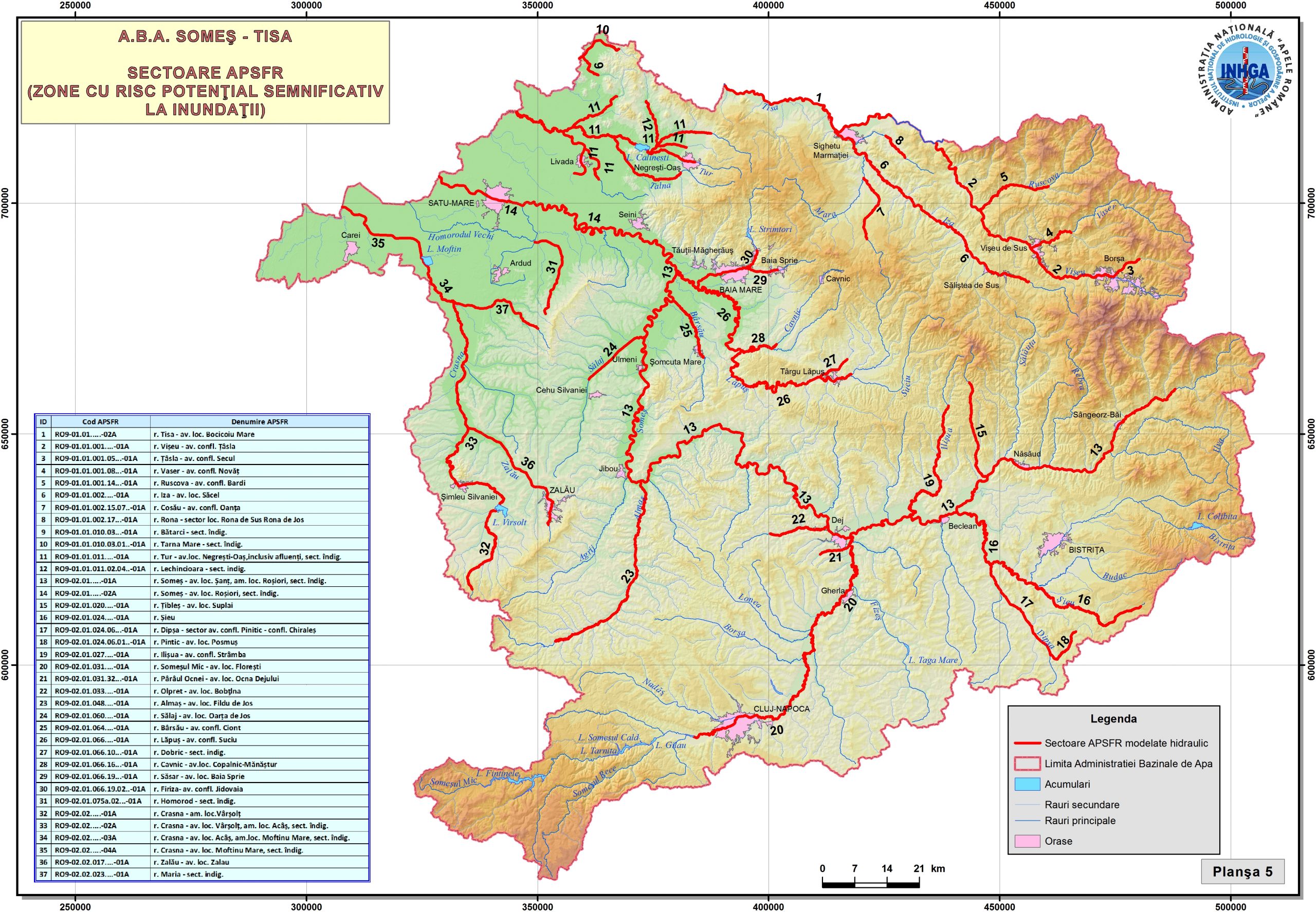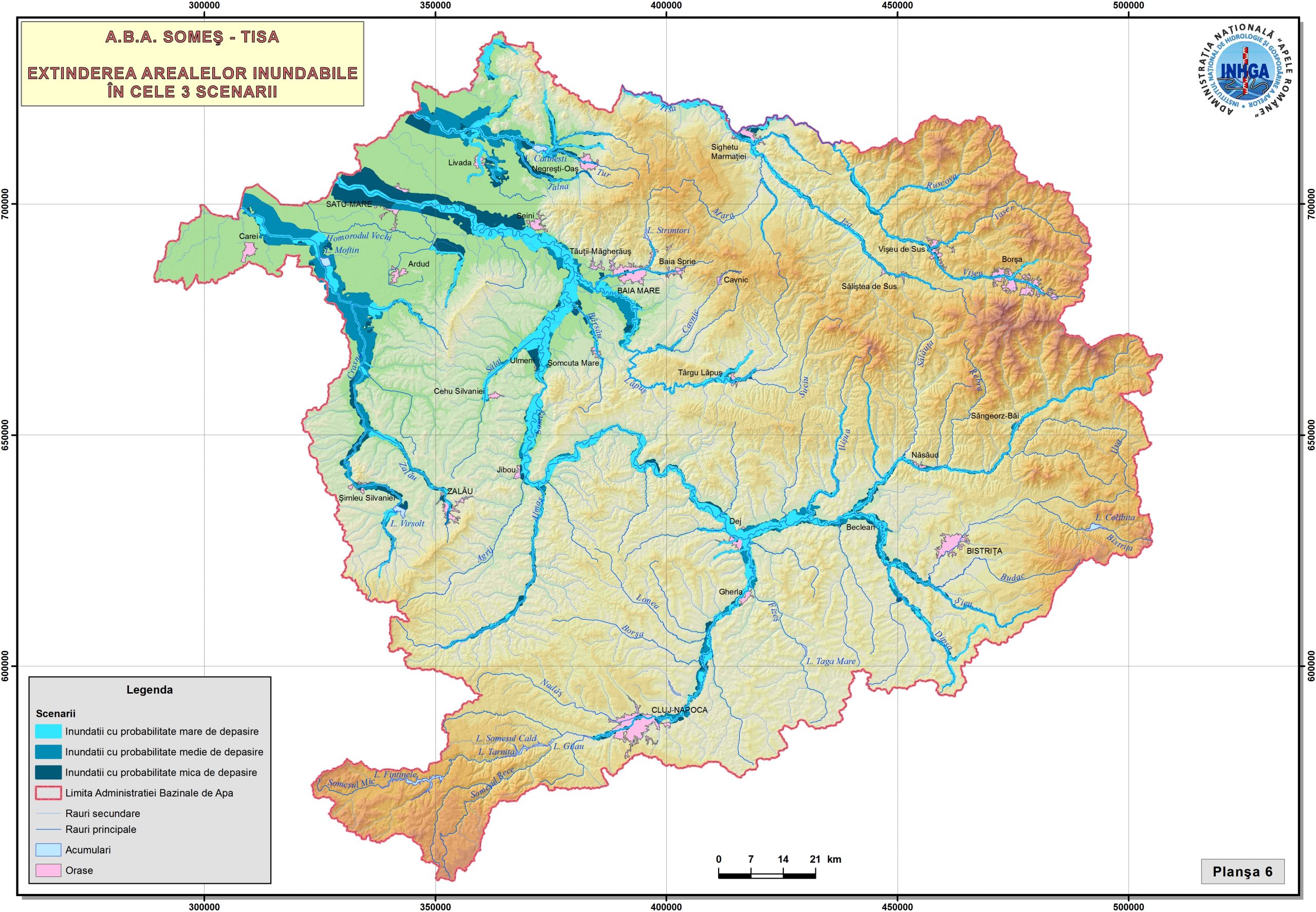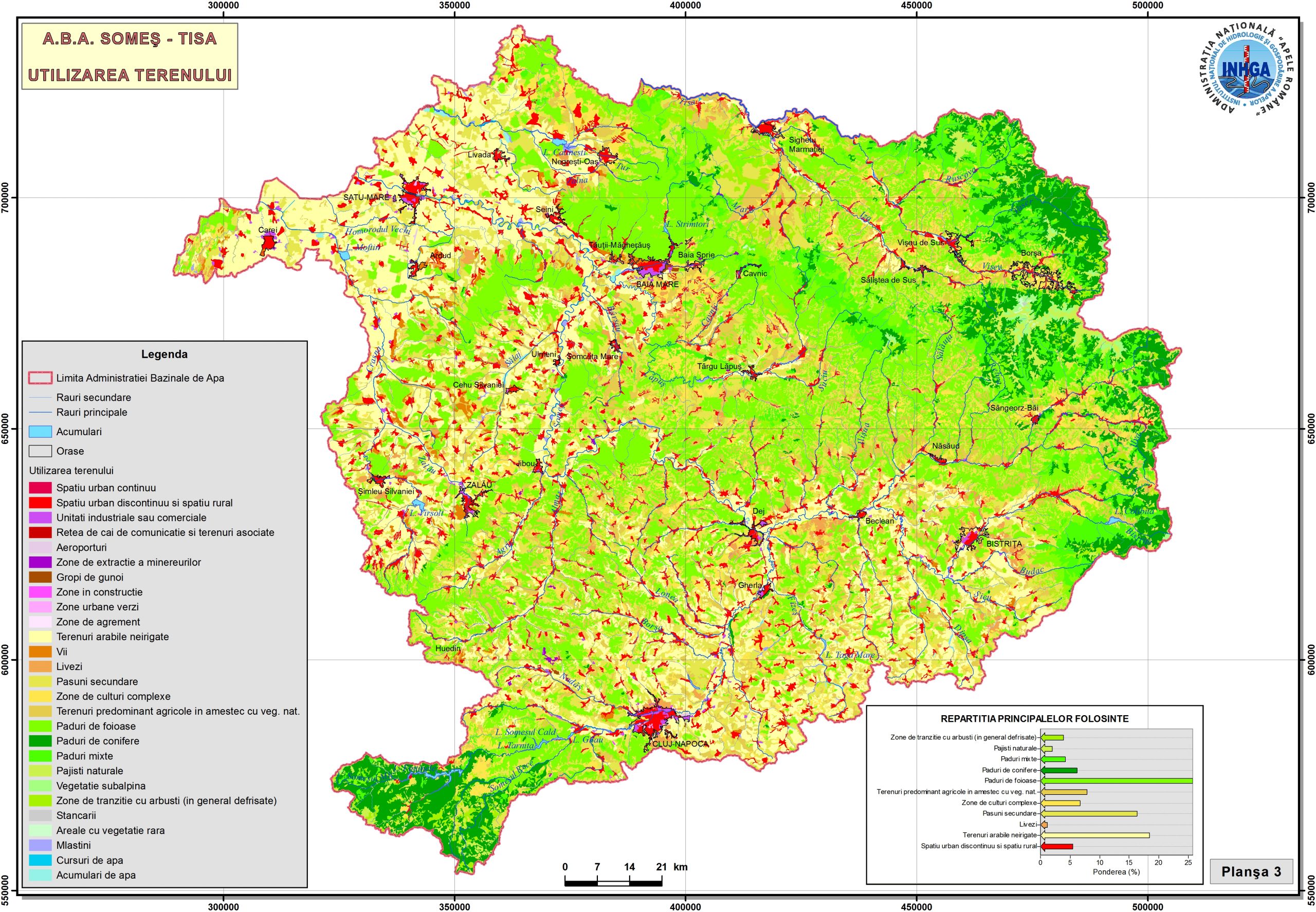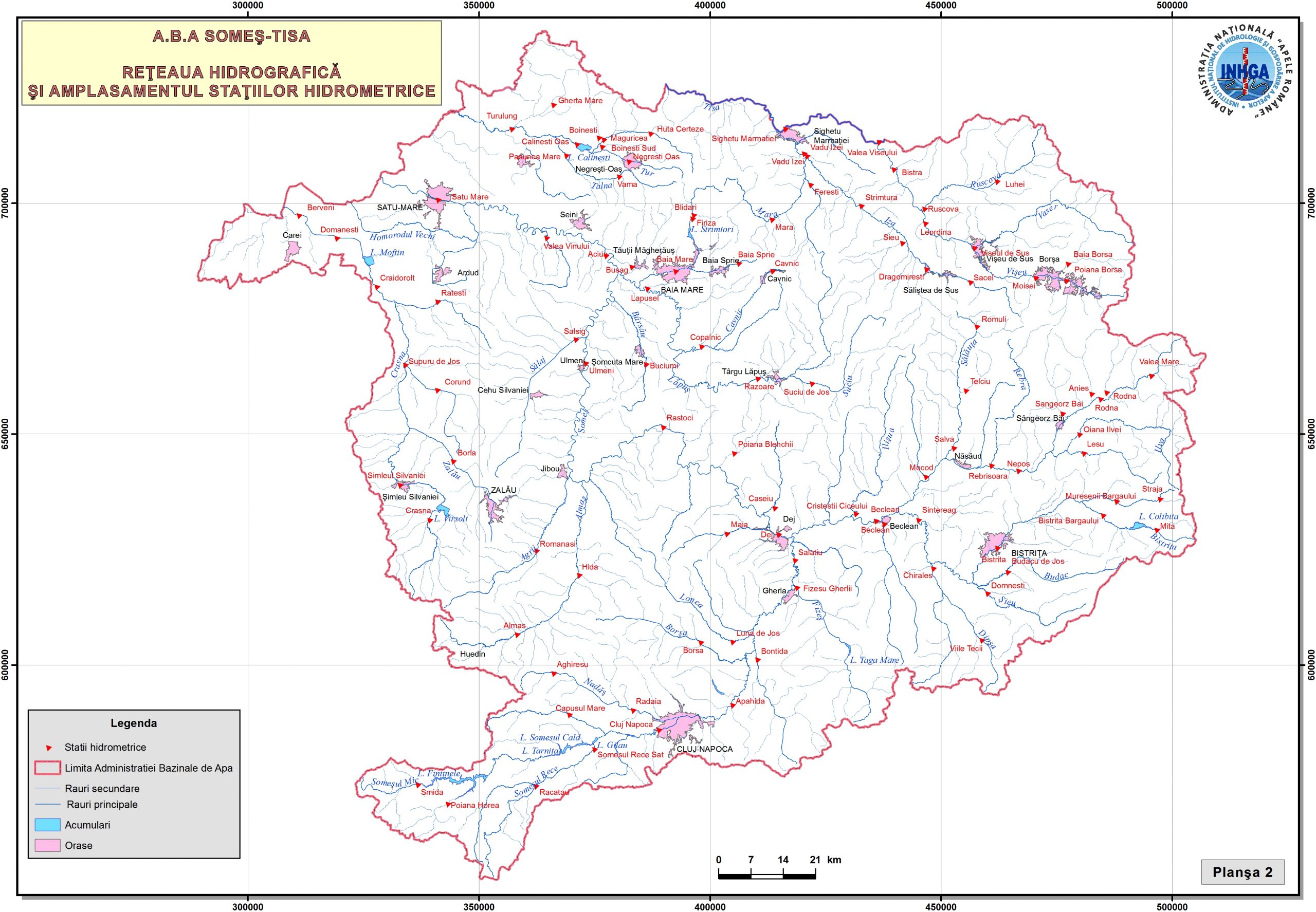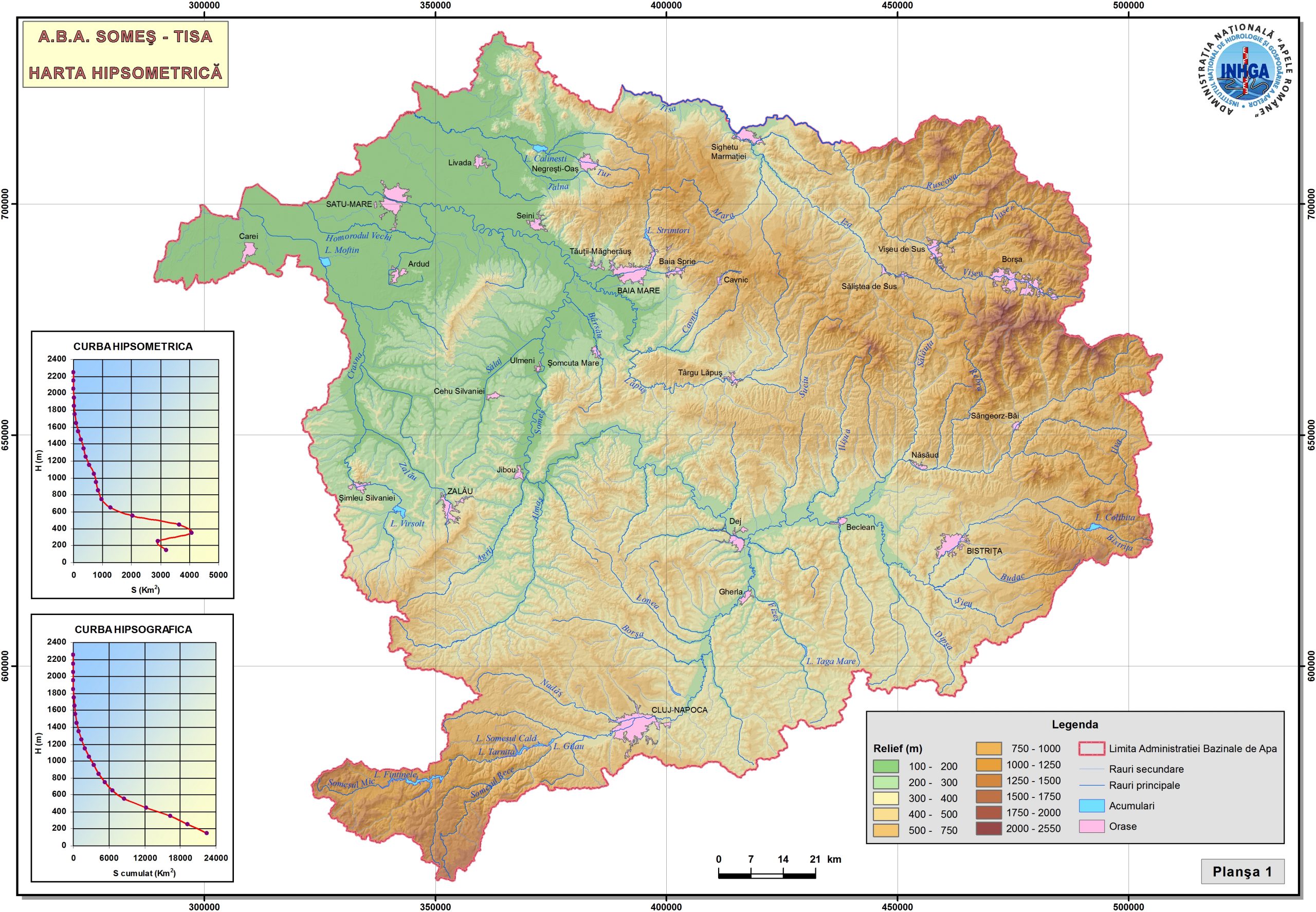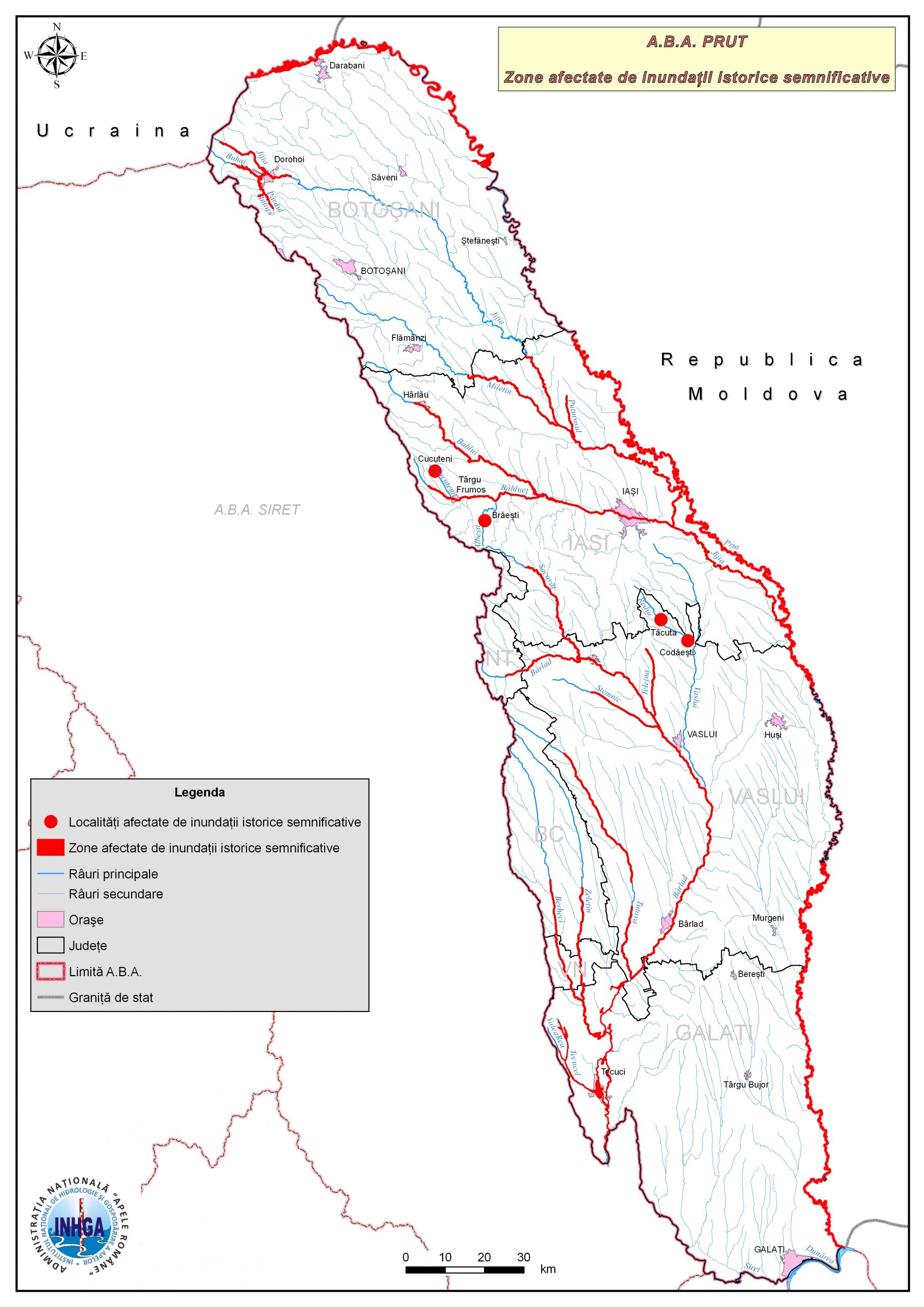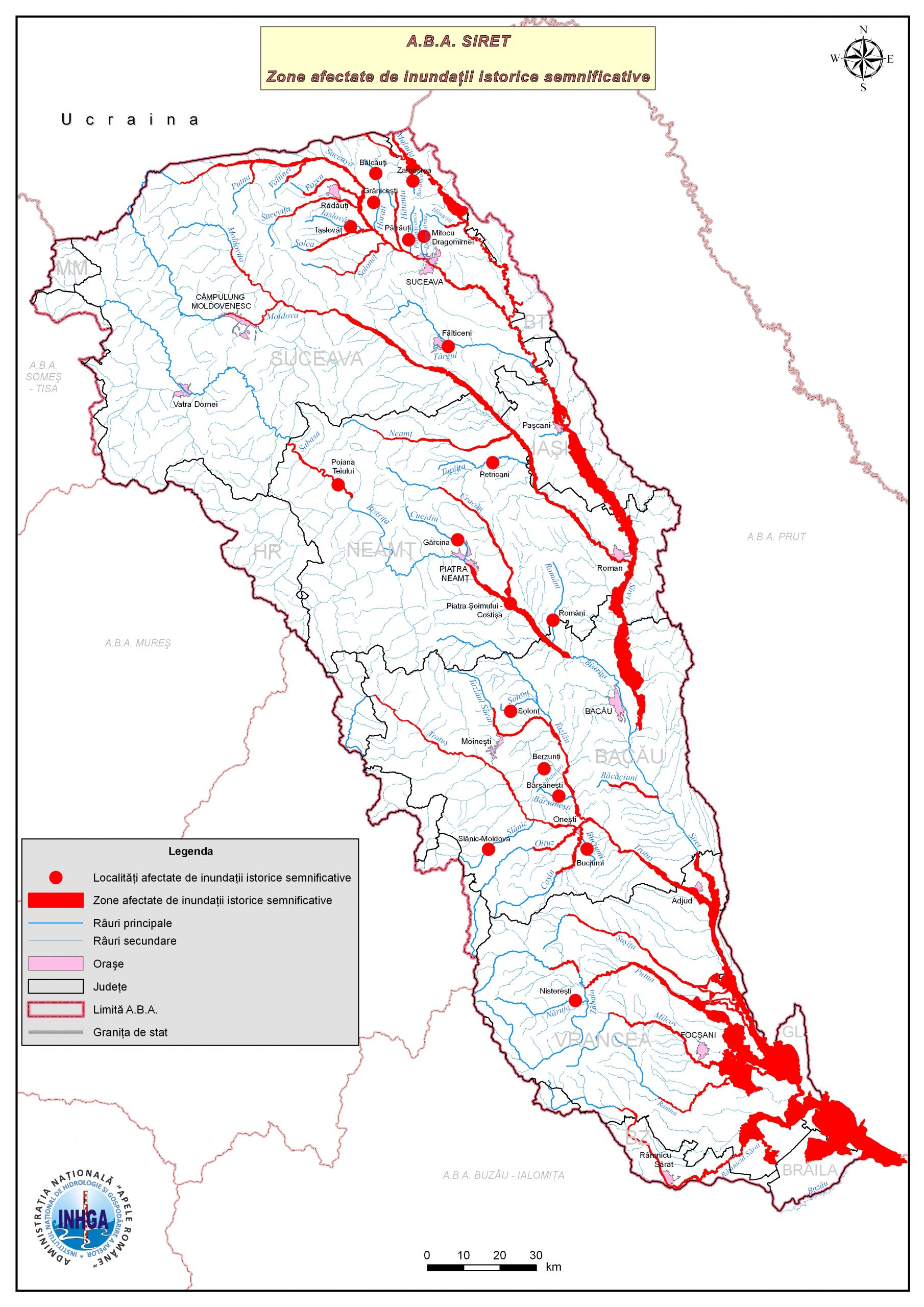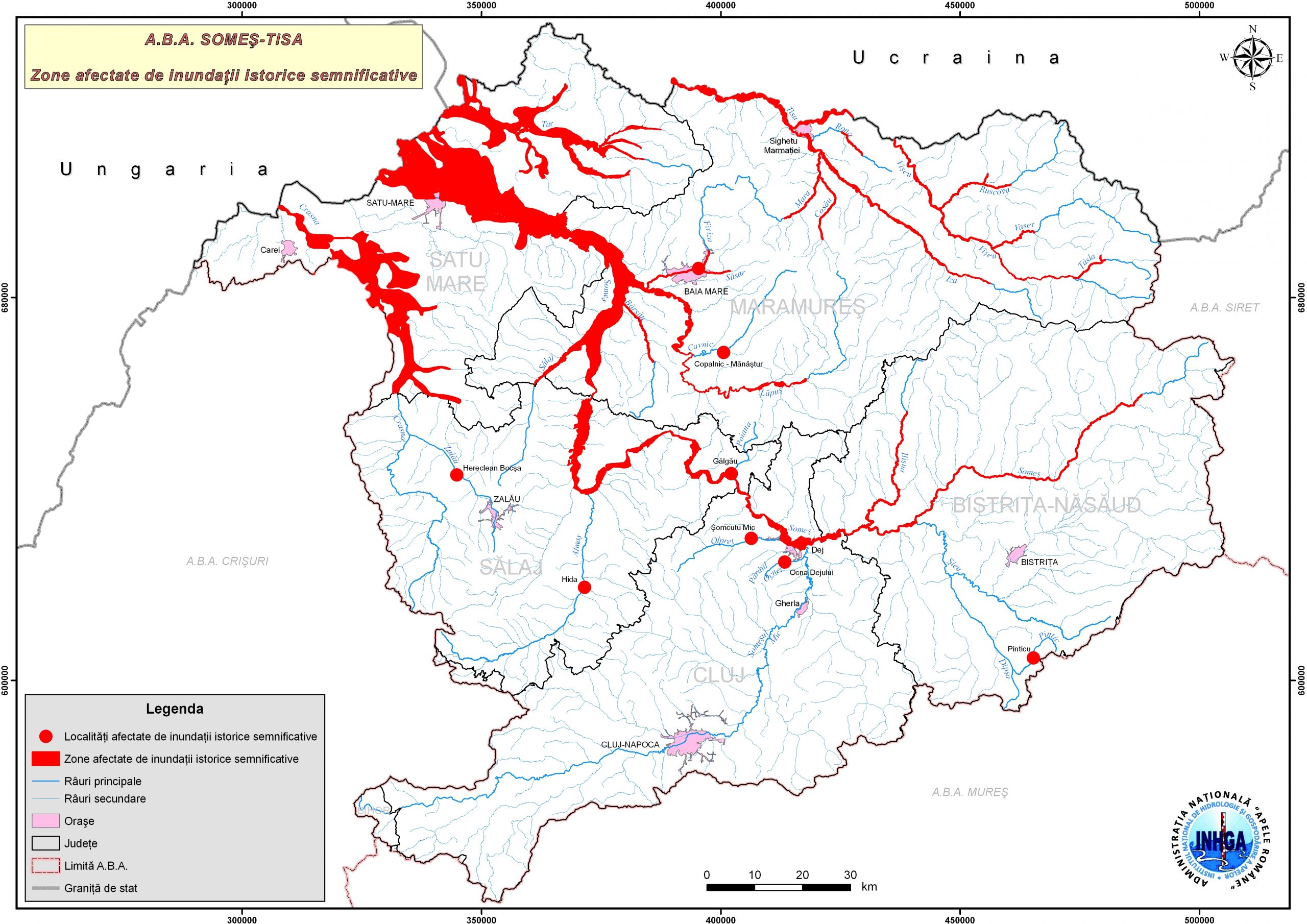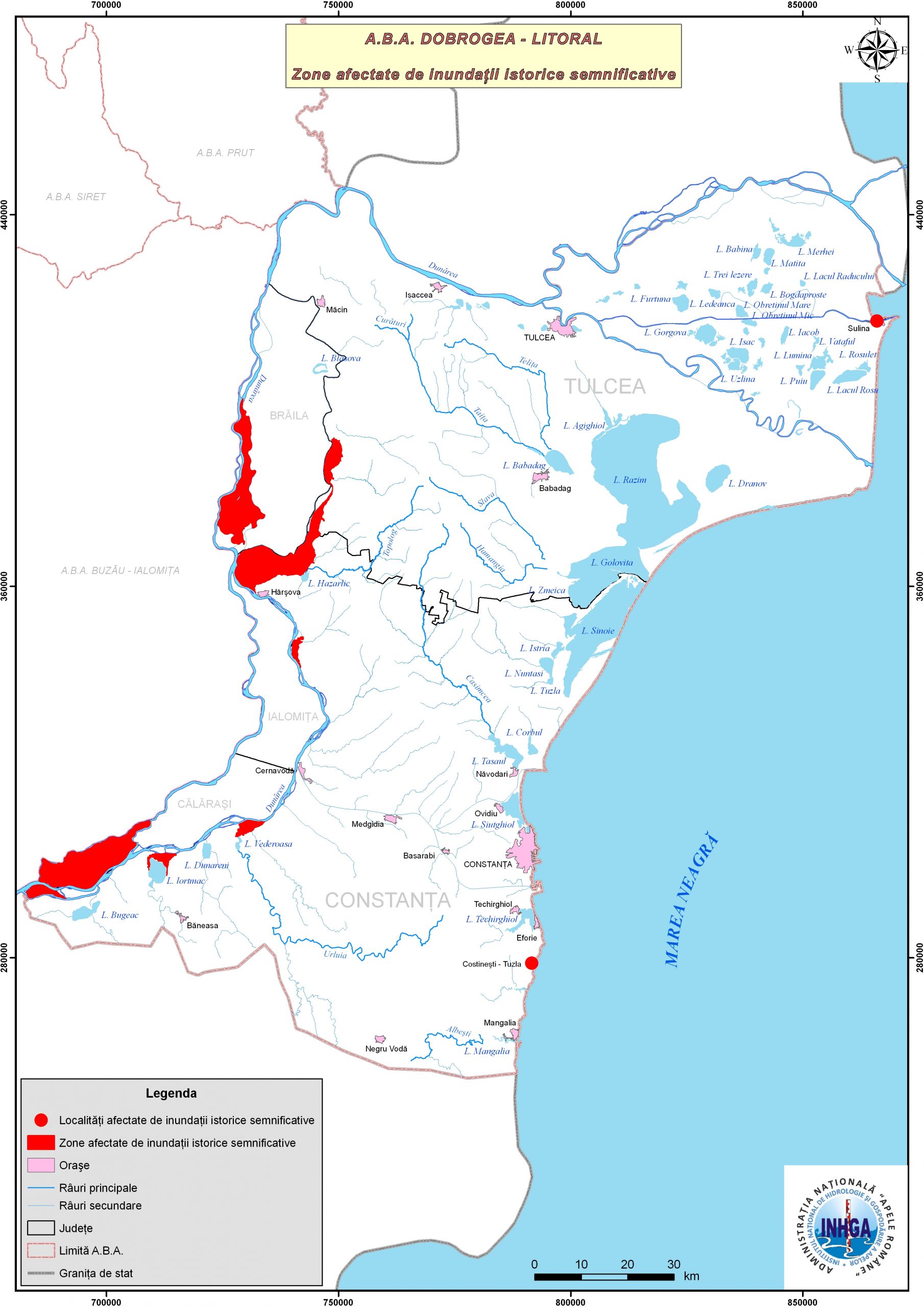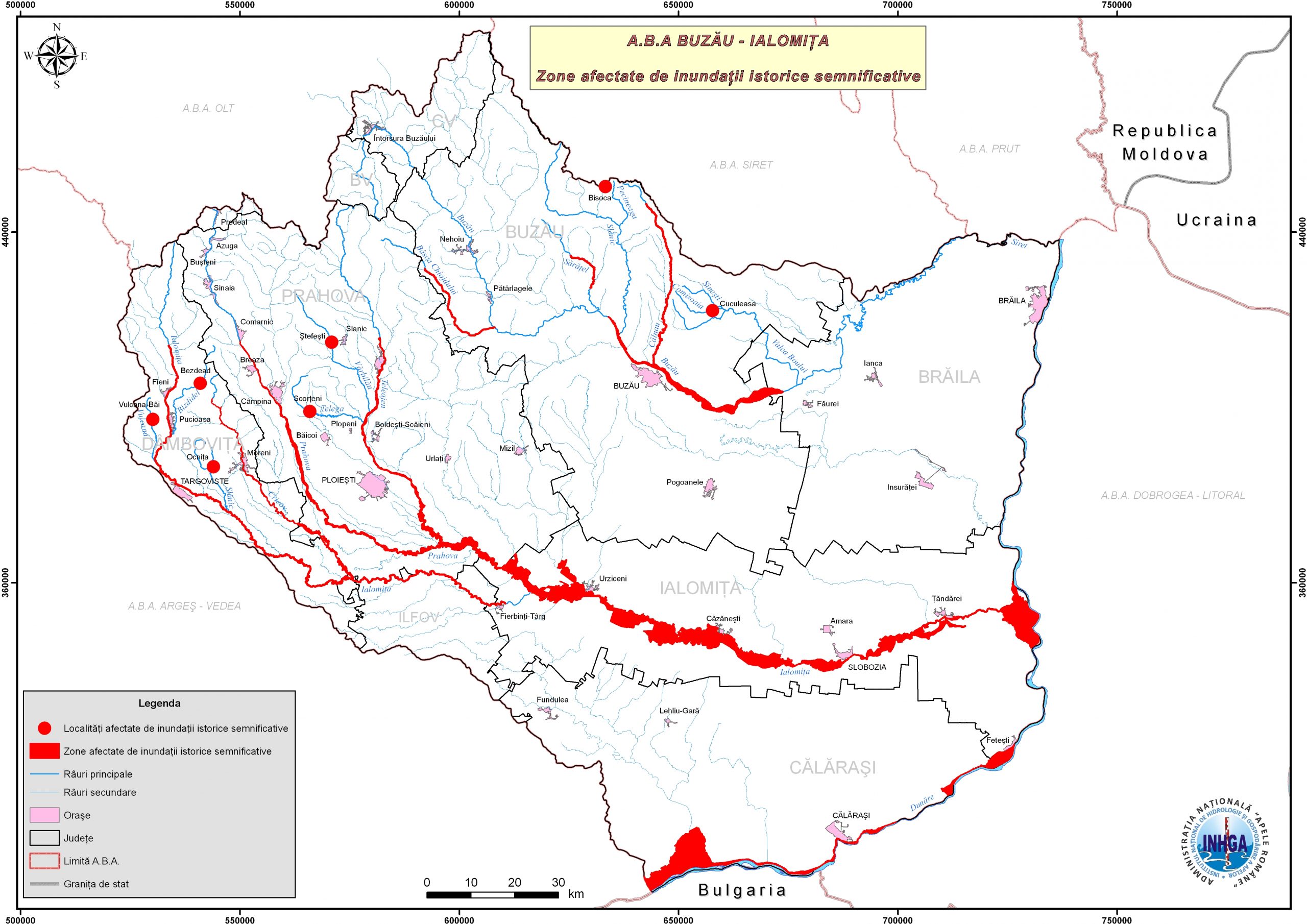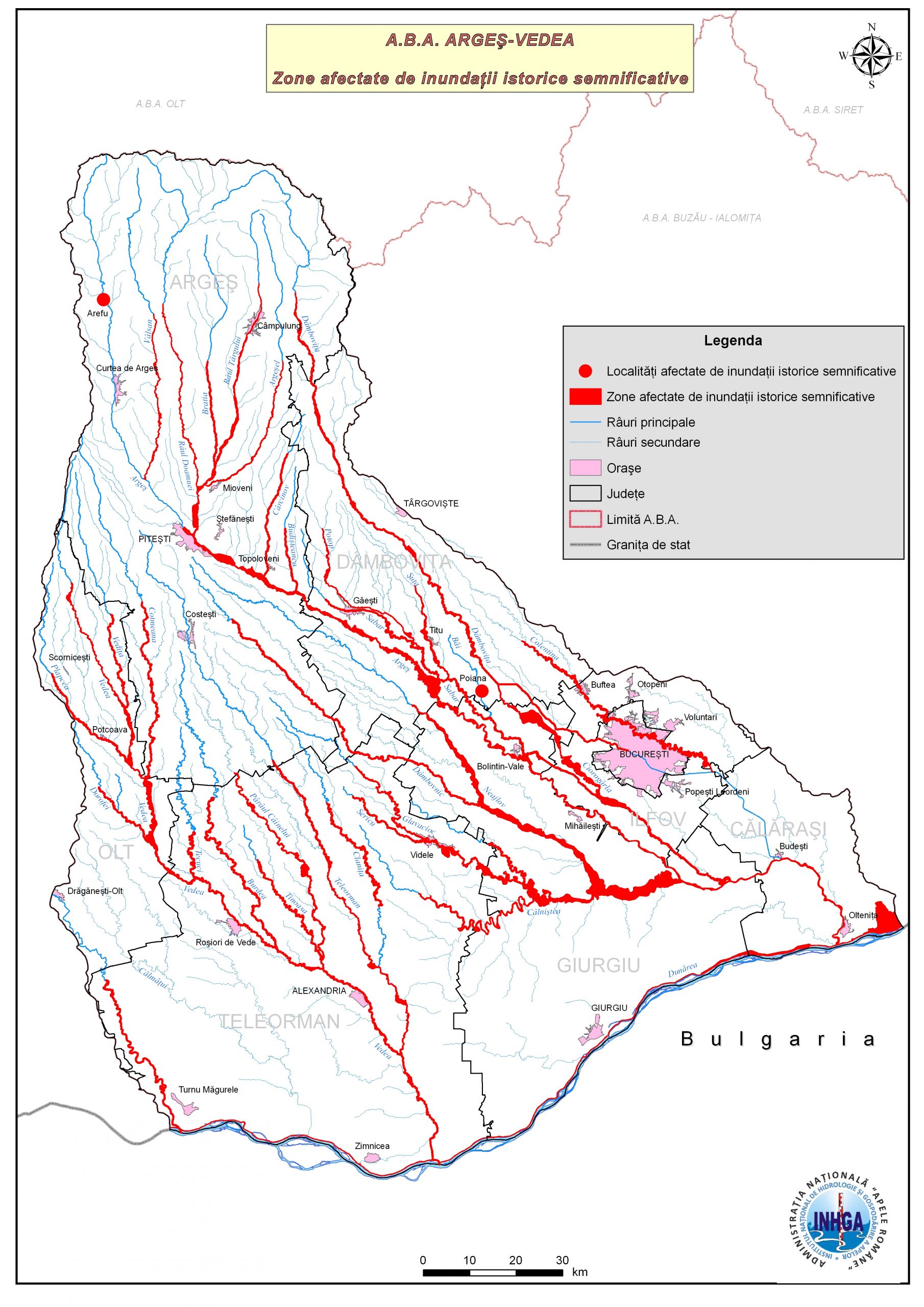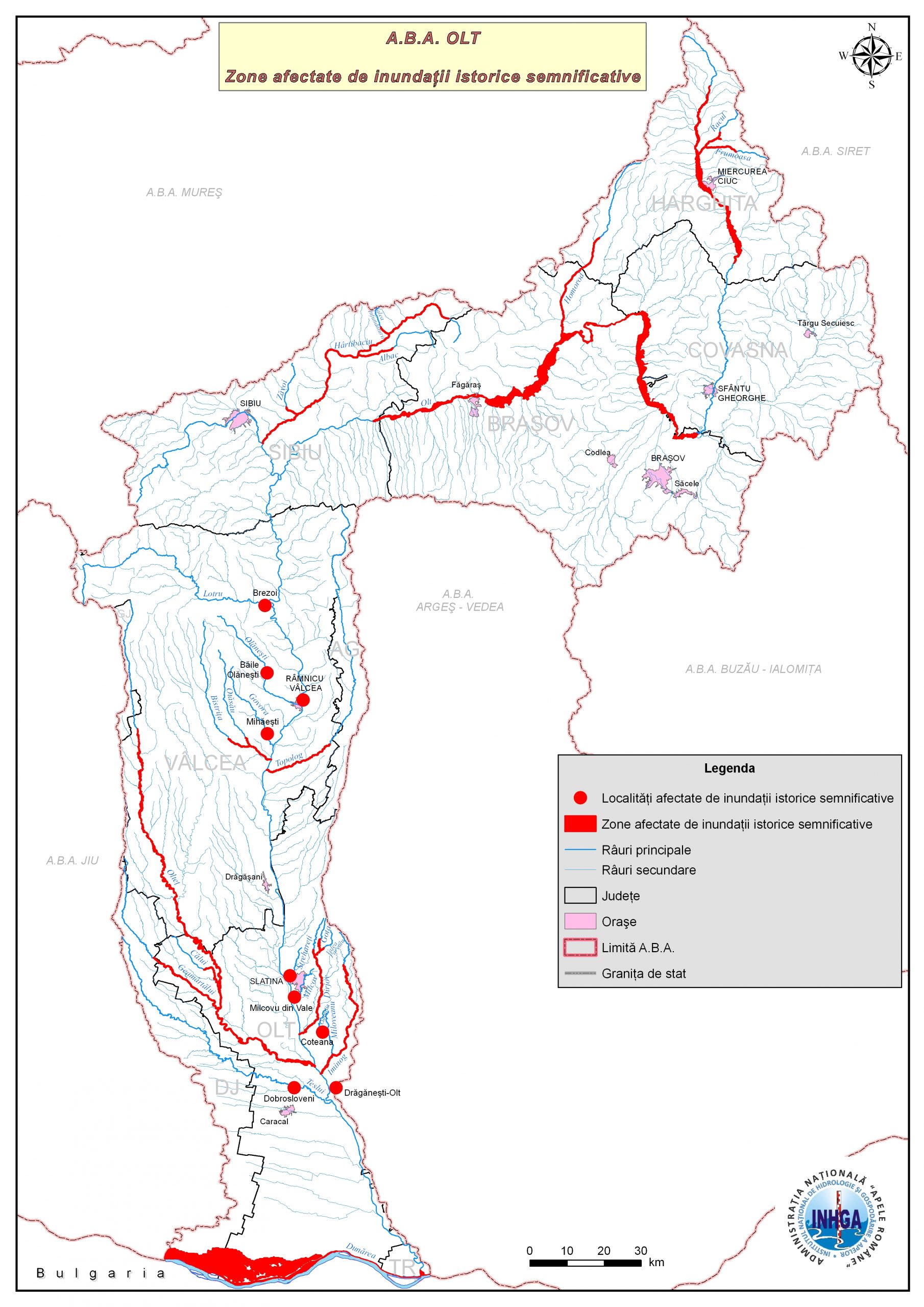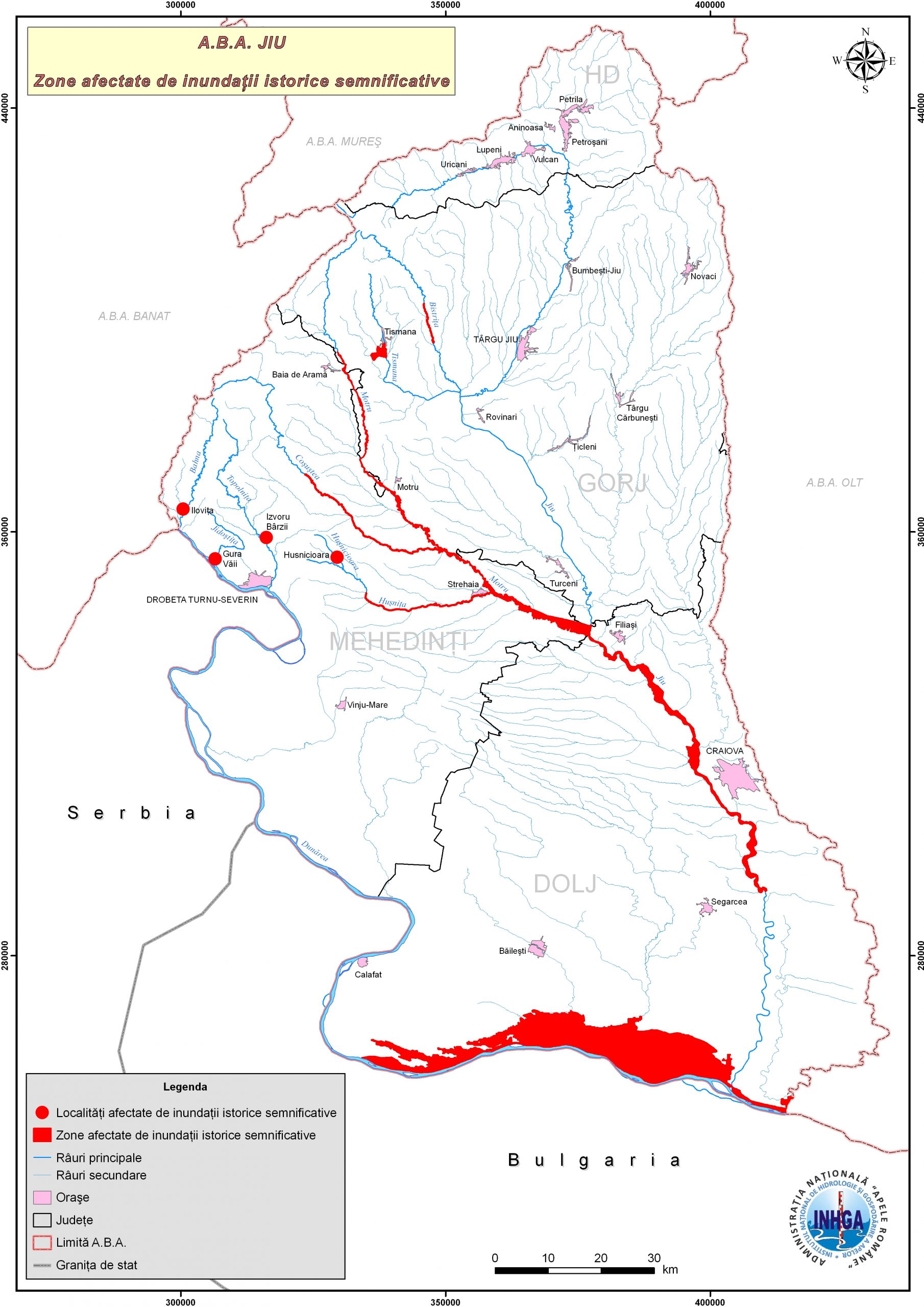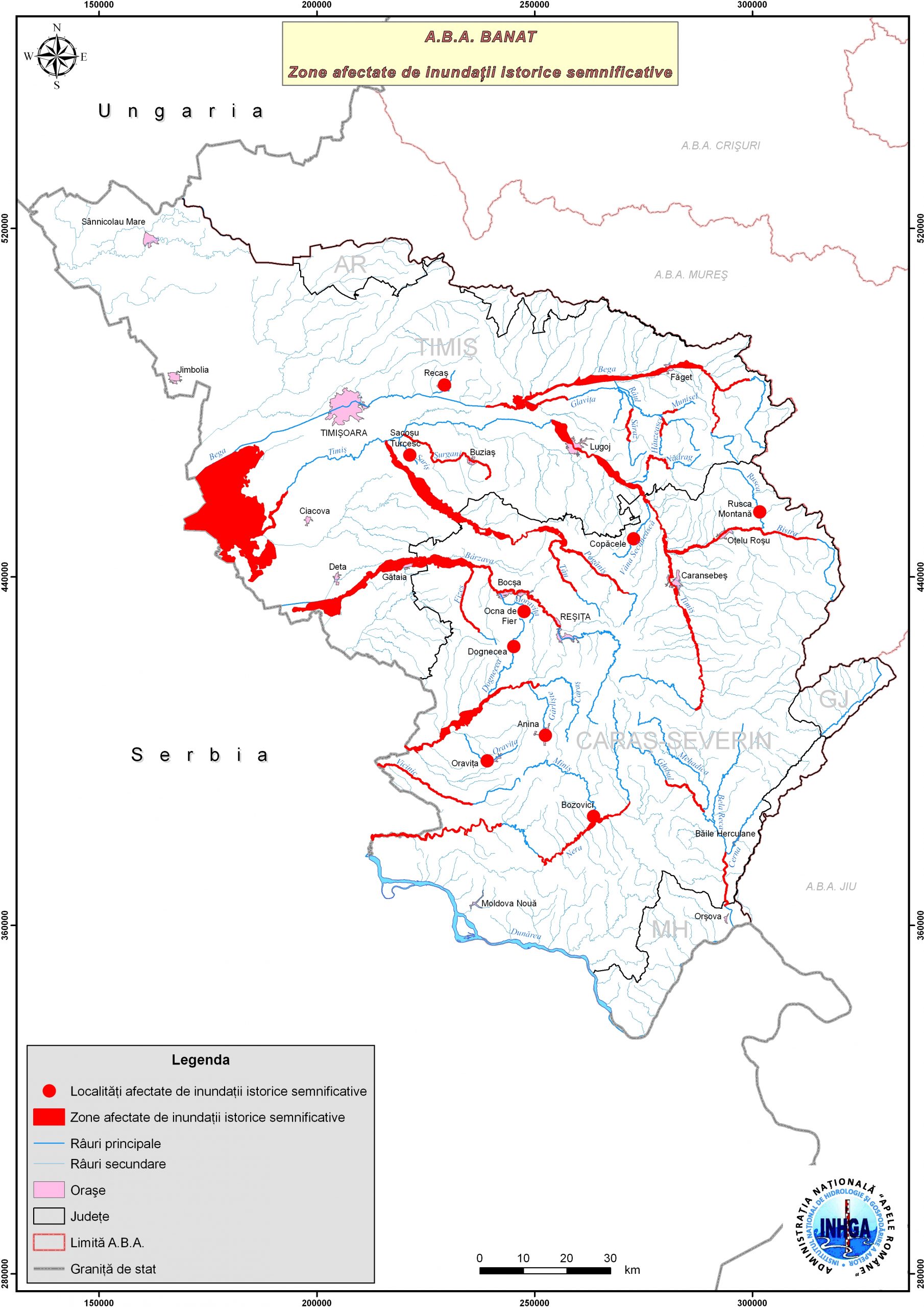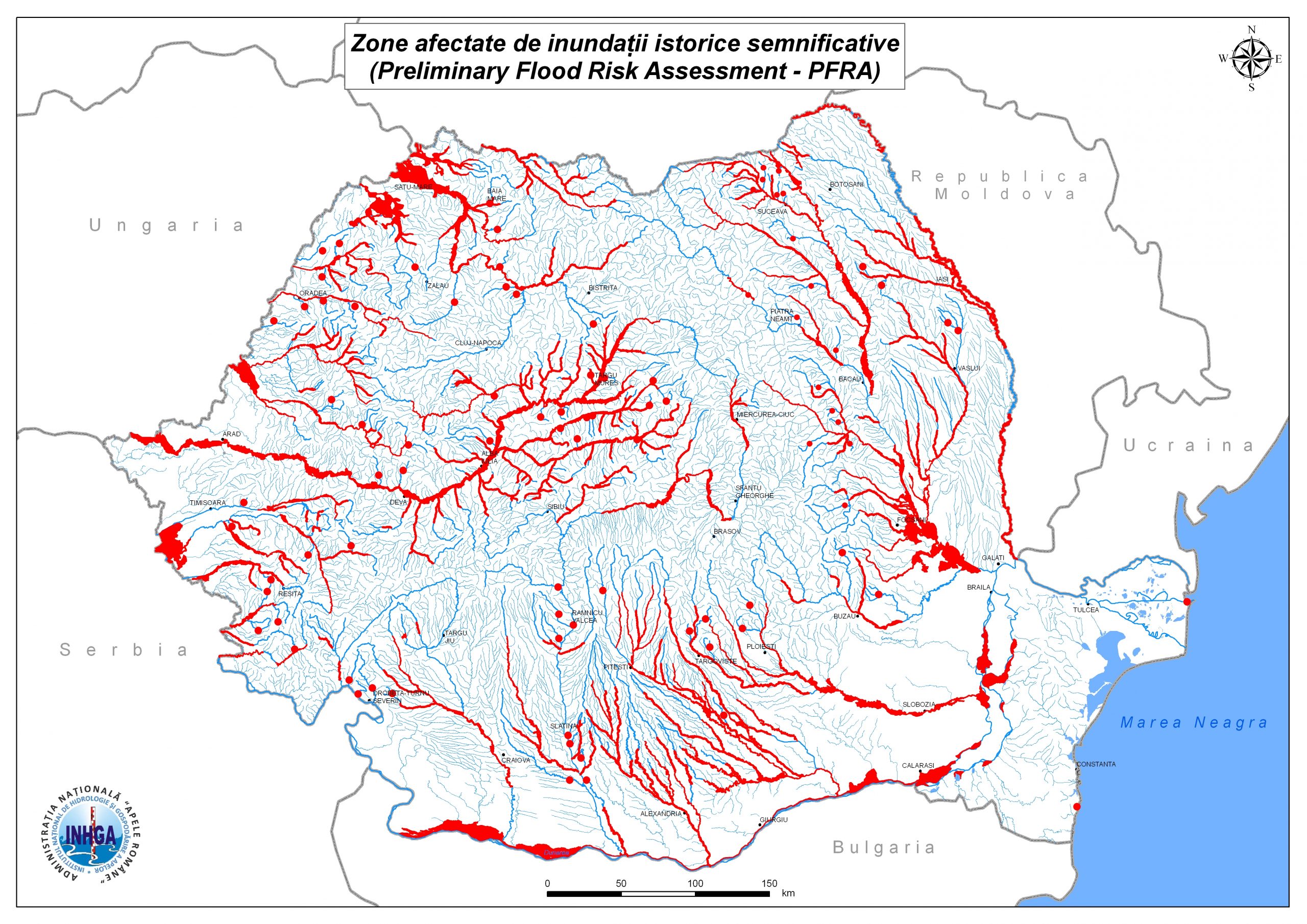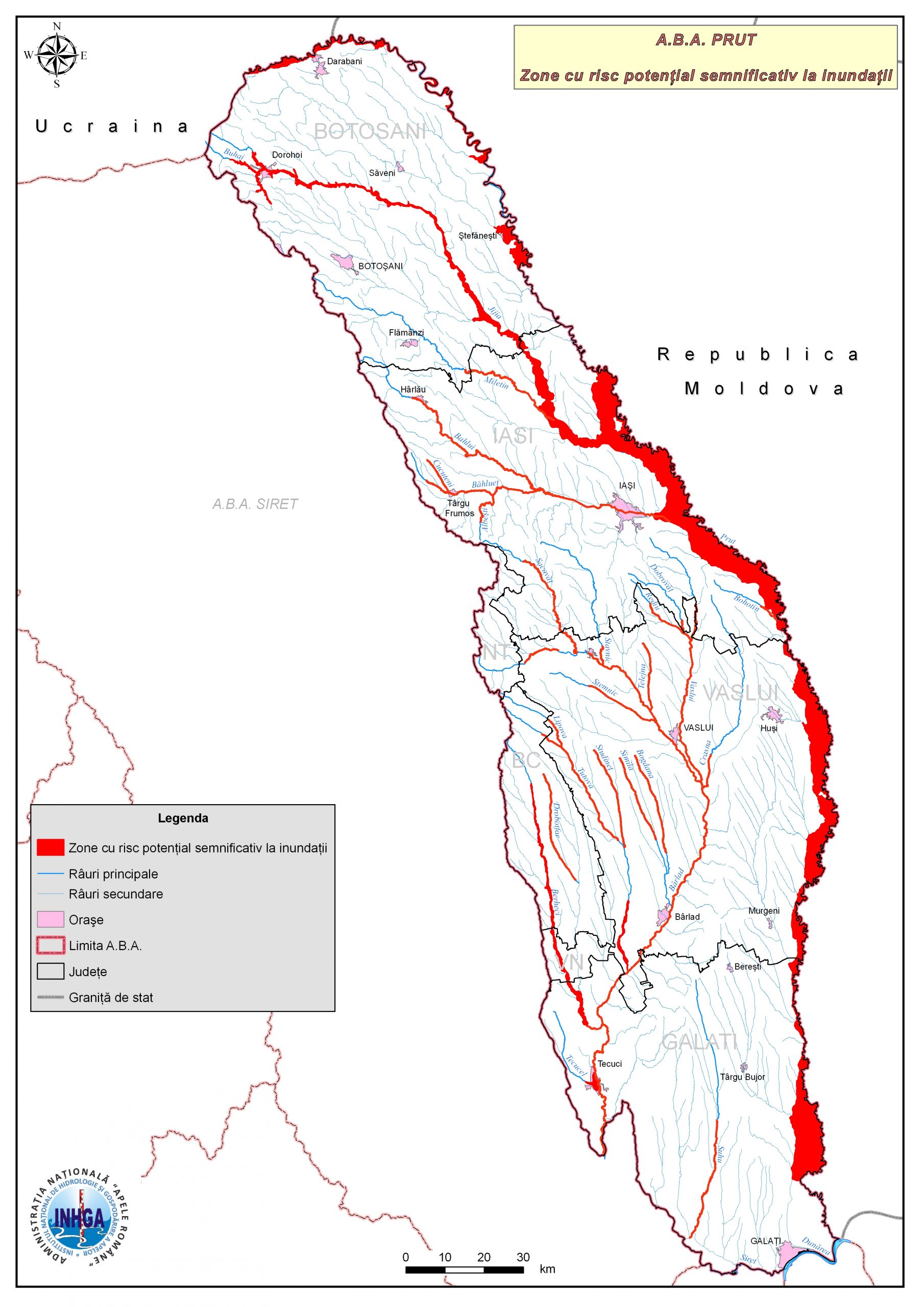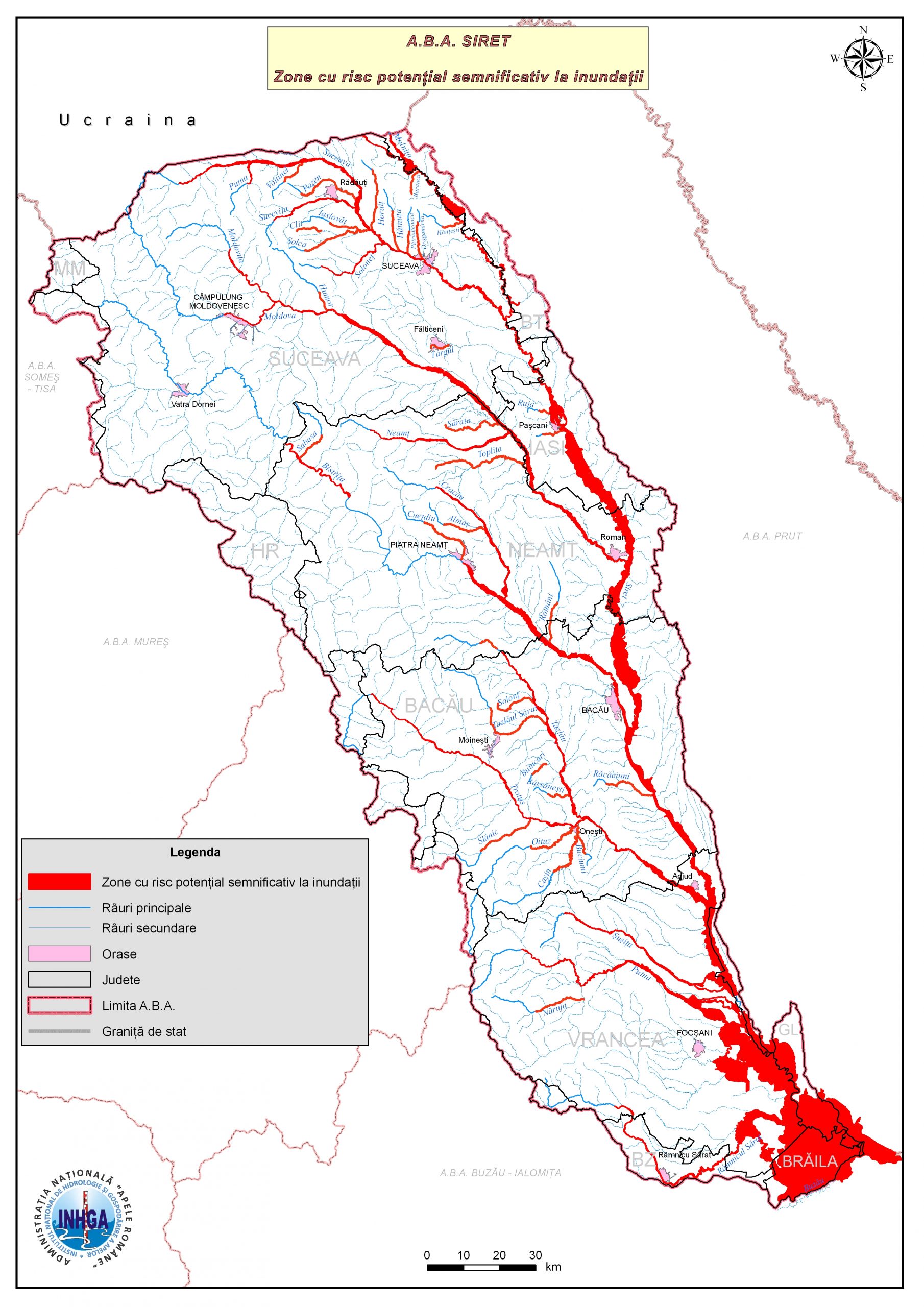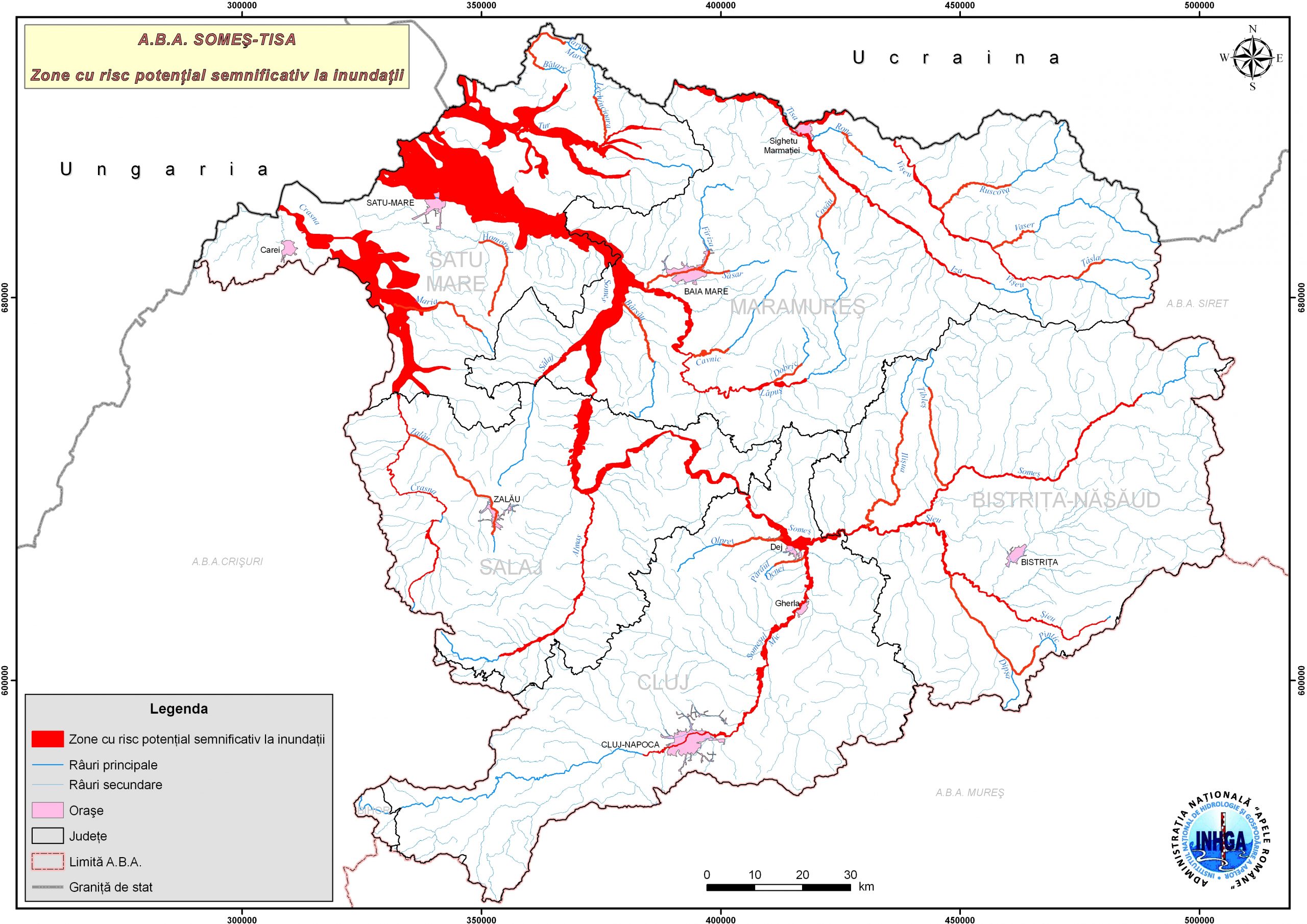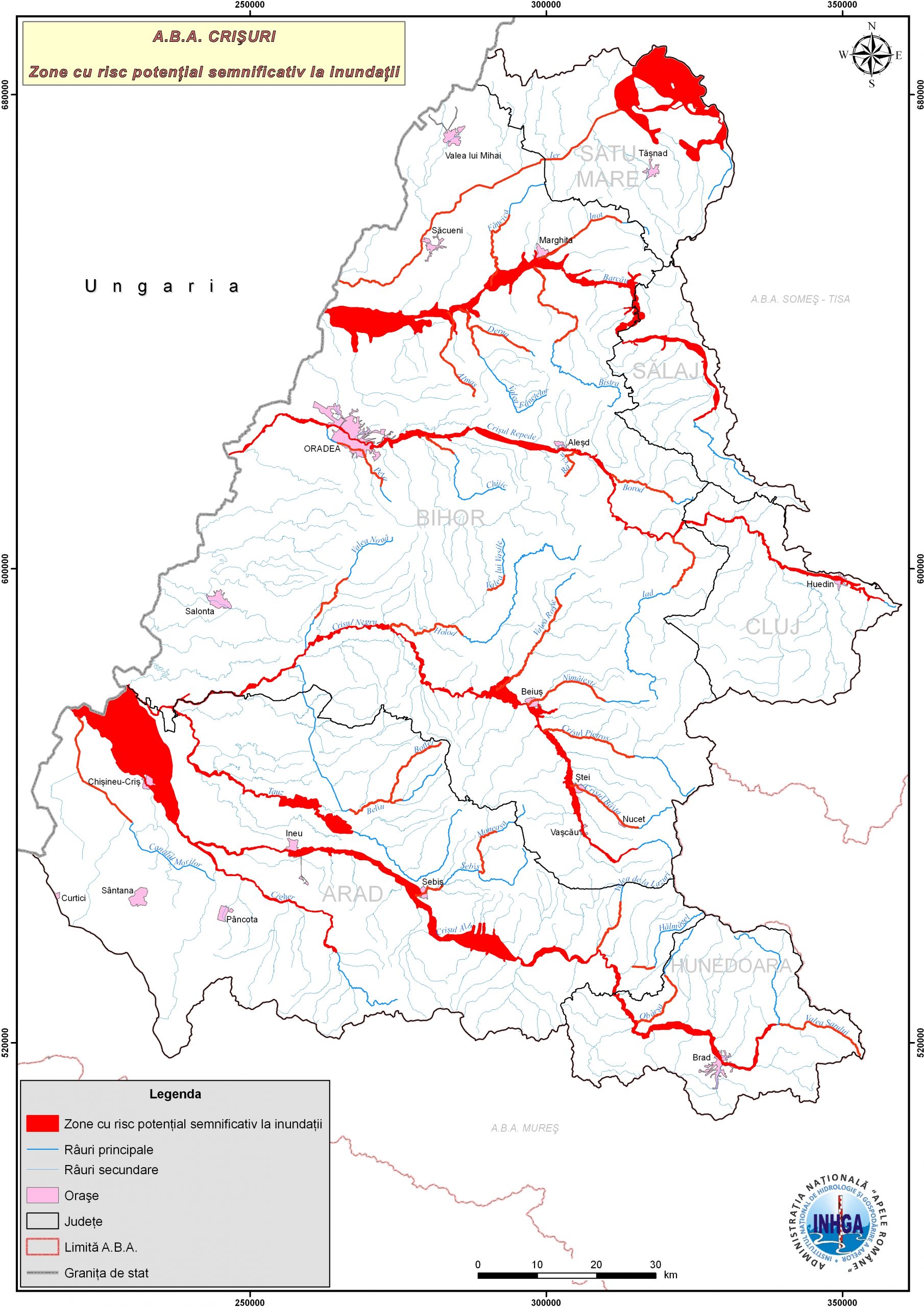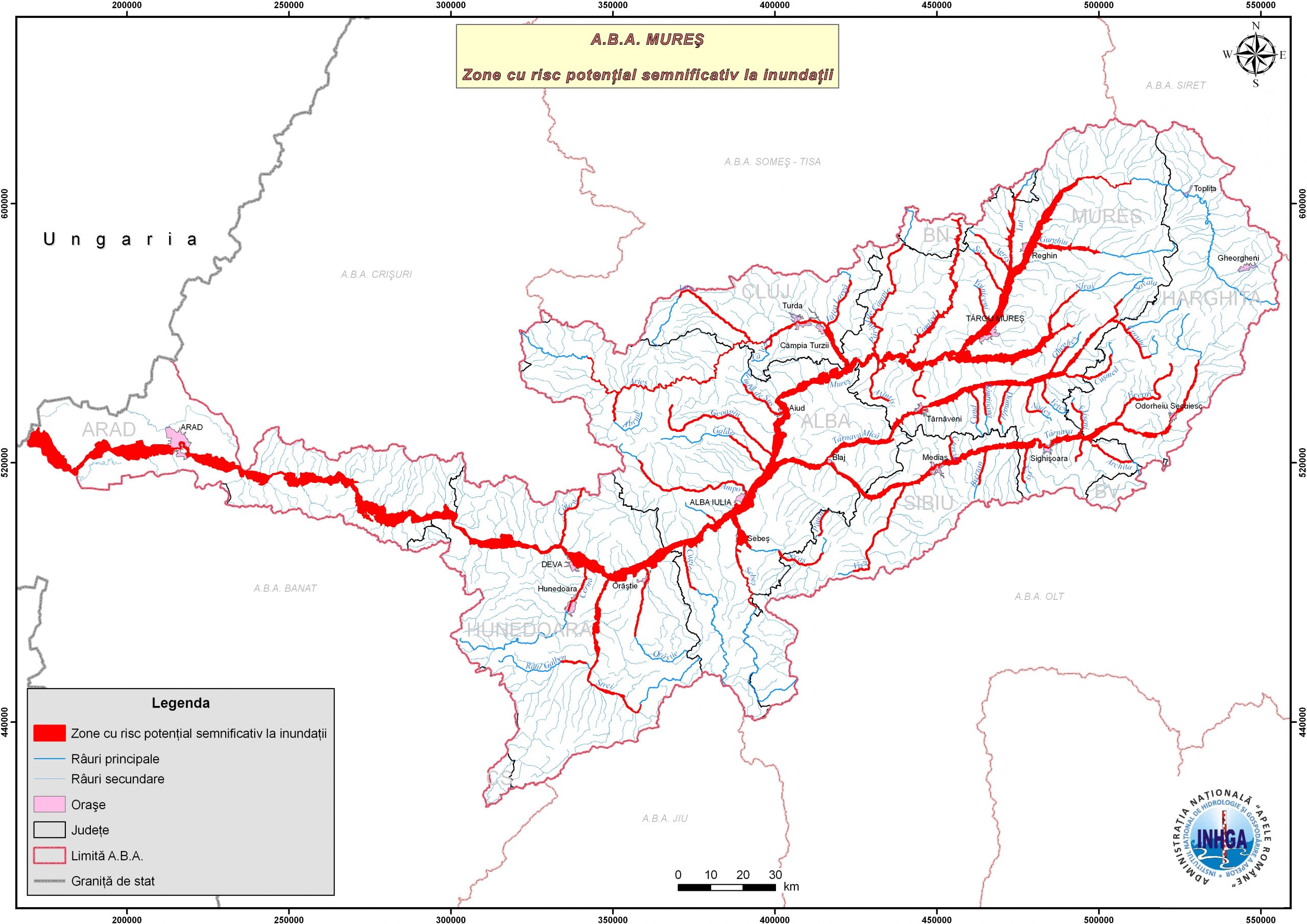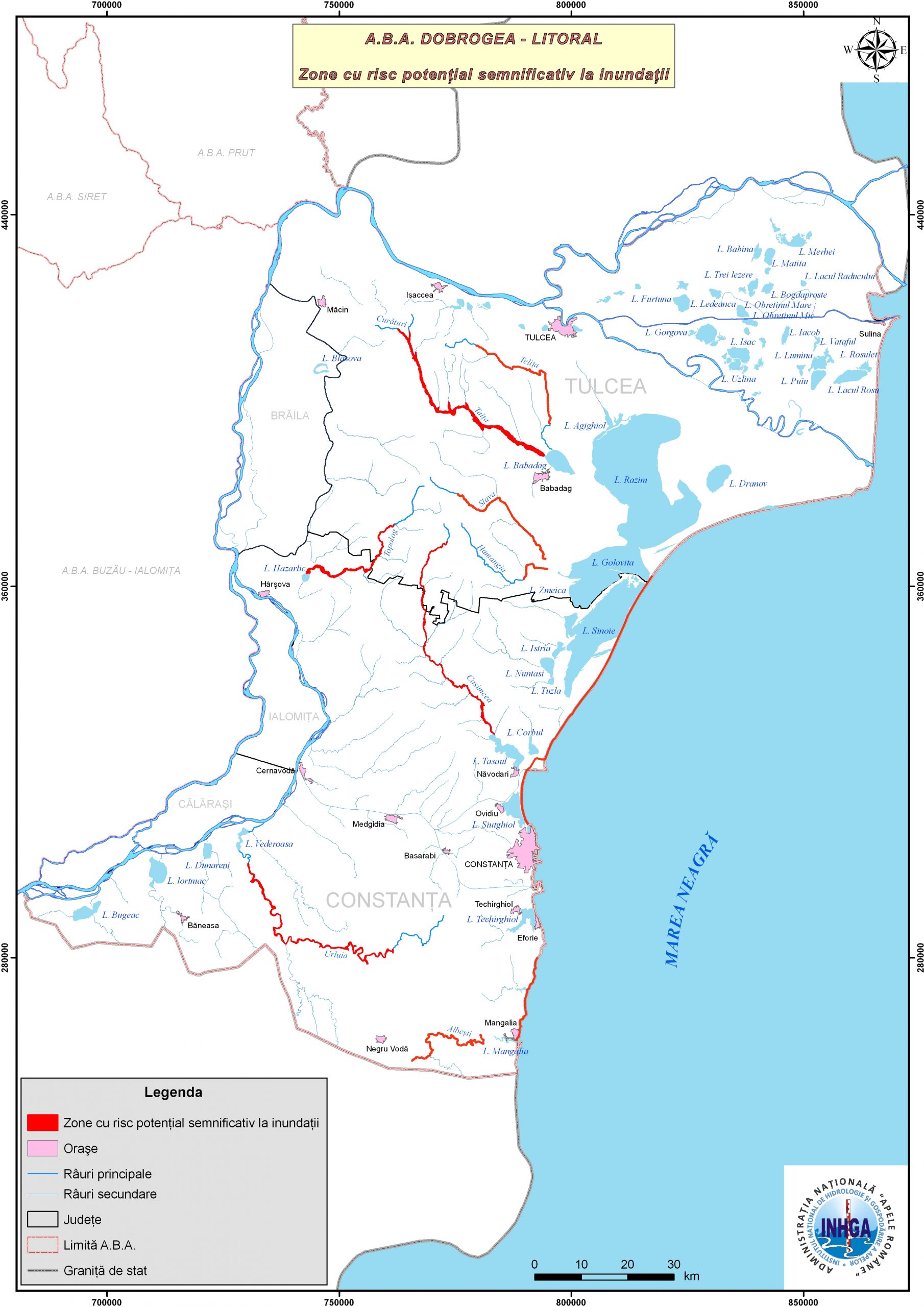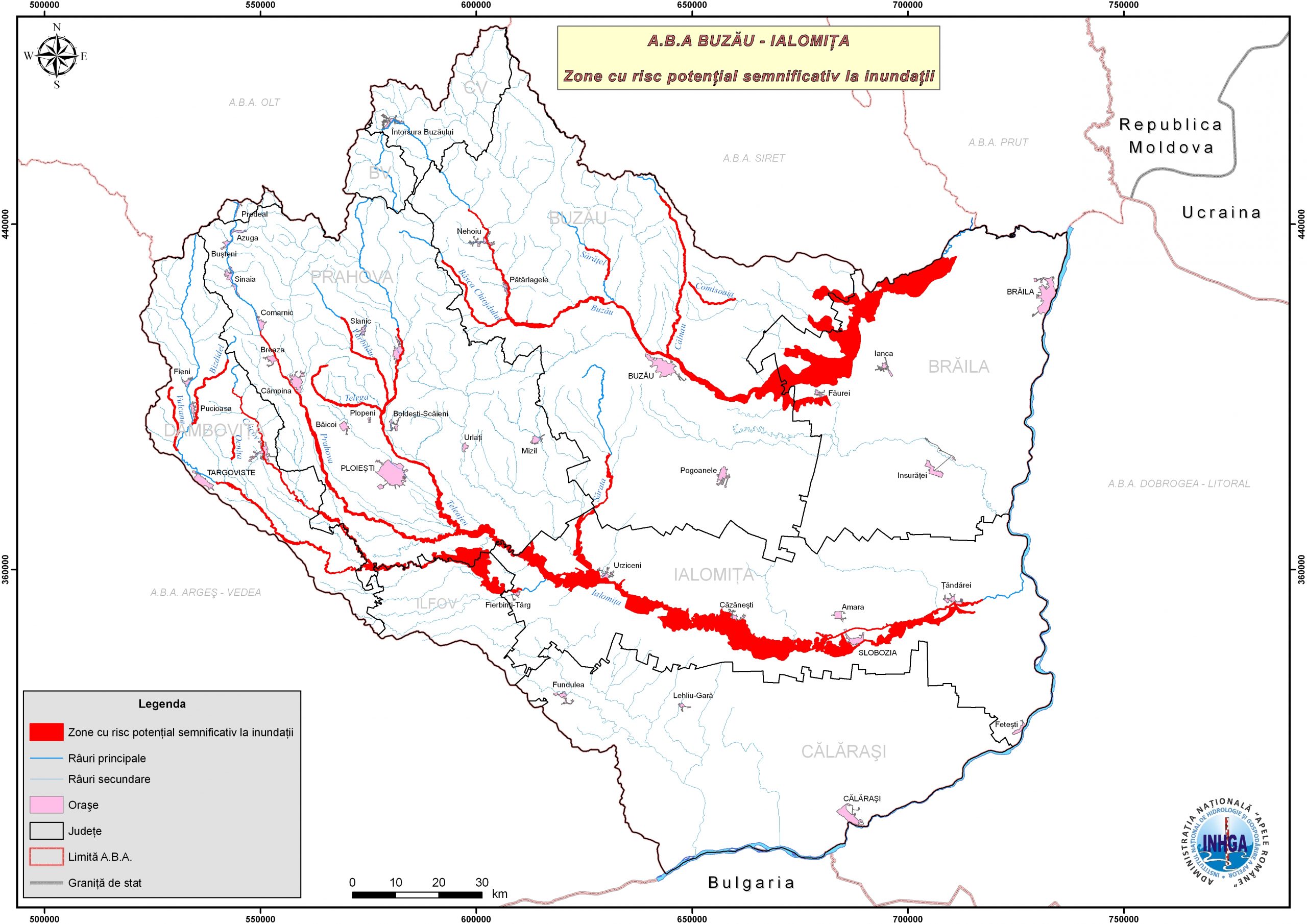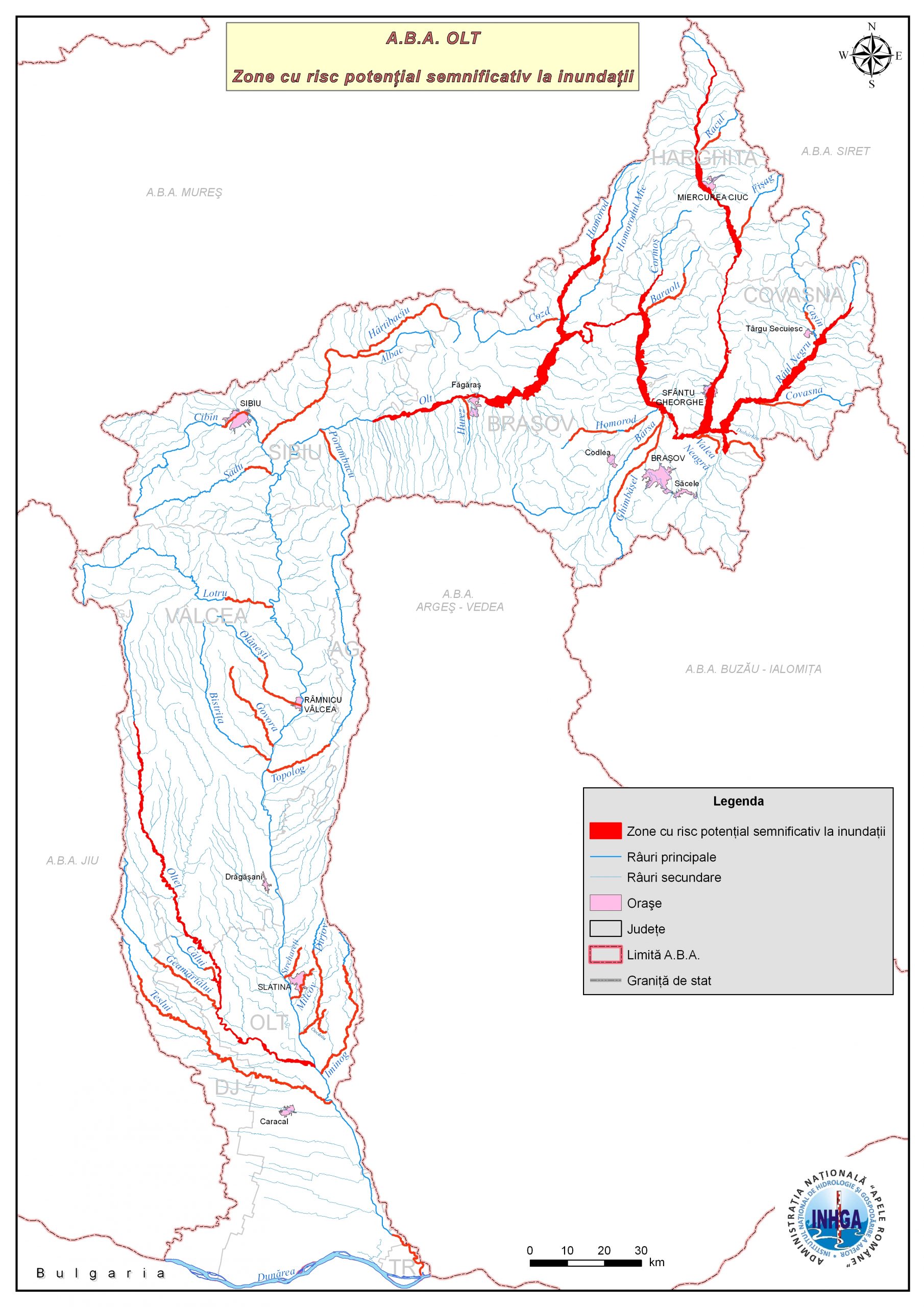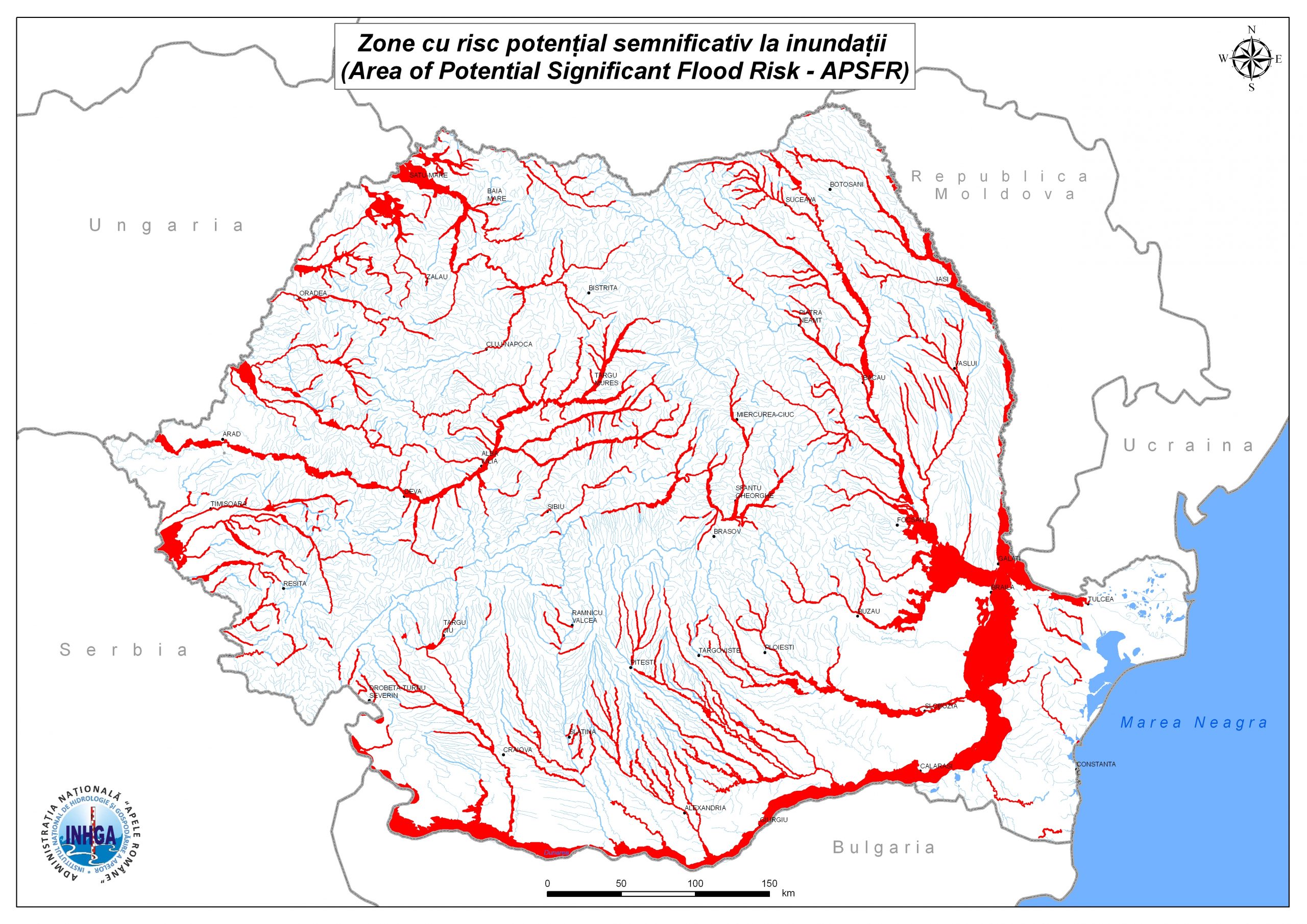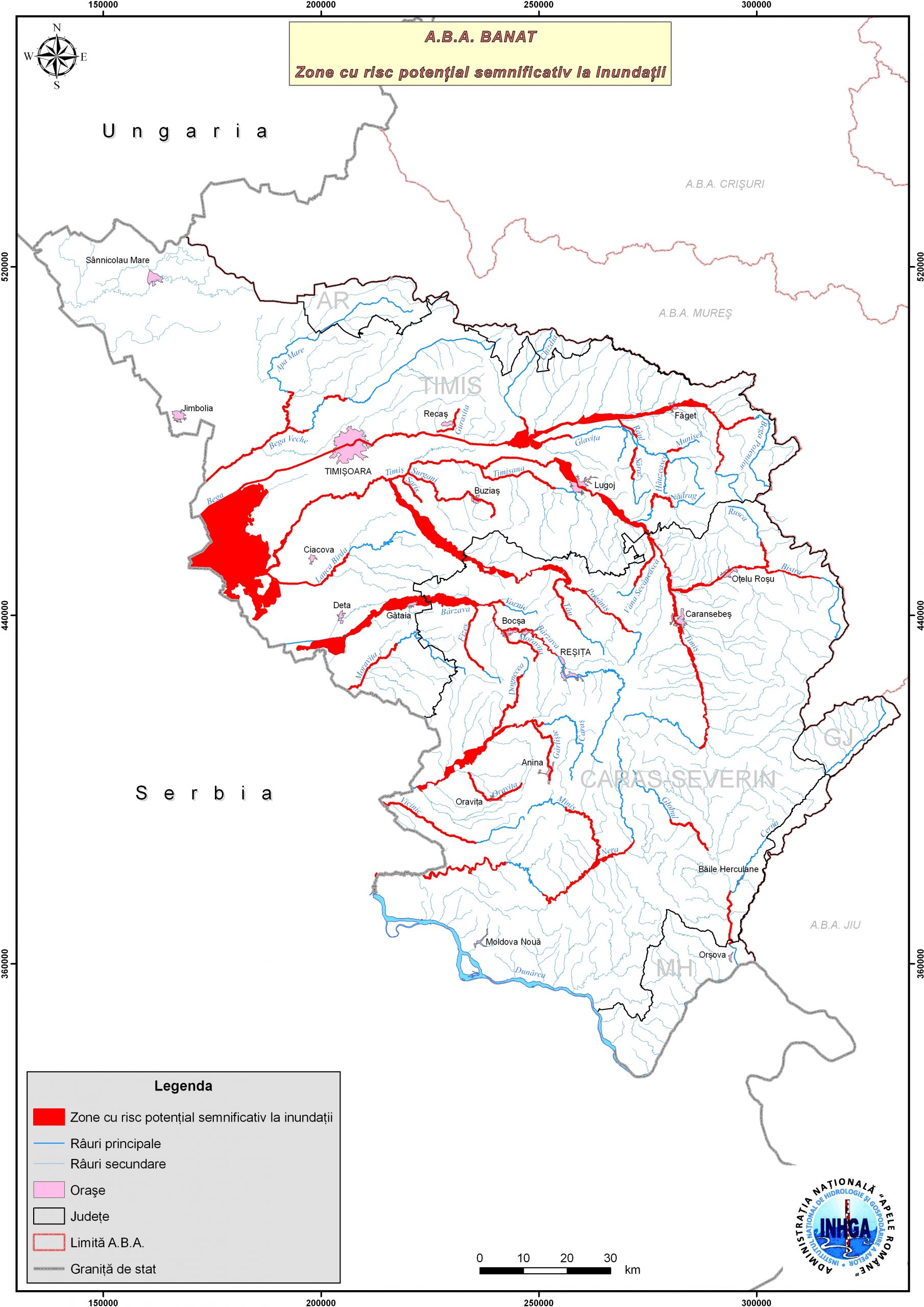Floods Directive 2007/60/EC
Description
Directive 2007/60/EC on flood risk assessment and management aims to reduce the adverse consequences for human health, the environment, cultural heritage and economic activity associated with floods. To this end, Member States are required to identify river basins and coastal areas at risk of flooding, to draw up flood risk maps and to draw up flood risk management plans for those areas.
The primary information on floodplains was made by the Basin Water Administrations, through the Flood Defense Offices under the technical coordination of the National Institute of Hydrology and Water Management (INHGA), which prioritized, selected and validated the information provided from the territory.
All tabular and GIS data were produced in accordance with the requirements of the Floods Directive 60/2007/EC, using the methodologies developed by INHGA. This data is also included in county-level defense plans.
Legislative basis
Statistically analysed directive
Among the natural phenomena that cause victims and negatively affect human activities, floods are those which, by their proportions and frequency, have the most serious consequences. The 39 selected nationally significant historical events resulted in 237 casualties, averaging approximately 6.6 victims per event. A graphical representation of victims and the number of national events recorded by each Basin Administration is shown in figure 1.

Figure 1. Graphical representation of the number of significant national events and associated victims, by Basin Water Administration
Among the natural phenomena that cause victims and negatively affect human activities, floods are those which, by their proportions and frequency, have the most serious consequences. The 39 selected nationally significant historical events resulted in 237 casualties, averaging approximately 6.6 victims per event. A graphical representation of victims and the number of national events recorded by each Basin Administration is shown in figure 1.

Figure 2. Distribution of APSFR areas by Basin Water Administrations
Flood hazard and risk maps
We mention that the maps presented are of general interest, for information purposes; For investment promotion activities, design, etc. in-depth studies are required at local level. We also draw attention to the fact that these maps were drawn up only for certain areas/sectors (areas with potentially significant flood risk, within the meaning of Directive 2007/60/EC), and failure to cover an area in our country does not lead to the conclusion that that area cannot be exposed to flood risk.
In the process of implementing Directive 2007/60/EC on flood risk assessment and management, the second stage is represented by the elaboration of flood hazard maps and flood risk maps (reporting deadline March 2014).
Flood hazard and risk maps have been drawn up for areas designated as having a potentially significant flood risk under the first phase of implementation of Directive 2007/60/EC – preliminary flood risk assessment due to reporting to the European Commission – March 2012 (deadline fulfilled by Romania).
In this second stage of implementation, hazard maps were used the results obtained within the National Program Plan for Prevention, Protection and Mitigation of Flood Effects (P.P.P.D.E.I.), based on scientific / advanced methods of hydraulic modeling, but also on the results of simplified methods for generating flood curves, applied in areas not covered by P.P.P.D.E.I. Flood hazard maps show the extension of the flooded area, specific to flows with different probabilities of exceedance.
The development of flood risk maps was based on flood hazard maps and on the analysis of data on elements exposed to hazard and their vulnerability. In accordance with the requirements of the Directive, flood risk maps indicate the associated potential adverse effects expressed in the following terms: approximate number of inhabitants potentially affected; the type of economic activity in the potentially affected area; IPPC installations (cf. Annex I to Directive 96/61/EC concerning integrated pollution prevention and control) which may cause accidental pollution in the event of floods; potentially affected protected areas, etc.
Flood hazard and risk maps have been developed according to Directive 2007/60/EC for 3 flood scenarios:
– low probability scenario (for maximum flows with probability exceeding 0.1% – respectively floods that can occur once in 1000 years);
– medium probability scenario (for maximum flows with probability exceeding 1% – respectively floods that can occur once in 100 years);
– high probability scenario (for maximum flows with probability exceeding 10% – respectively floods that can occur once every 10 years).
Currently, the information available on the portal is associated with the average flood scenario (this is also the scenario requested by the European Commission to be reported at this stage). The data upload process is in full swing, and in the next period the information regarding the other two scenarios mentioned above (high and low probability scenarios) will be uploaded.
We mention that the maps presented are of general interest, for information purposes; For investment promotion activities, design, etc. in-depth studies are required at local level. We also draw attention to the fact that these maps were drawn up only for certain areas/sectors (areas with potentially significant flood risk, within the meaning of Directive 2007/60/EC ), and failure to cover an area in our country does not lead to the conclusion that that area cannot be exposed to flood risk.
Explanation of content of flood hazard and risk maps for inland watercourses
- Introduction
Romania, as a Member State, has the obligation to implement Directive 2007/60/EC on flood risk assessment and management, the stages and deadlines for reporting to the European Commission (EC) being as follows:
- preliminary flood risk assessment – deadline for reporting to the EC – March 2012, obligation fulfilled by Romania on time;
- elaboration of flood hazard and risk maps – deadline for reporting to the EC – March 2014;
- elaboration of flood risk management plans – deadline for reporting to the EC – March 2016.
Flood hazard and risk maps have been drawn up for areas designated as having a potentially significant flood risk (areas with significant potential flood risk); reported to the EC in March 2012, within the first stage of implementation of Directive 2007/60/EC – preliminary flood risk assessment (about 16,000 km length of water courses).
In the second stage of implementation of Directive 2007/60/EC, most of the results obtained under the National Programme were used to produce hazard maps Flood Prevention, Protection and Mitigation Plan (P.P.P.D.E.I.) – carried out within 10 Water Basin Administrations, based on advanced methods of hydraulic modeling, respectively within the Project "Flood defense works in BiH Prut-Barlad'' – carried out within the Prut-Barlad Water Basin Administration. Special emphasis was placed on collecting topographic data (terrain patterns and cross-sections through riverbeds) with high precision. For areas reported to the European Commission and not covered by P.P.P.D.E.I., flood curves were generated based on simplified, approximate methods, and these areas will be modeled in detail until the next reporting stage.
- Explanations regarding the content of flood hazard maps
Meaning / Purpose of the map
The flood hazard map is the document on which is represented the extension of potentially floodable areas in major riverbeds (including depths) for floods whose maximum flow is characterized by the following probabilities of exceedance: 0.1% (low probability of exceedance), 1% (medium probability of exceedance) and 10% (high probability of exceedance).
The purpose of the hazard map: decision support, preparation of flood management plans, public awareness and other general purposes. The map, however, does not provide the degree of precision necessary for the design of constructions, especially those of industrial type, roads, treatment / treatment plants, etc.
Content
The flood hazard map is an overview map which, for each probability of exceedance considered, includes the following elements:
- flood limit, which is the extension of water for each case (scenario) considered;
- depth or water level, for which 3 classes have been established: water depth below 0.5 m; water depth between 0.5 m and 1.5 m; water depth of more than 1.5 m.
Flood hazard maps also contain the following basic information: map title, scale (represented graphically and numerically); legend, including class or gauge for numerical values, responsible authority, institutions and/or developing companies.
Legend
The depth of water for each probability of exceedance is represented on depth intervals in different shades of blue (dark blue for great depths and light blue for shallow depths). Transparent colors are used. In the legend of the map are marked, for each color, the values corresponding to the considered distance of water depths.
Scale
The indicated scale for viewing/printing flood hazard maps (in web format), published on the dedicated data portal of ANAR , is 1:25,000. The maps are made in Stereo '70 projection system.
Resolution
The resolution of flood hazard maps differs from one Basin Water Administration to another, as follows:
- for rivers modelled under the National Program Plan for prevention, protection and mitigation of flood effects on river basins (P.P.P.D.E.I.):
- A.B.A. Somes-Tisa: 1,2 – 5 m;
- A.B.A. Crisuri: 2 m;
- A.B.A. Mures: 2 – 5 m;
- A.B.A. Banat: 1 m;
- A.B.A. Jiu: 5 m;
- A.B.A. Olt: 1 m;
- A.B.A. Arges-Vedea : 1 m;
- A.B.A. Buzau-Ialomita: 2 m;
- A.B.A. Siret: 5 – 10 m;
- A.B.A. Dobrogea-Seaside: 1 – 4 m.
- for rivers modeled within the Project "Flood defense works in BiH Prut-Barlad" related to ABA Prut-Barlad – 2 m;
- for the other rivers (analyzed by simplified methods), for all Water Basin Administrations, the resolution is 30 m, except ABA Crisuri and ABA Mures, which have a resolution of 5 m.
- Explanation of the content of flood risk maps
Meaning / Purpose of the map
The flood risk map is the documentation indicating for floodplains, in various scenarios (at various probabilities of exceeding the maximum flow), the potential material and human damage, in accordance with the requirements of Directive 2007/60/EC, with reference to approximate number of potential inhabitants affected; vulnerable economic activities in the potentially affected area (including infrastructure); important sources of pollution, identified potentially affected protected areas, other useful information, cultural objectives, etc.
The flood risk maps published at national level are made for each probability of exceeding the maximum flow of: 0.1% (low probability of exceeding), 1% (average probability of exceeding) and 10% (high probability of exceedance), according to the legislation in force. In a first step, the average scenario will be published and the other two scenarios will be published in the course of 2014.
Content
Regarding the content elements of flood risk maps (as legislated by GEO 663/2013), they exceed the minimum requirements for reporting through WISE, as recommended by the Guide Reporting of spatial data for the Floods Directive (Part II) – Guidance on reporting for flood hazard and risk maps of spatial information, and EIOnet, the two documents indicating only potential material and human damage.
The flood risk map at national level will include, in accordance with the legislation in force, the delimitation / highlighting of the current flood risk areas (areas with major, medium and low risk).
The following clarification is made: for the areas where development is envisaged, hazard maps (depths, speeds) will be taken into account, while it is necessary to elaborate detailed studies including associated structural and non-structural measures, according to the legislation and regulations in force.
The flood risk maps also contain the following basic information: title of the map; scale (represented graphically and numerically); flood boundary; the legend that will include: risk classes, symbols for the number of affected population and for the main types of material damage; responsible authority, institutions and/or developing companies.
Legend
The colors used to represent the three areas in the flood risk maps are as follows:
- (a) red for major flood risk;
- (b) orange for areas of medium flood risk;
- (c) yellow for areas of minor flood risk;
- light green for areas of insignificant residual risk.
Scale
The flood risk maps for all Basin Water Administrations, published at national level (on ANAR's dedicated data portal) were made in digital format, using the Stereo '70 projection system.
The indicated view/print scale (as for hazard maps) is 1:25,000.
Resolution
The resolution of flood risk maps is given by the accuracy and resolution of the main datasets used, namely Corine Land Cover (land use) and flood hazard maps.
*
* *
Published Date
In the month March flood hazard maps for all Basin Water Administrations and the associated flood risk assessment, as reported to the EC (through WISE), have been published on the portal of the A.N. Apele Romane website, specially built for this activity; More specifically, it has been published bdata related to flood risk maps and related spatial data, which refers to medium scenario (probability of exceeding the maximum flow rate of 1%) – EC minimum requirement for all Member States.
As the risk maps are adapted to the legislation in force, completed and finalized, they become public on the dedicated website of A.N. APELE ROMANE.
Authorities responsible for developing flood hazard maps
In accordance with the Program for the realization of The National Plan for Prevention, Protection and Mitigation of Flood Effects, flood hazard maps for each Basin Water Administration were made based on tenders attended by different consortia, the companies responsible for developing flood hazard maps, being presented as follows:
o A.B.A. Somes-Tisa: Aquaproiect Romania, RMD Germany;
o A.B.A. Crisuri: Blom Romania;
o A.B.A. Mures: Blom Romania, DHI Denmark;
o A.B.A. Banat: Aquaproiect Romania;
o A.B.A. Jiu: DHI Hydrinform Czech Republic;
o A.B.A. Olt: Aquaproiect Romania;
o A.B.A. Arges-Vedea : Aquaproiect, UTCB (Romania), HKV (Netherlands);
a A.B.A. Buzau-Ialomita: Blom Romania (for B.H. Buzau); Blom Romania, Geoterproiect SRL Pitesti (Romania), DHI a.s. Czech Republic, Timnet International SRL (for Ialomita, Mostistea, Calmatui);
o A.B.A. Siret: Halcrow LTD (UK) through Halcrow Romania, ROMAIR (Romania);
o A.B.A. Prut-Barlad: TOPRAM (Romania);
o A.B.A. Dobrogea-Seaside: ROMAIR Consulting Romania, ADASA Sistemas a.u. – Spain through ADASA – Romania Branch.
In order to report to the EC, the working group formed at national level of specialists from A.N. Apele Romane-headquarters and the National Institute of Hydrology and Water Management, processed the hazard maps obtained within P.P.P.D.E.I. (verification and correction of GRID data, structuring by depth classes and generating floodplain boundaries) for the 3 required scenarios (low, medium and high probability); also, the hazard maps were structured and coded in accordance with WISE requirements and with the Areas with Significant Flood Potential (ASPFR) established in the preliminary flood risk assessment stage.
Authorities responsible for drawing up flood risk maps
In accordance with art. 76 3, GEO3/2010, (b): Elaboration of risk maps – attribution of County Councils, with the support and coordination of central public authorities with competences in the field of elaboration of natural risk maps;
According to GEO 663/2013 on the Methodological Norms for the elaboration of flood risk maps (updating GD 443/2003), "the elaboration of risk maps can also be done through A.N. Apele Romane, based on a protocol concluded with County Councils. As a result, Common Order no. 170/3423/2013 was approved for the approval of the framework content of the protocol concluded between A.N. Apele Romane and County Councils for the elaboration of flood risk maps, published in MO 771/10.12.2013.
Based on GEO 663/2013 and following the decision of the Ministry of Environment, Climate Change – Department for Waters, Forests and Fisheries, A.N. Apele Romane took over the responsibility of creating flood risk maps at national level.
To this end, The above-mentioned working group, formed at the level of A.N. Apele Romane – headquarters and the National Institute of Hydrology and Water Management, was also responsible for collecting and preparing the geospatial data necessary to determine the risk, developing flood risk maps and databases according to WISE requirements, uploading to the WISE database, etc.
Links for information (art 10.1).
- www.mmediu.ro – GEO 3/2010
- www.mmediu.ro – GEO 663/2013 on the Methodological norms for the elaboration of flood risk maps (updating GD 443/2003)
- www.mmediu.ro – Common Order nr. 170/3423/2013 for the approval of the framework content of the protocol concluded between A.N. Apele Romane and County Councils for the elaboration of flood risk maps, and published in MO 771/10.12.2013
- www.rowater.ro.
- www.danube-floodrisk.eu.
Explanations regarding the content of flood hazard and risk maps for the Danube River
- Introduction
The flood hazard maps at the level of the Danube River were developed within the International Project DANUBE FLOODRISK – Stakeholder oriented flood risk assessment for the Danube floodplains (South – East Europe Transnational Cooperation Programme), carried out between 2010 and 2012, within which the Ministry of Environment and Forests (currently the Ministry of Environment and Climate Change) of Romania was the project leader, A.N. Apele Romane being one of the partners.
The calculations for floodplains were made based on topographic LiDAR digital land model, with resolution of 5 m, land measurements and topographic maps (1:5000 – 1:25000).
The data types used and the methods for making flood hazard maps within the DANUBE FLOODRISK project can be found in the technical document "Manual of harmonized requirements on the flood mapping procedures for the Danube River – Data and methods" (www.danube-floodrisk.eu).
- Explanations regarding the content of flood hazard maps for the Danube River
Meaning / Purpose of the map
The flood hazard map is the document on which is represented the extension of potentially floodable areas in the major bed of the Danube River (including depths) for floods whose maximum flow is characterized by various probabilities of exceedance. Hazard maps were produced for 3 flood scenarios: a frequent event with a recurrence period at 30 years (HQ30), an average event with a recurrence period at 100 years (HQ 100), and an extreme event with a recurrence period at 1000 years (HQ1000).
. The purpose of the hazard map is first of all, awareness of the population (cf. with the objective of the project), to which are added other general purposes: decision support, preparation of flood risk management plans, etc.
Content
The flood hazard map is an overview map which, for each probability of exceedance considered, includes the following elements:
- flood limit, which is the extension of water for each case (scenario) considered;
- depth or water level, for which 4 classes have been established: (a). water depth below 0.5 m; (b). water depth between 0.5 m and 2 m; (c). water depth between 2 m and 4 m; (d) water depth greater than 4 m.
Legend
The depth of water for each probability of exceedance is represented on depth intervals in different shades of blue. In the legend of the map, for each color, the values corresponding to the considered water depth gap are marked.
Scale
Flood hazard maps are plotted at a scale of 1:100,000 in each of the three scenarios.
Resolution
The plan resolution of flood hazard maps is 20 m.
- Explanation of the content of flood risk maps for the Danube River
Meaning / Purpose of the map
The flood risk map for the Danube River is the documentation indicating for floodplains, in various scenarios (at various probabilities of exceeding the maximum flow), the potential material and human damages.
Flood risk maps are made for each probability of exceeding the maximum flow of: 0.1% (low probability of exceedance), 1% (medium probability of exceedance) and 3.3% (high probability of exceedance)
Content
The flood risk map includes the delimitation / highlighting of the current flood risk areas (three risk areas – high, medium and low) and presents for the three risk classes (low, medium, high) the potential economic damages (industry, agriculture / forests, settlements and others).
Legend
The colors used to represent the three areas in the flood risk maps take into account the categories of damage: industry – shades of magenta, inhabited areas – shades of red, agriculture / forests – shades of yellow and others – shades of green.
Scale
The flood risk maps for the Danube River are represented at a scale of 1:100,000
Resolution
The resolution of flood risk maps is given by the accuracy and resolution of the main datasets used, namely Corine Land Cover (land use) and flood hazard maps (20 m).
Responsible authority – Ministry of Environment and Forests (currently Ministry of Environment and Climate Change) of Romania
Published Date
The hazard and flood risk maps for the Danube River from its source to its mouth in the Black Sea are presented in the atlas "Danube atlas hazard and risk maps" developed in 2012, in A3 format but can also be viewed on the website dedicated to the project, at www.danube-floodrisk.eu.
Links for information (art 10.1).
Working group formed at national level by specialists of A.N. Apele Romane – headquarters and National Institute of Hydrology and Water Management for the development and loading in WISE of hazard maps and flood risk maps
Coordinating Directors
| RADULESCU Daniela – Director I.N.H.G.A. |
| RINDASU Sorin – Director D.S.U., A.N. Apele Romane |
Working Group Responsible
| CHENDES Viorel – I.N.H.G.A. |
Working team for checking / processing hazard maps and making flood risk maps
| ACHIM Diana – I.N.H.G.A. |
| ANDREIAS Marius – A.N.A.R. |
| ANDRONACHE Matei – A.N.A.R. |
| BAZGA Ciprian – A.N.A.R. |
| BOGZIANU Razvan – A.N.A.R. |
| CHENDES Viorel – I.N.H.G.A. |
| CONSTANTIN Dan- A.N.A.R. |
| DESPESCU Gabriela – A.N.A.R. |
| GHEORGHE Alexandru – A.N.A.R. |
| GHITA Elena Daniela – I.N.H.G.A. |
| GORDUZA Anca – A.N.A.R. |
| ION Bogdan – I.N.H.G.A. |
| LAZARINE Theresa – I.N.H.G.A. |
| MANOLE Dumitru – A.N.A.R. |
| Dandruff Simona – I.N.H.G.A. |
| PAL Laura – A.N.A.R. |
| PREDA Alexandru – I.N.H.G.A. |
| TELEANU Bogdan – I.N.H.G.A. |
| TERENTE Ionut – A.N.A.R. |
| TROCEA Ionel – I.N.H.G.A. |
Working team for completing GIS databases
| ACHIM Diana – I.N.H.G.A. | |
| BAZGA Ciprian – A.N.A.R. | |
| BECIU Eugenia – A.N.A.R. | |
| BELT Ramona – A.N.A.R. | |
| LAZARINE Theresa – I.N.H.G.A. | |
| MARIN Marin – A.N.A.R. | |
| UNGUREANU Dragos – A.N.A.R. | |
| VLADESCU Daniela – A.N.A.R. |
Working team for the elaboration of working methodologies underlying the elaboration of flood hazard and risk maps
| CHENDES Viorel – I.N.H.G.A. |
| CSERWID Elisabeth- I.N.H.G.A. |
| DUMITRACHE Ramona – I.N.H.G.A. |
| DANDRUFF Marius – I.N.H.G.A. |
| RADULESCU Daniela – I.N.H.G.A. |
| RINDASU Sorin – A.N.A.R. |
Working team for uploading to the WISE database (Water Information System for Europe)
| ION Bogdan – I.N.H.G.A. |
| VLADESCU Daniela – A.N.A.R. |
Flood risk management plan
In accordance with Law nr. 52/2003 on decision-making transparency in public administration, the Ministry of Environment, Waters and Forests with the contribution of the National Administration "Romanian Waters" submits to public debate the document Flood Risk Management Plan – Draft.
Interested citizens and institutions can submit opinions / proposals / suggestions until December 15, 2015, to the Ministry of Environment, Waters and Forests, Directorate for Flood Risk Management and Dam Safety, to the e-mail address: directiainundatii@gmail.com (contact person: Mrs. Simona Olimpia NEGRU – Director of the Flood Risk Management and Dam Safety Department) and at the National Administration "Romanian Waters" at the e-mail address consultare.inundatii@rowater.ro (contact person: Mr. Sorin RINDAŞU – Director of Emergency Situations Department)
The essential problem in flood risk management is that of the risk accepted by the population and decision-makers, knowing that there is no total protection against floods (zero risk), just as there is no general consensus on acceptable risk.
Flood risk is characterized by the nature of the flooding phenomenon (floods from watercourses, flash floods, floods from rising groundwater levels, floods generated by marine storms, exceptional floods generated by accidents / incidents at hydrotechnical constructions – dams, dams) and the probability of occurrence associated with them, correlated with the degree of exposure of receptors (number of people and goods exposed to flood risk as well as their economic value) and vulnerability of receptors to flooding, implicitly resulting that in order to reduce risk, action must be taken on these characteristics of the receptor.
Reducing the consequences of floods is the result of a broad combination of measures and actions prior to the occurrence of the phenomenon ( prevention, protection and preparation), flood management (response actions taken during floods, known as emergency management) and post-flood management (reconstruction and lessons learned as a result of the phenomenon).
In accordance with European legislation and international literature, flood risk management means applying policies, procedures and practices aimed at Risk identification, analysis And Assessment their treatment, monitoring And Revaluation risks in order to reduce them, so that human communities, all citizens, can live, work and meet their needs and aspirations in a sustainable physical and social environment.
As required Directive on flood risk assessment and management, by 22 December 2015, all Member States are required to develop Flood Risk Management Plans (with reference to C.E. – March 22, 2016), for all identified areas with potentially significant flood risk, covered by Article 5 of the Directive (reported to the EC in March 2012), for which, moreover, flood hazard and risk maps have been drawn up in accordance with Article 6 of the Directive (maps reported to the EC in March 2014).
Flood Risk Management Plans shall be coordinated at river basin level (Management Unit), in accordance with Article 3.2(b) (Articles 7.1 and 4, Article 8), respectively – in the case of Romania – at the level of Basin Water Administrations.
To this end, Member States shall set flood risk management objectives , focusing on reducing the potential negative effects of floods on human health, economic activity, the environment and cultural heritage. We mention that the Flood Risk Management Plans will contribute, at the same time, to achieving the objectives set by the National Strategy for Flood Risk Management in the medium and long term (approved by H.G. 846/2010).
The programme of measures in a basin shall be based on structural and non-structural measures. Structural measures have the role of protection, prevention and mitigation of flood effects and are applied in order to reduce the peak flow of floods, the maximum levels in the riverbed, the duration of the flood, defending the assets and population of the major riverbed. Their realization / implementation usually involves a long period and requires an extensive analysis from several points of view (technical, economic, environmental, social criteria, etc.).
At European level, structural measures are no longer necessarily considered to be the best solution for flood management. In this respect, there is an increasing emphasis on non-structural measures and green infrastructure solutions, which are becoming increasingly important with the increasing recognition of its benefits. Thus, natural flood management measures are recommended, measures aimed at increasing temporary storage capacities for flood water and, at the same time, can provide ecosystem services. The concept developed at C.E. level is called
Natural Water Retention Measures, which are support measures for green infrastructure.
According to the literature, non-structural measures are classified into two broad categories: measures to reduce the likelihood of flooding (hazard reduction) and measures to increase flood resilience.
An example of measures to reduce hazard are afforestation measures, terracing of vineyards with orchards or vines, practicing agricultural works perpendicular to the slope of the land, works to combat torrents and soil erosion, measures to avoid new constructions in the floodplain, etc. As measures to increase resilience, we mention measures to increase community awareness, measures regarding flood forecasting, measures regarding the management of emergency situations and last but not least, measures to regulate constructions currently in floodplains: measuresto consolidate/cant the house, measures to waterproof its structure, etc.
The measures that can be taken are complex and require the involvement of several institutions, local, county, basin authorities, several “actors”, of which, the most important is the population itself.
Flood Risk Management Plans will support decision-making and contribute to increasing awareness and understanding of flood risk, especially in areas of potentially significant flood risk. They will be developed and published on the websites of the National Administration “Romanian Waters”, of the Basin Water Administrations (A.B.A.) and of the National Institute of Hydrology and Water Management (I.N.H.G.A.) until December 22, 2015 and then reported to the European Commission by March 22, 2016.
Comparison
content FLOOD RISK MANAGEMENT PLAN elaborated at A.B.A. level
Versus
content FLOOD RISK MANAGEMENT PLAN according to the provisions of the Floods Directive
|
CONTENT OF THE FLOOD RISK MANAGEMENT PLAN |
|
|
Requirements according to Directive 2007/60/EC (Annex) |
P.M.R.I. / A.B.A. requirements according to the I.N.H.G.A. Methodology (chapter enumeration) |
Watershed overview
Soil; biodiversity; Population, human settlements; Land use; Economic activity; Infrastructure; Recreation and tourism; Cultural heritage |
|
|
Flood risk at A.B.A. level
|
|
Requirements according to Directive 2007/60/EC (Annex) |
P.M.R.I. / A.B.A. requirements according to the I.N.H.G.A. Methodology (chapter enumeration) |
|
Description of flood risk management objectives |
|
Summary of proposed measures and their prioritization
|
|
Description of the methodology for prioritizing flood risk management measures based on Multi-Criterial Analysis |
|
Description of how progress in implementing measures will be monitored |
|
Public information and consultation |
|
List of competent authorities in the implementation and monitoring / evaluation of P.M.R.I. |
| Description of the coordination process in the international D.B.H.; | |
| Description of the coordination process with the D.C.A. (Directive 2000/60/EC). | |
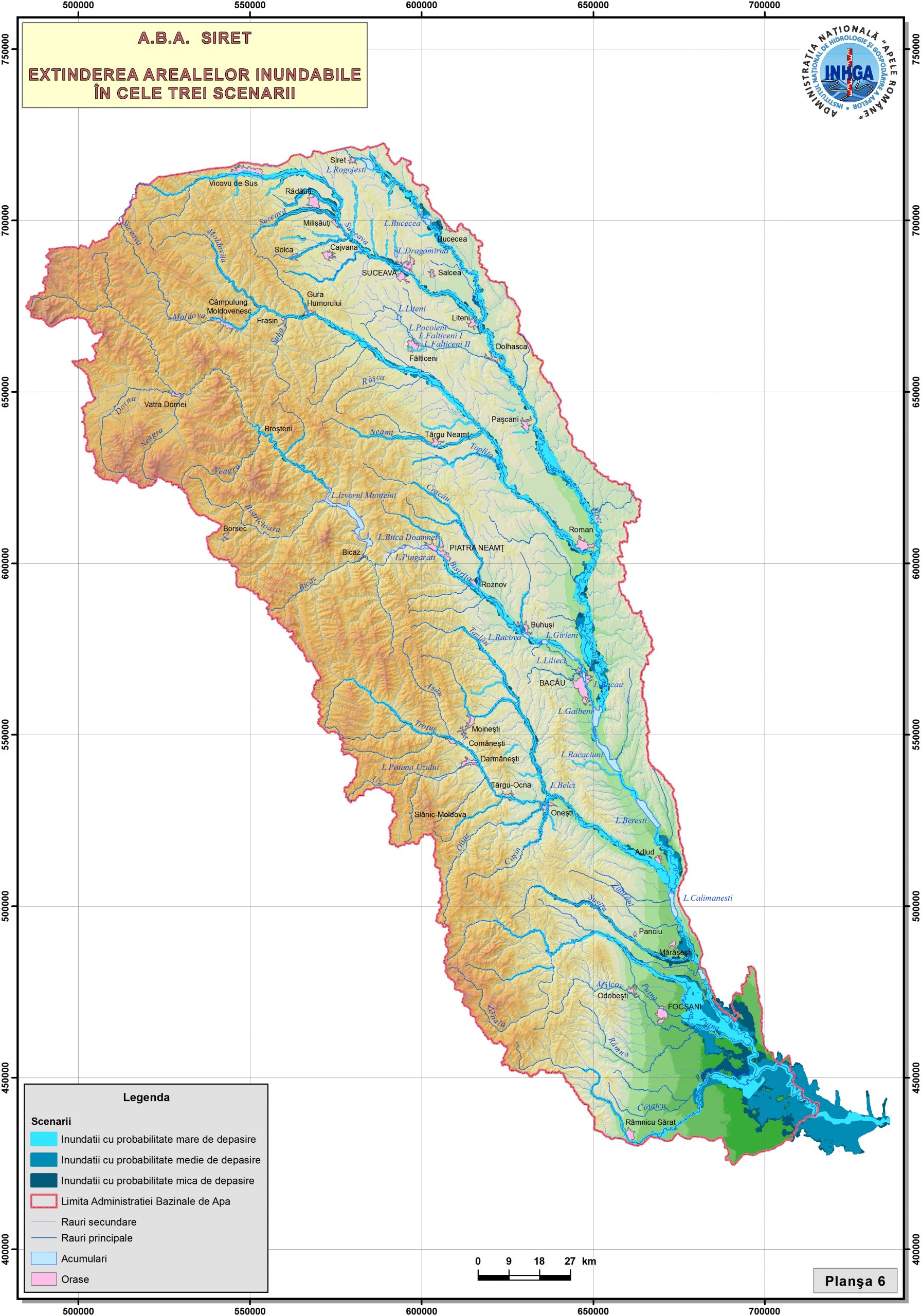
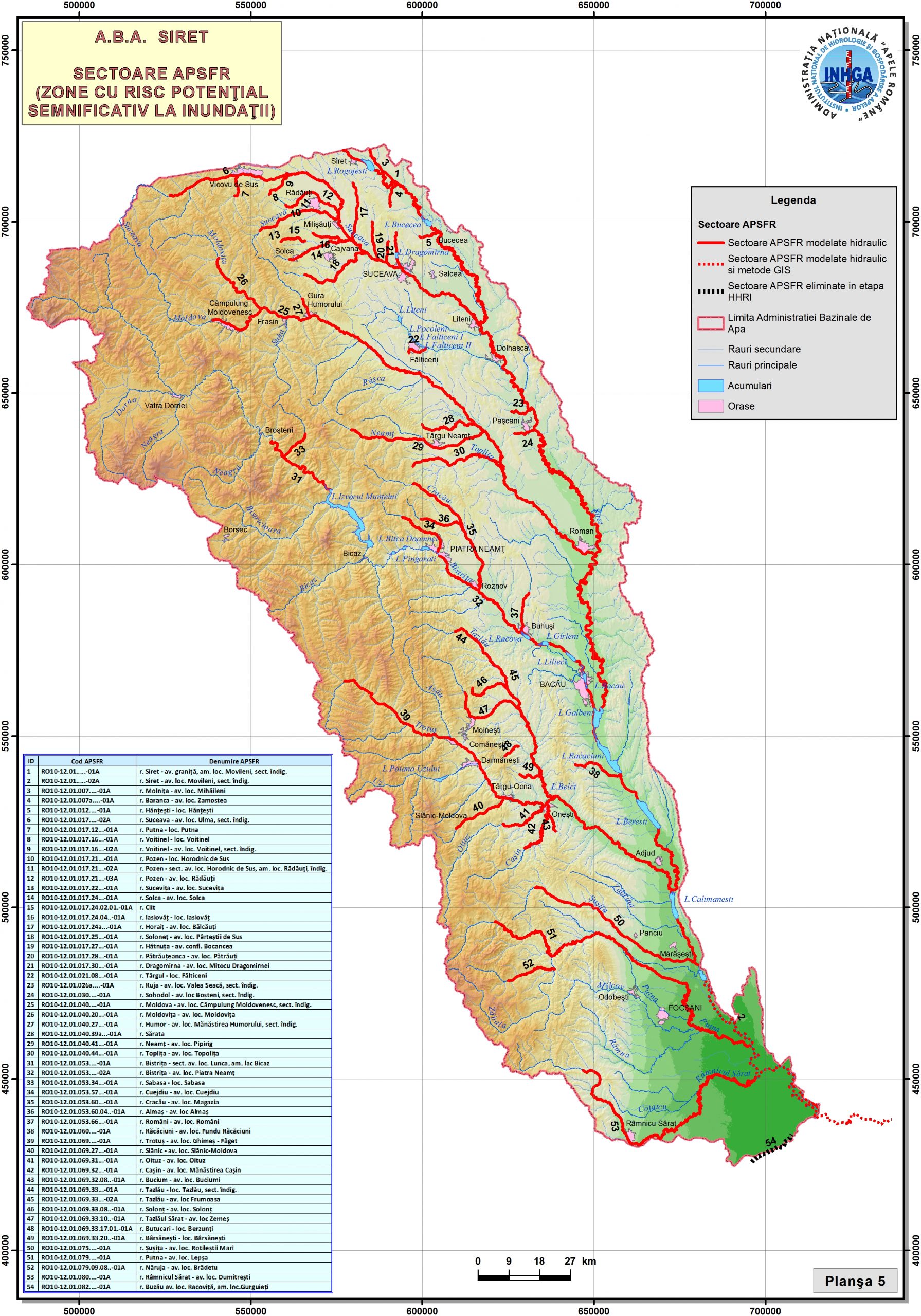
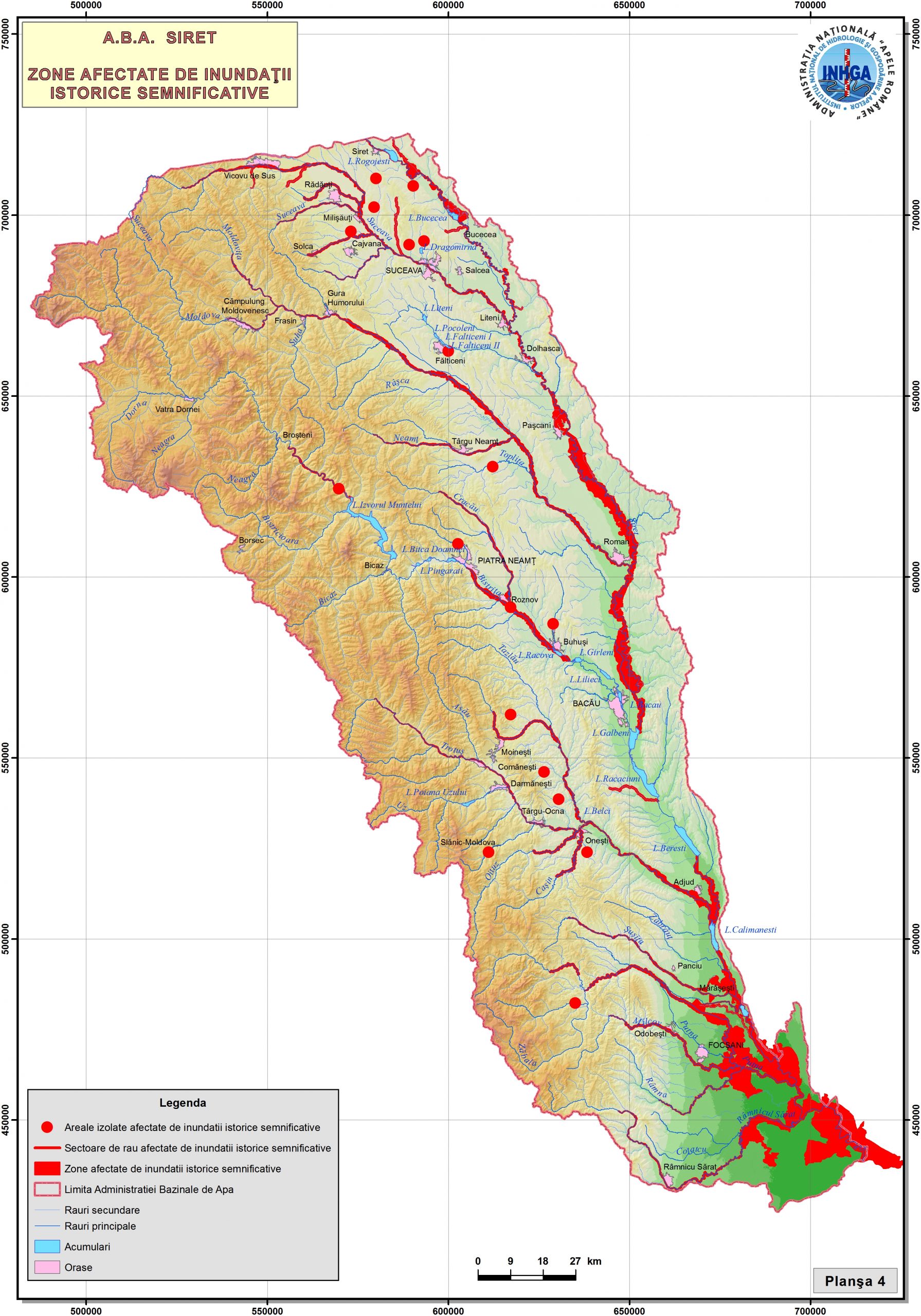

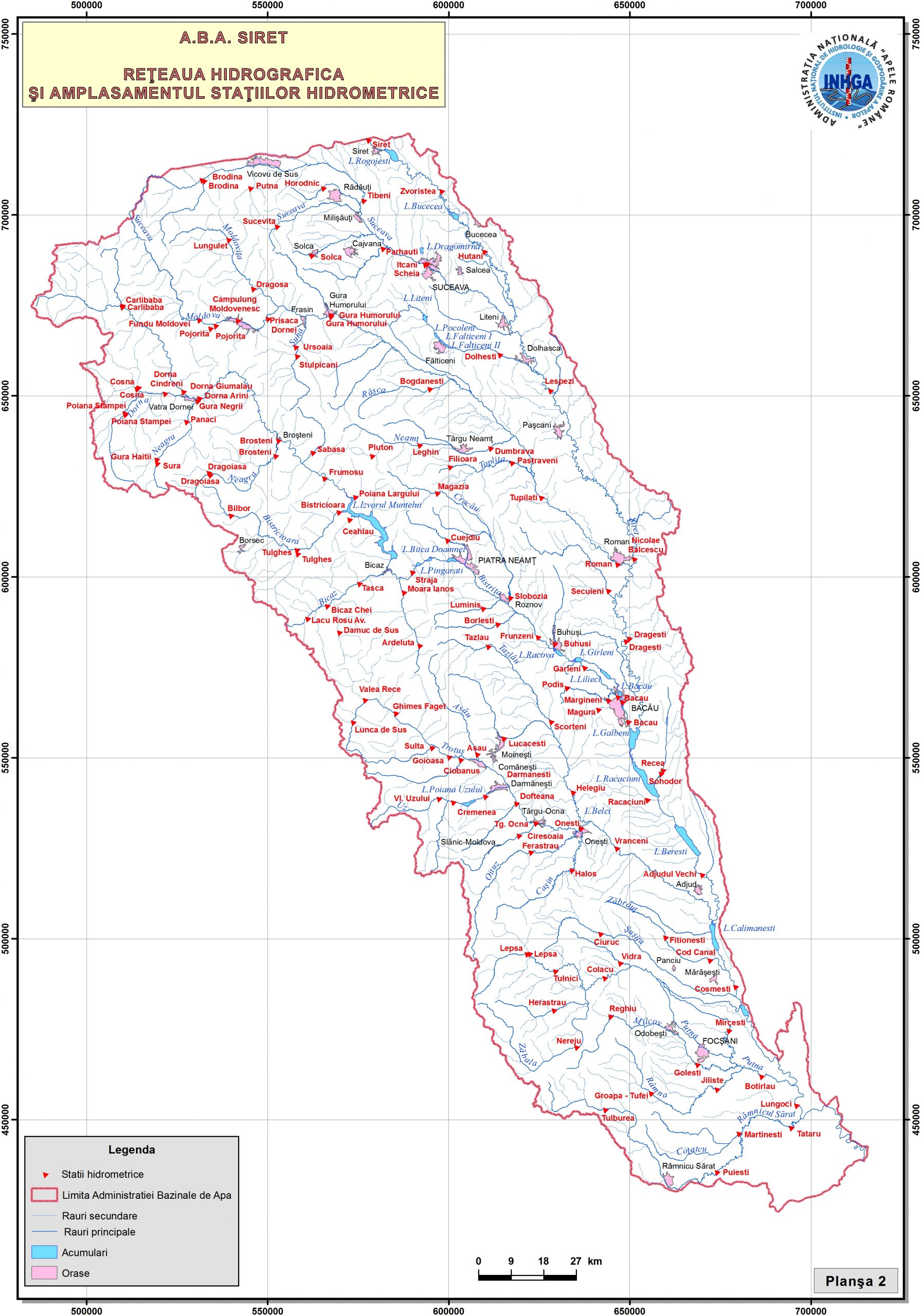
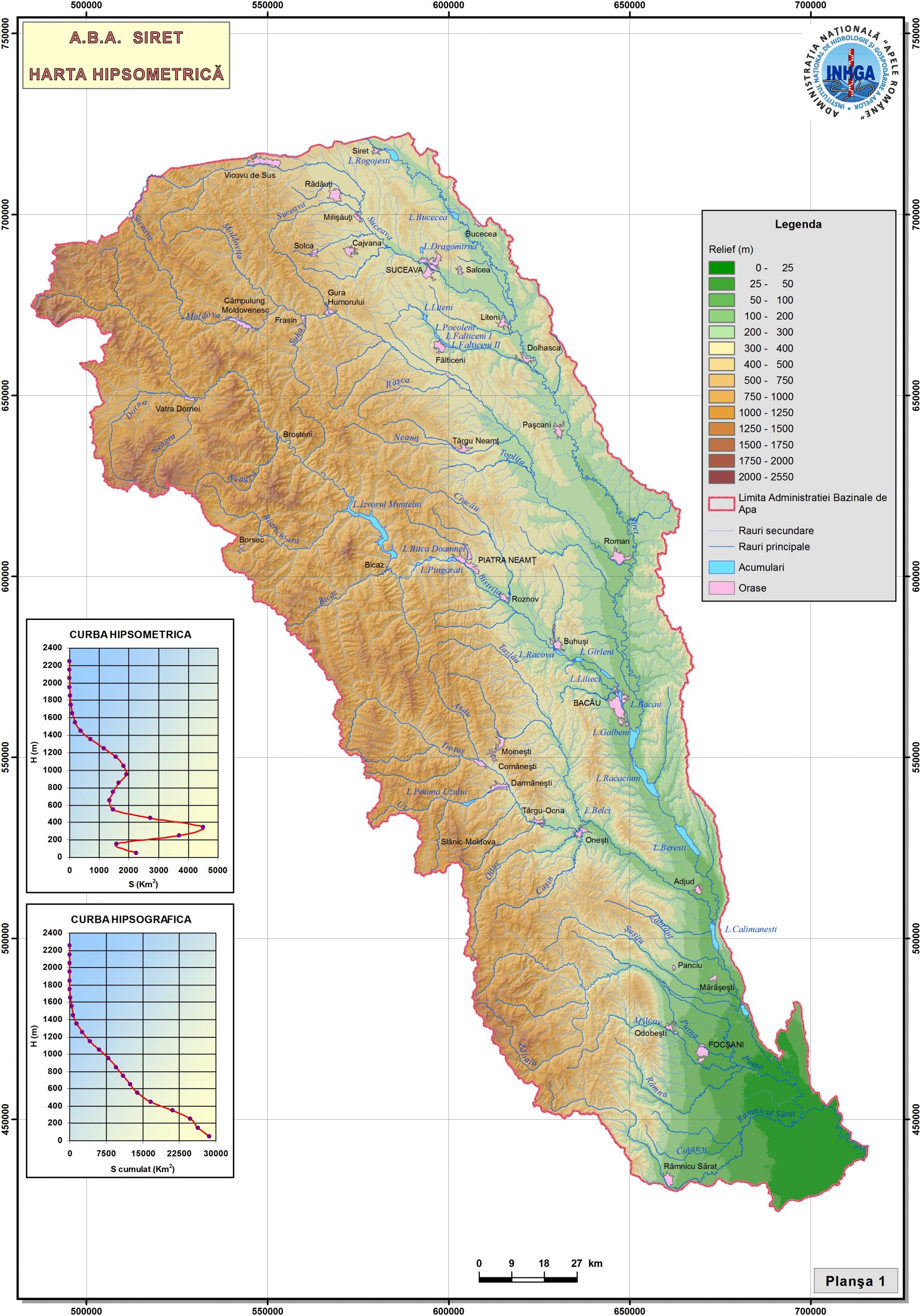
Prut
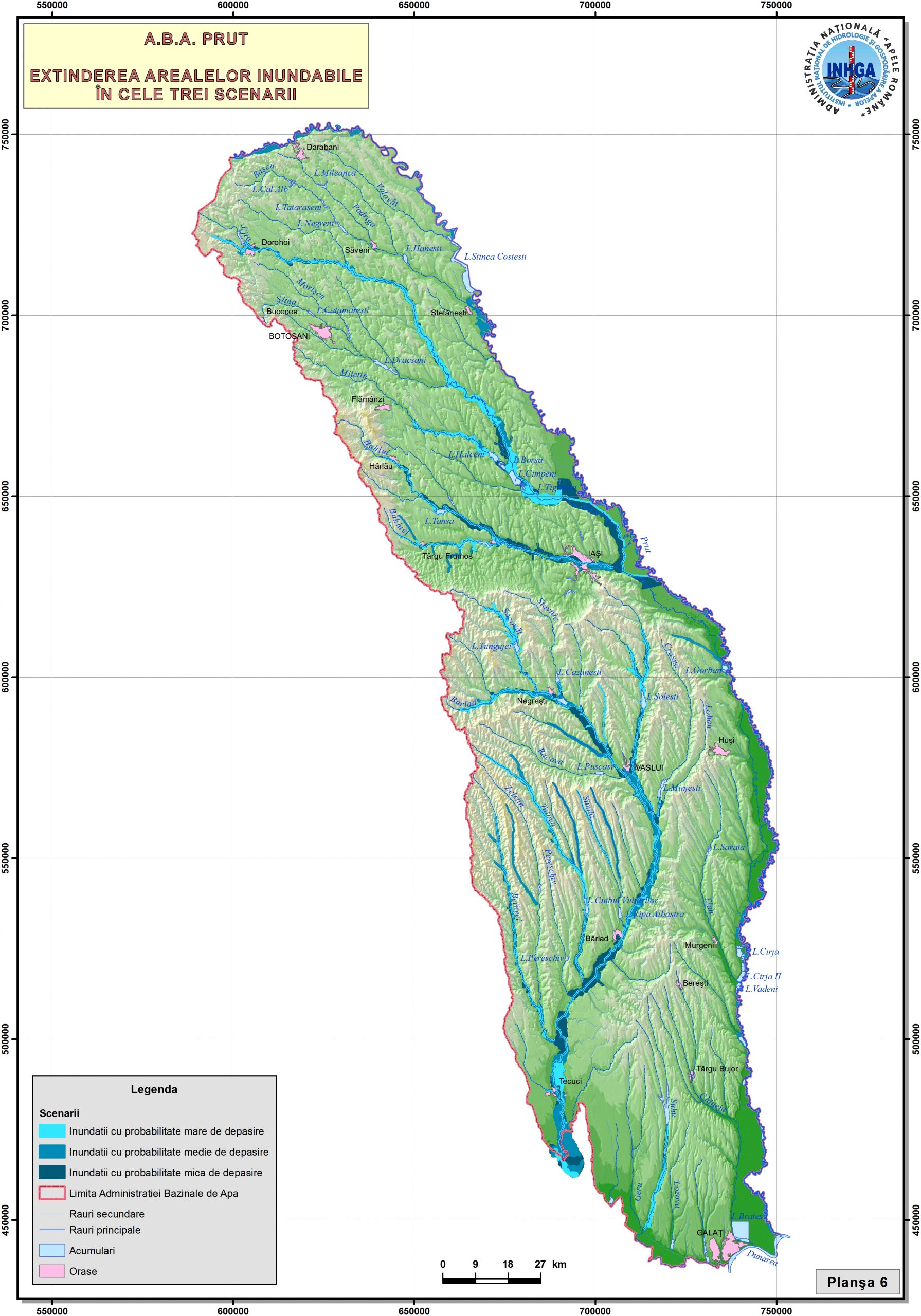
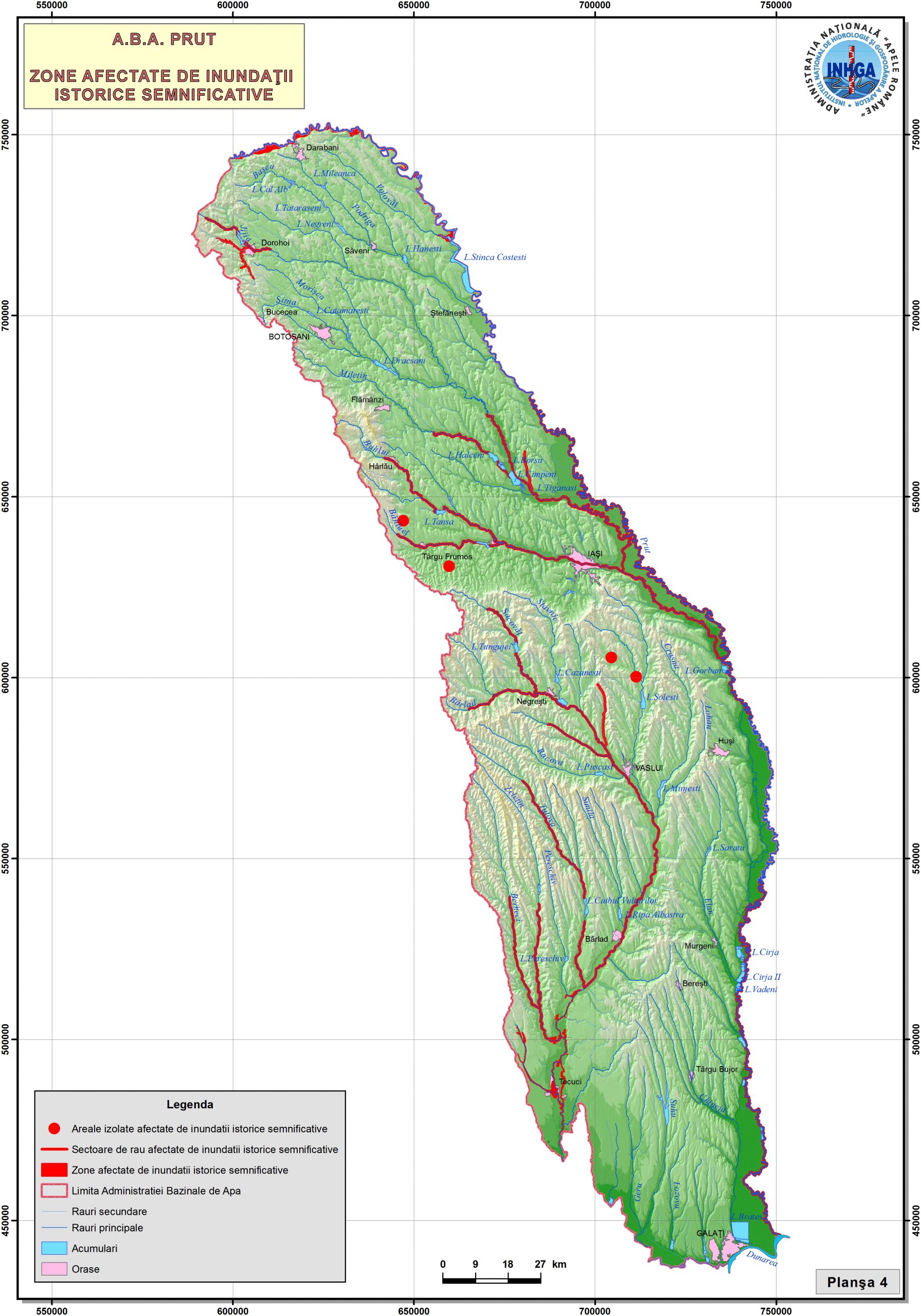
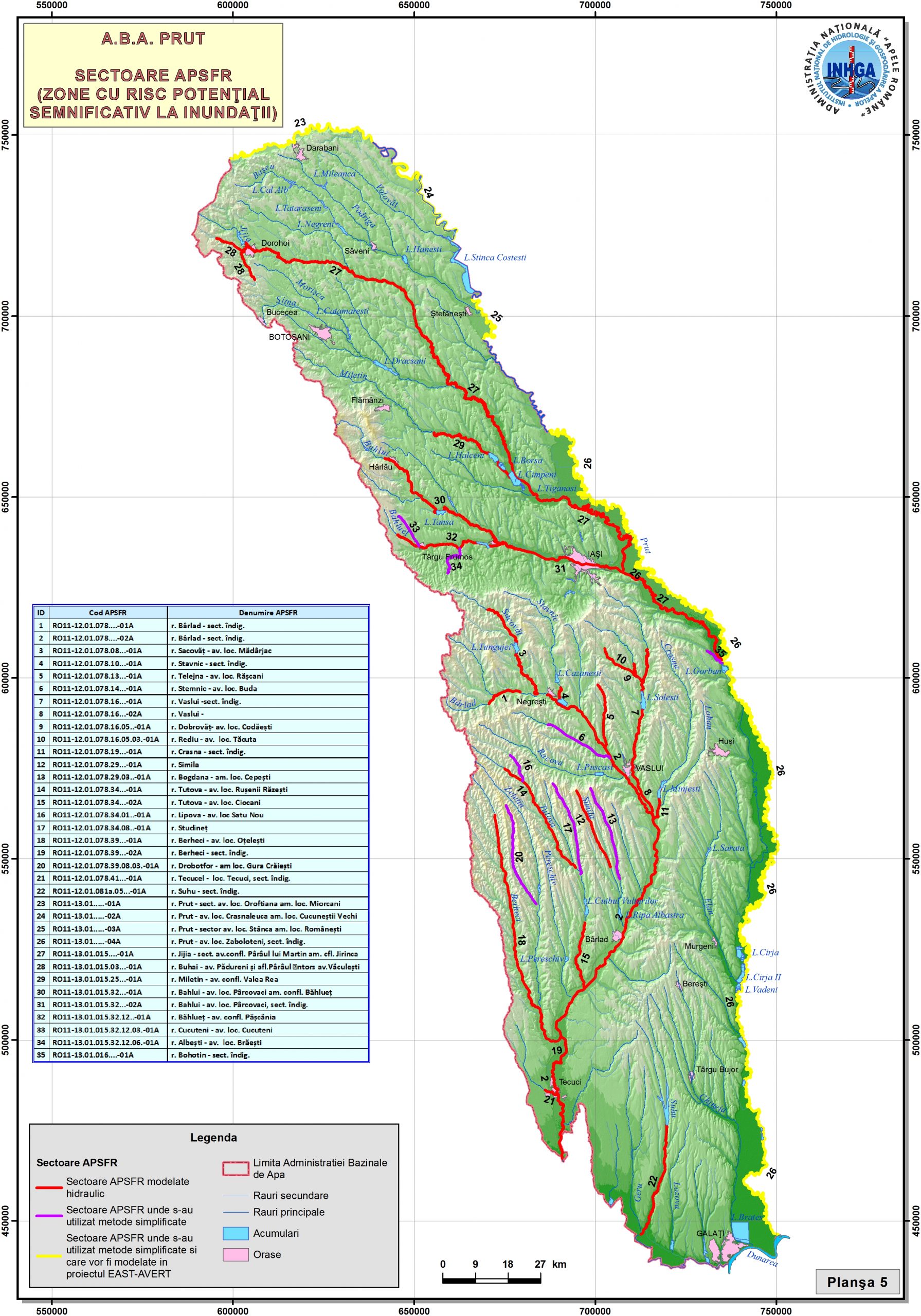
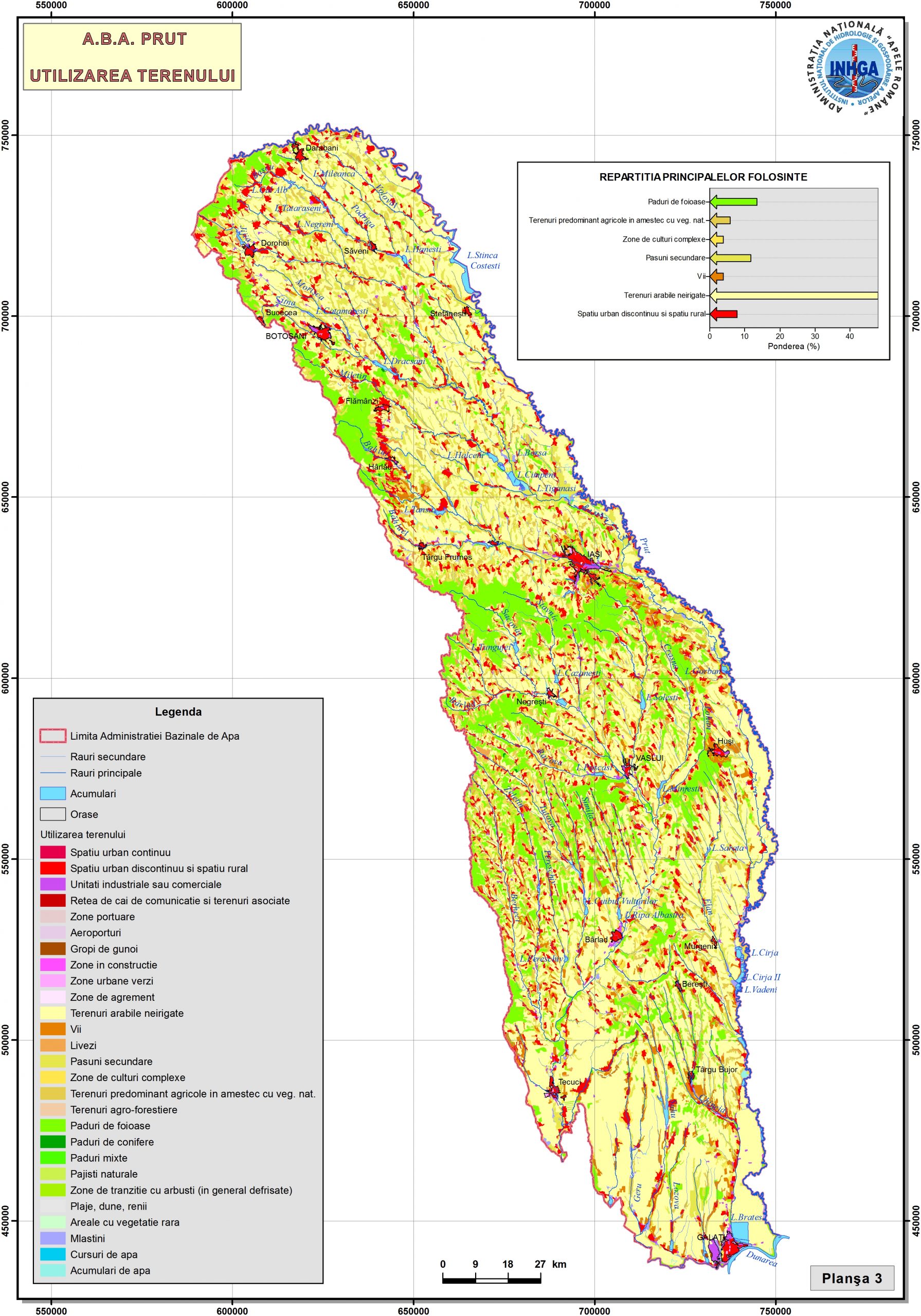

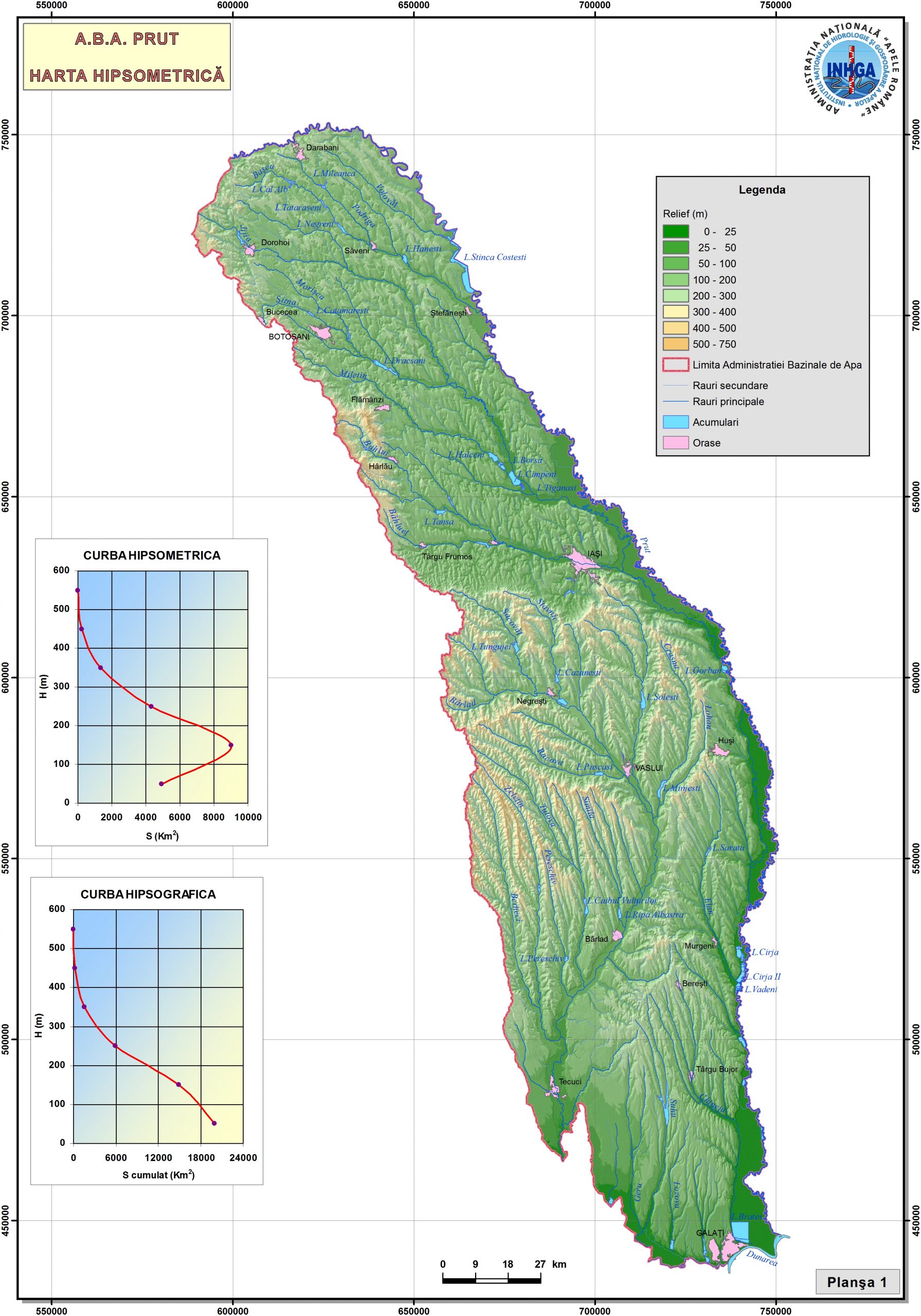
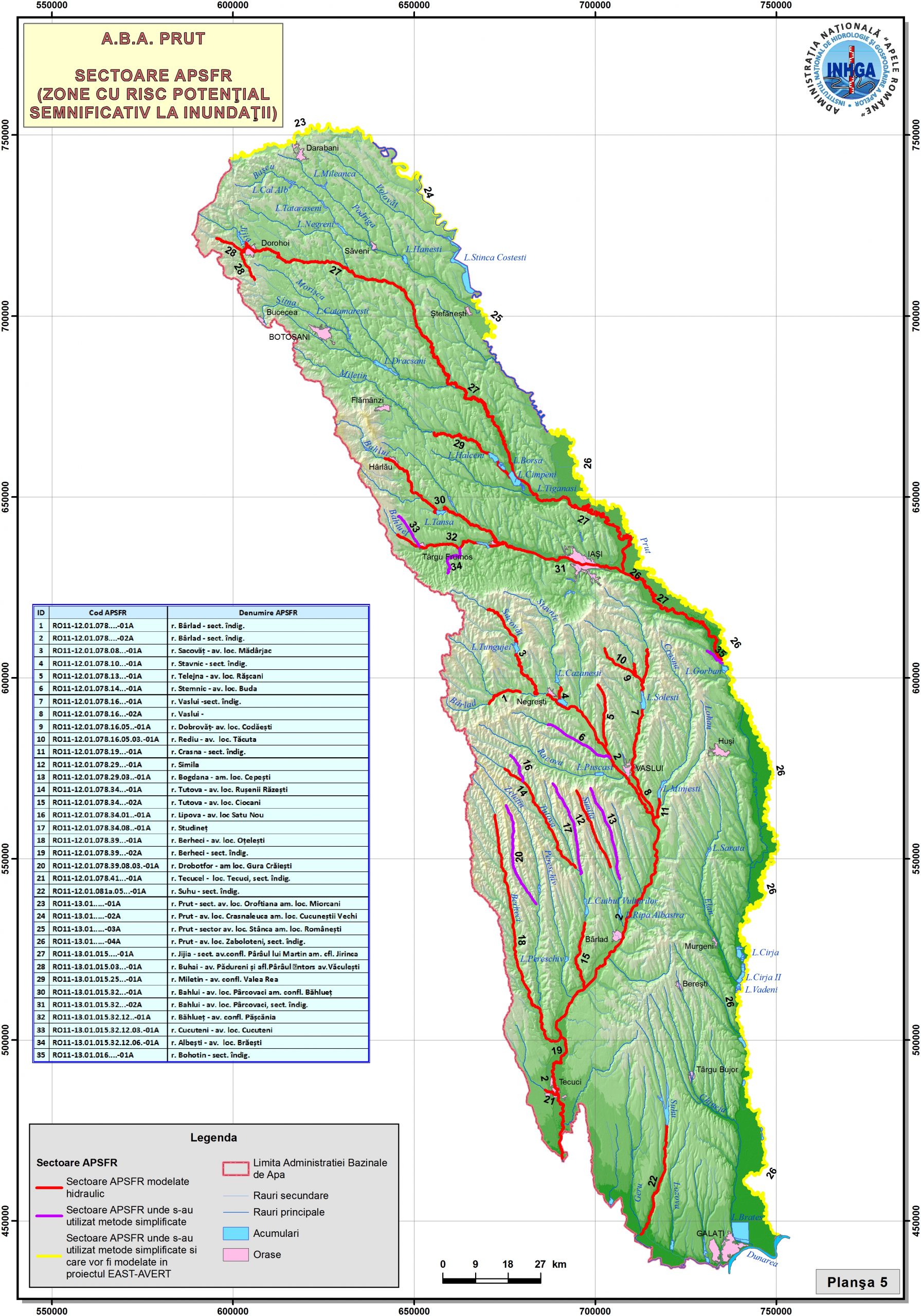
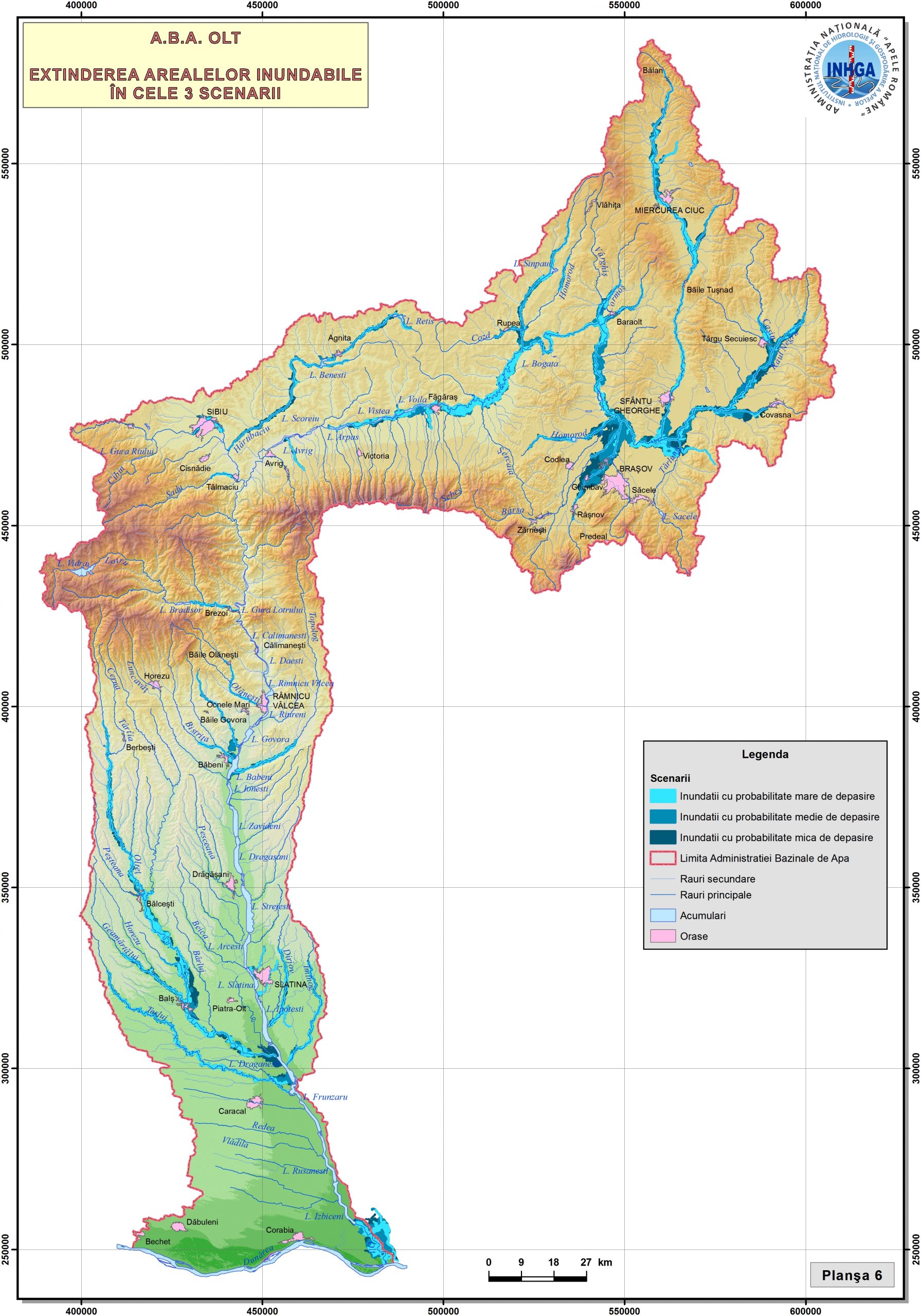
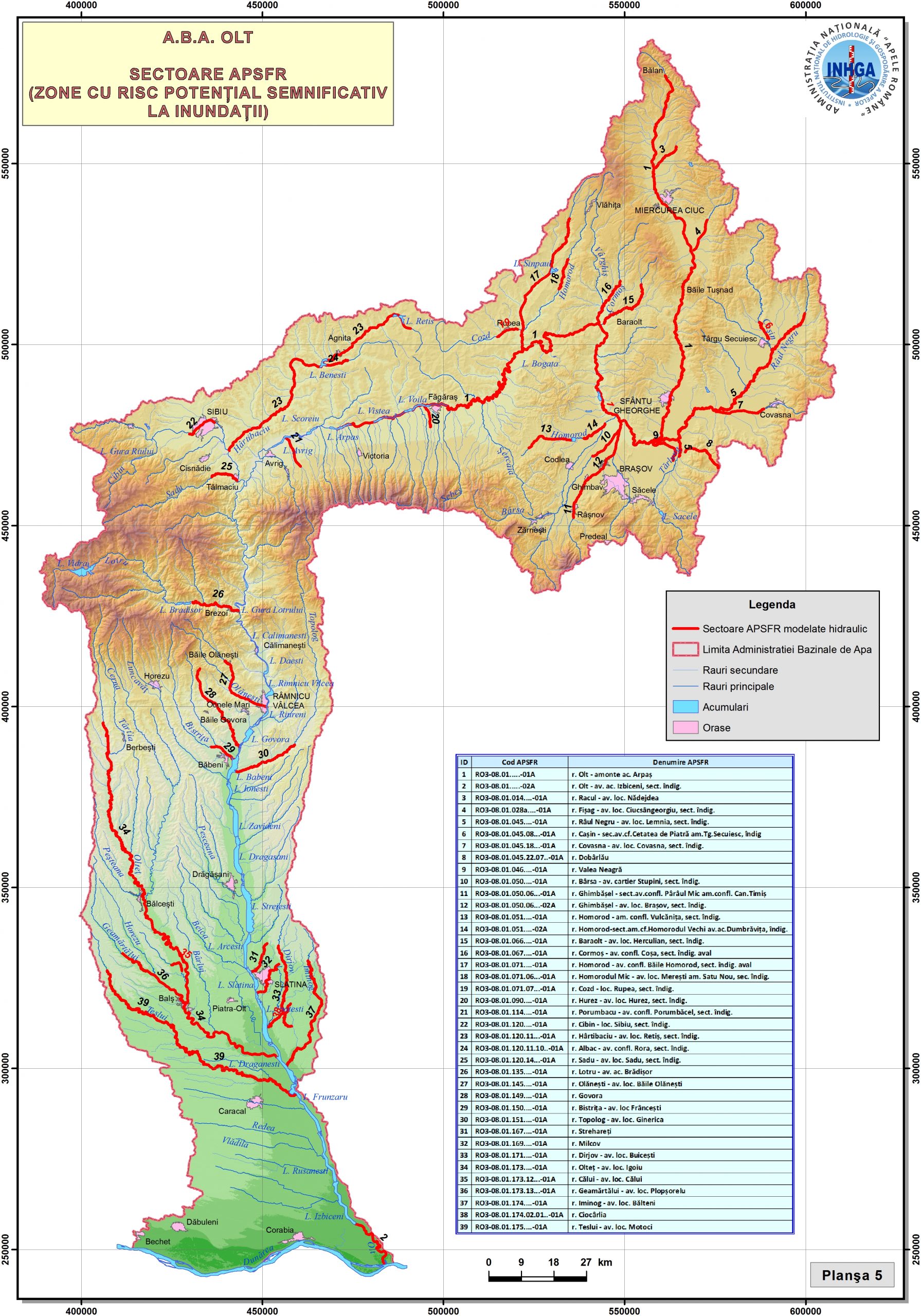
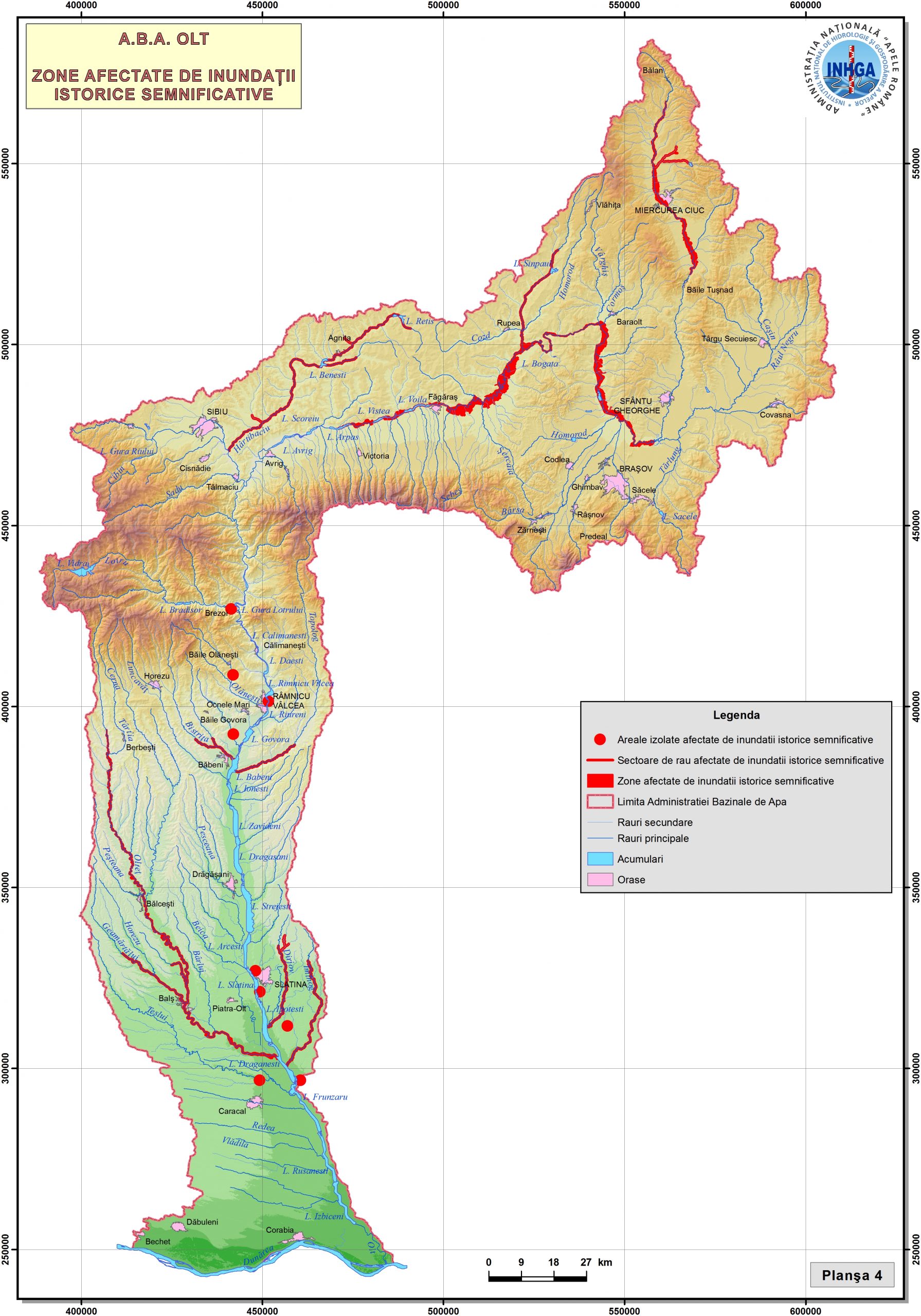

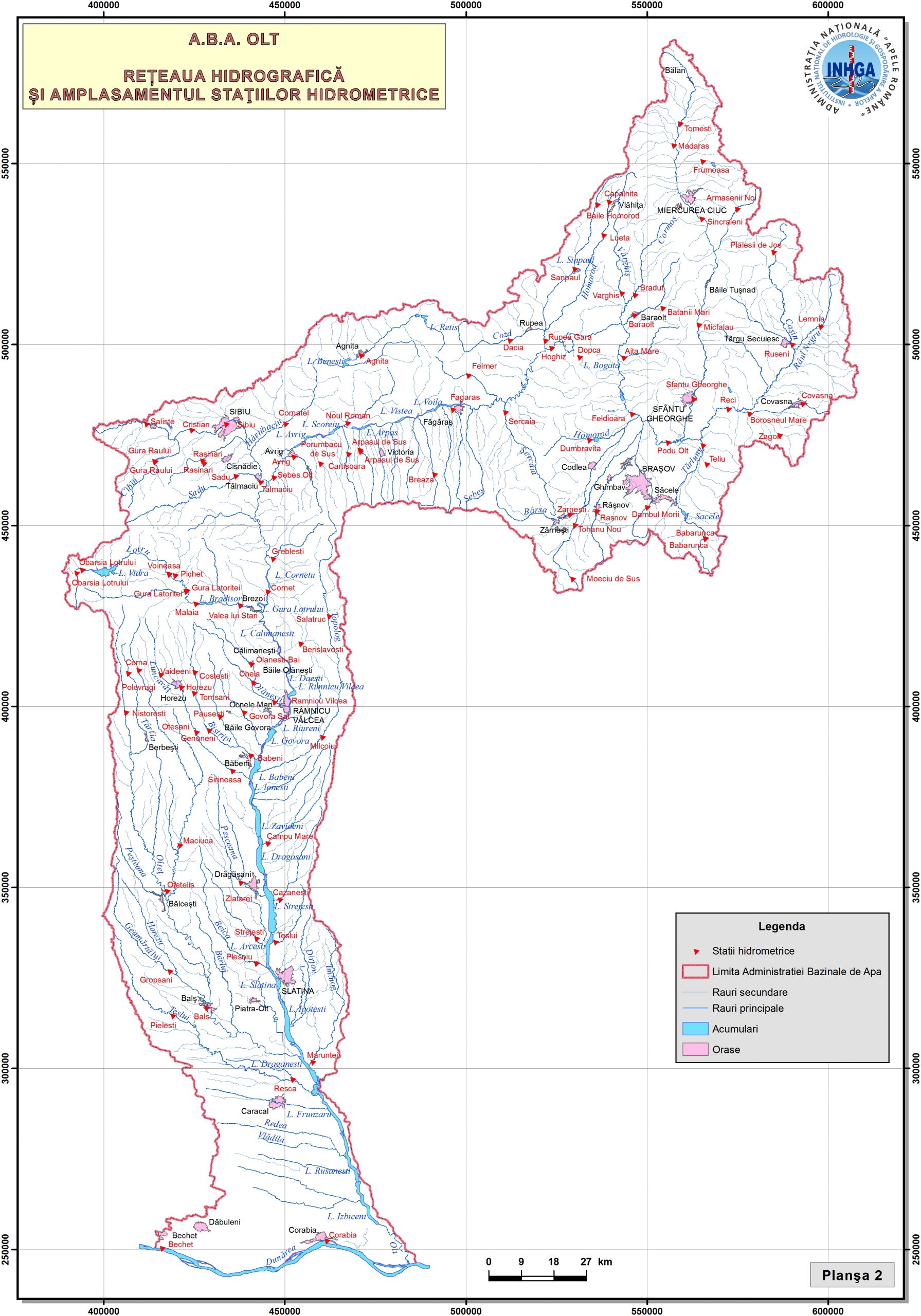
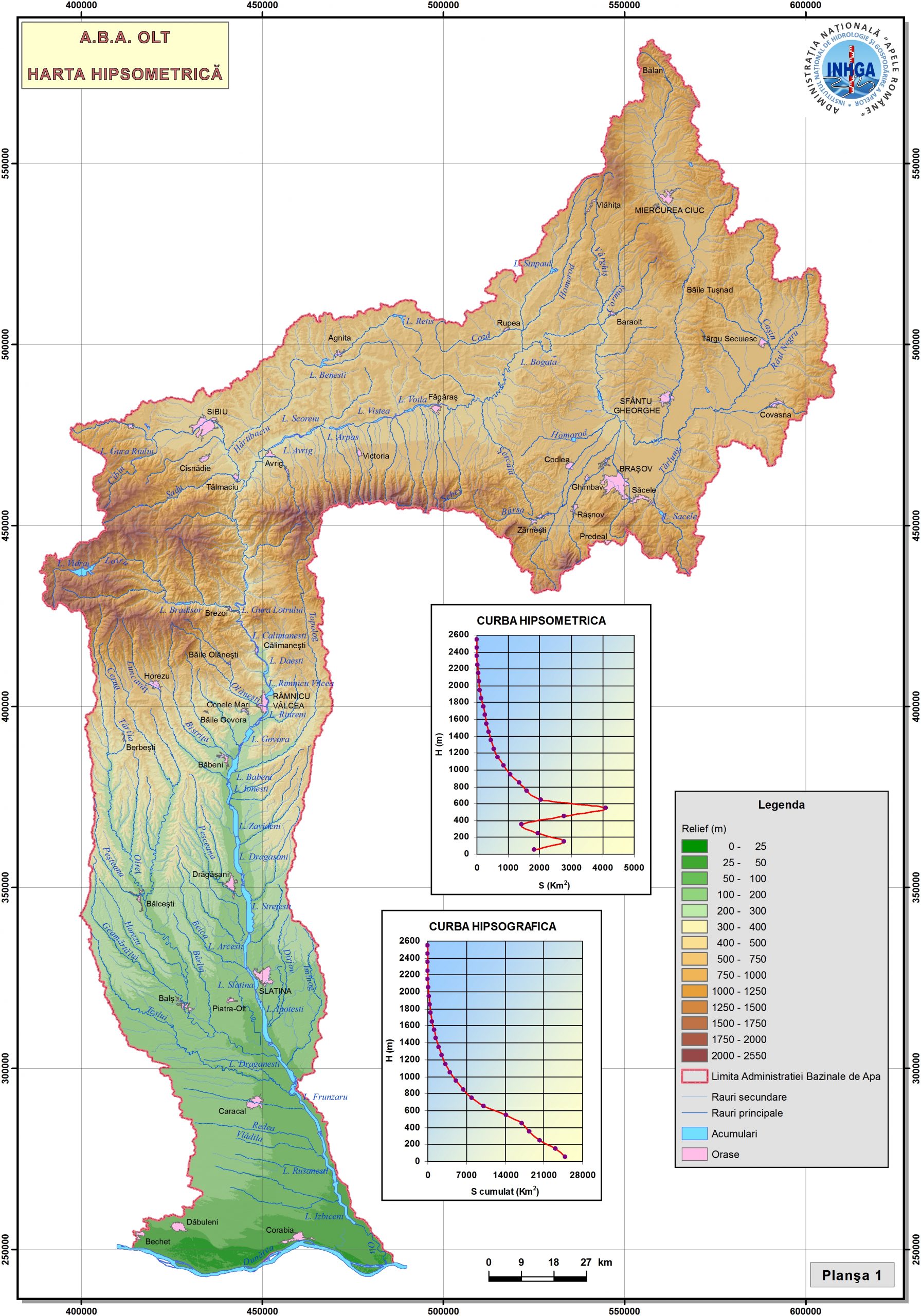
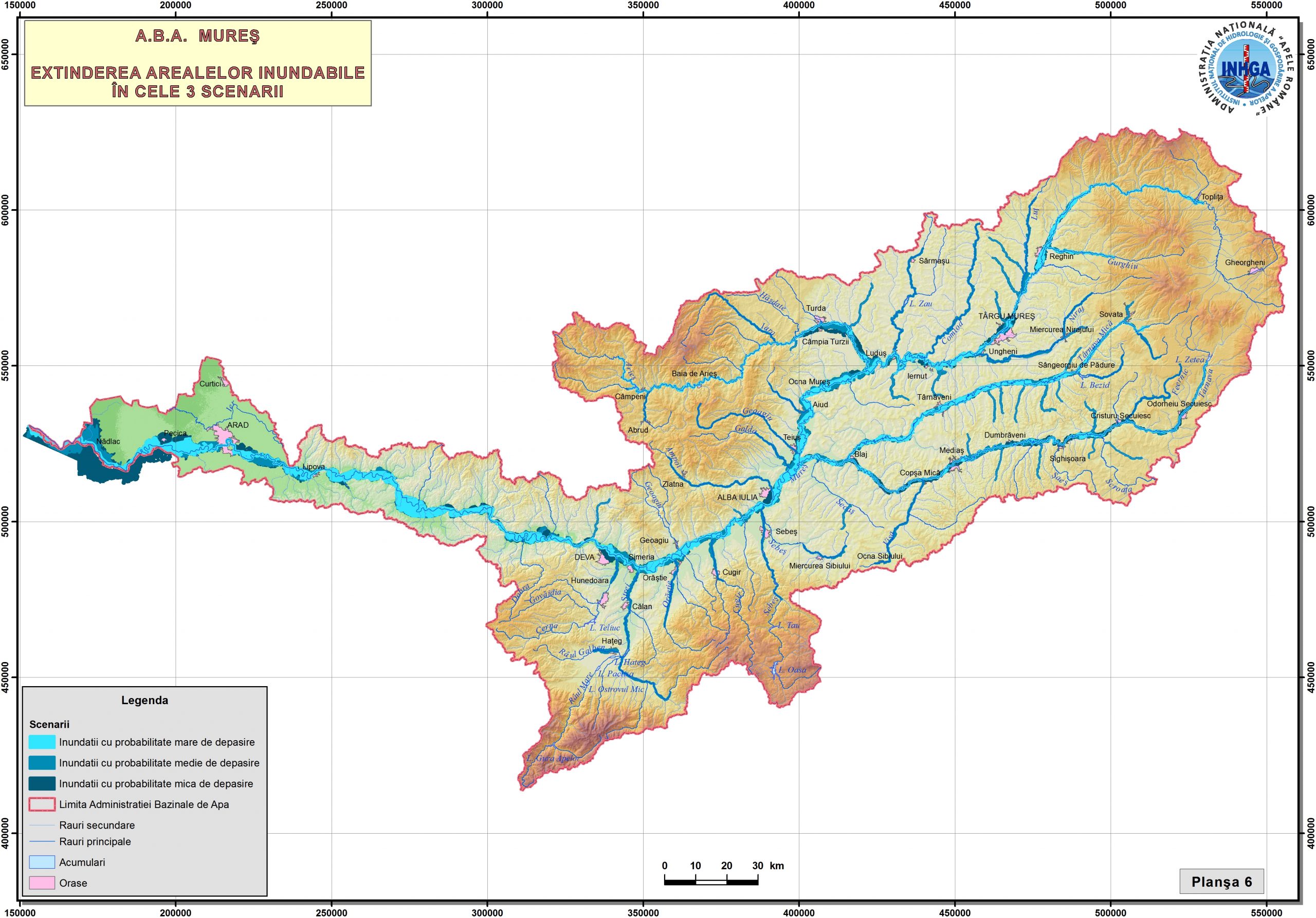
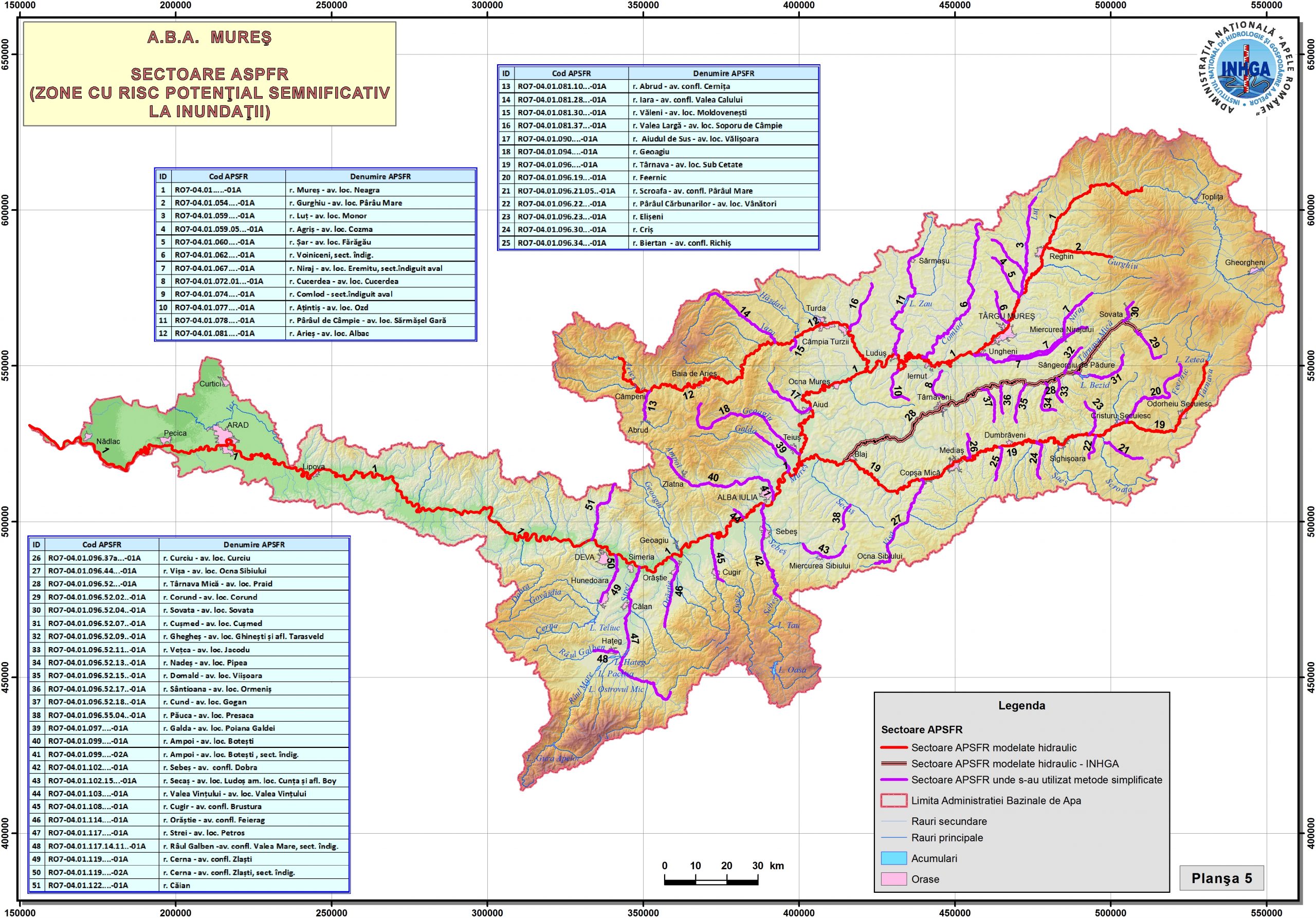
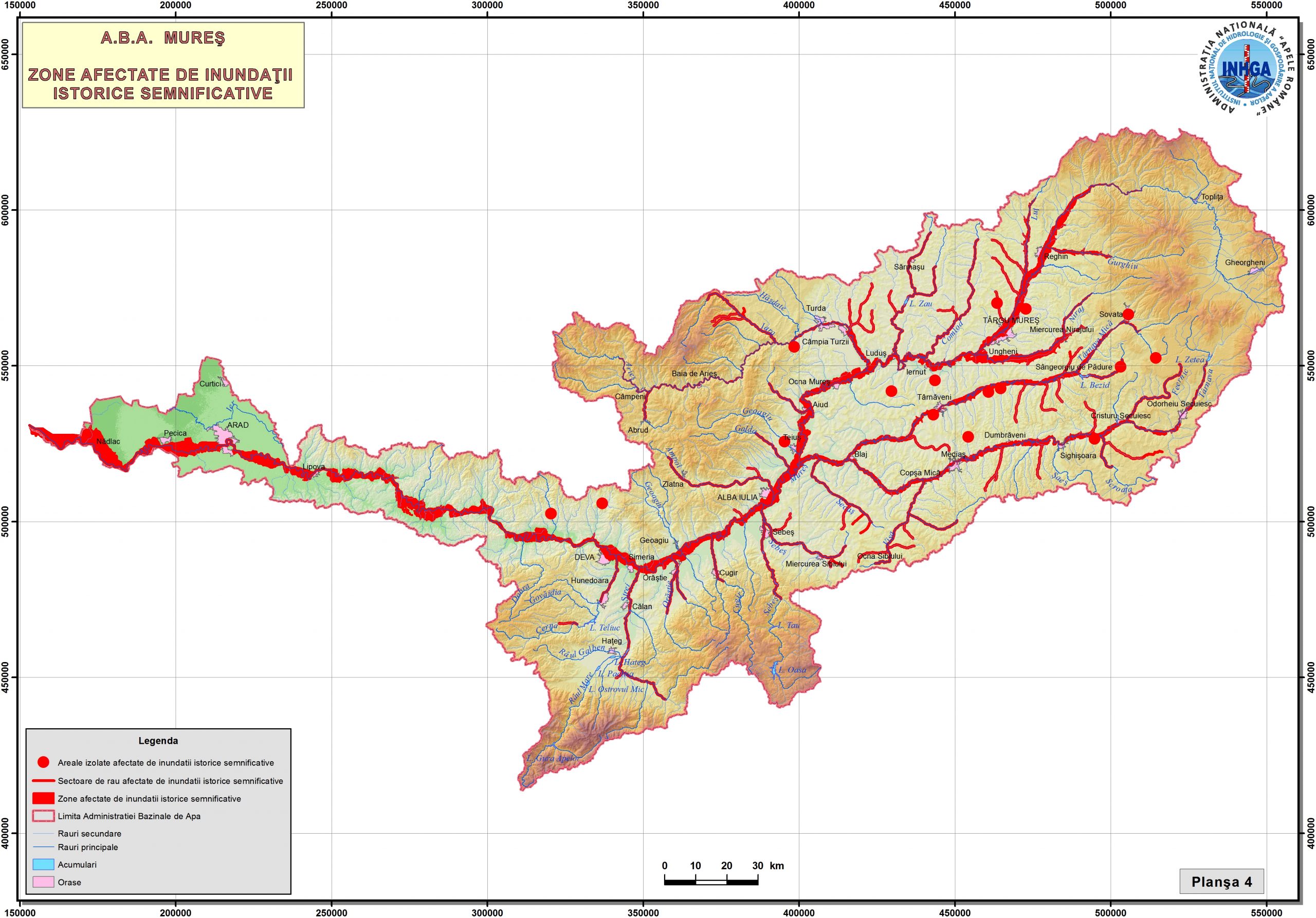
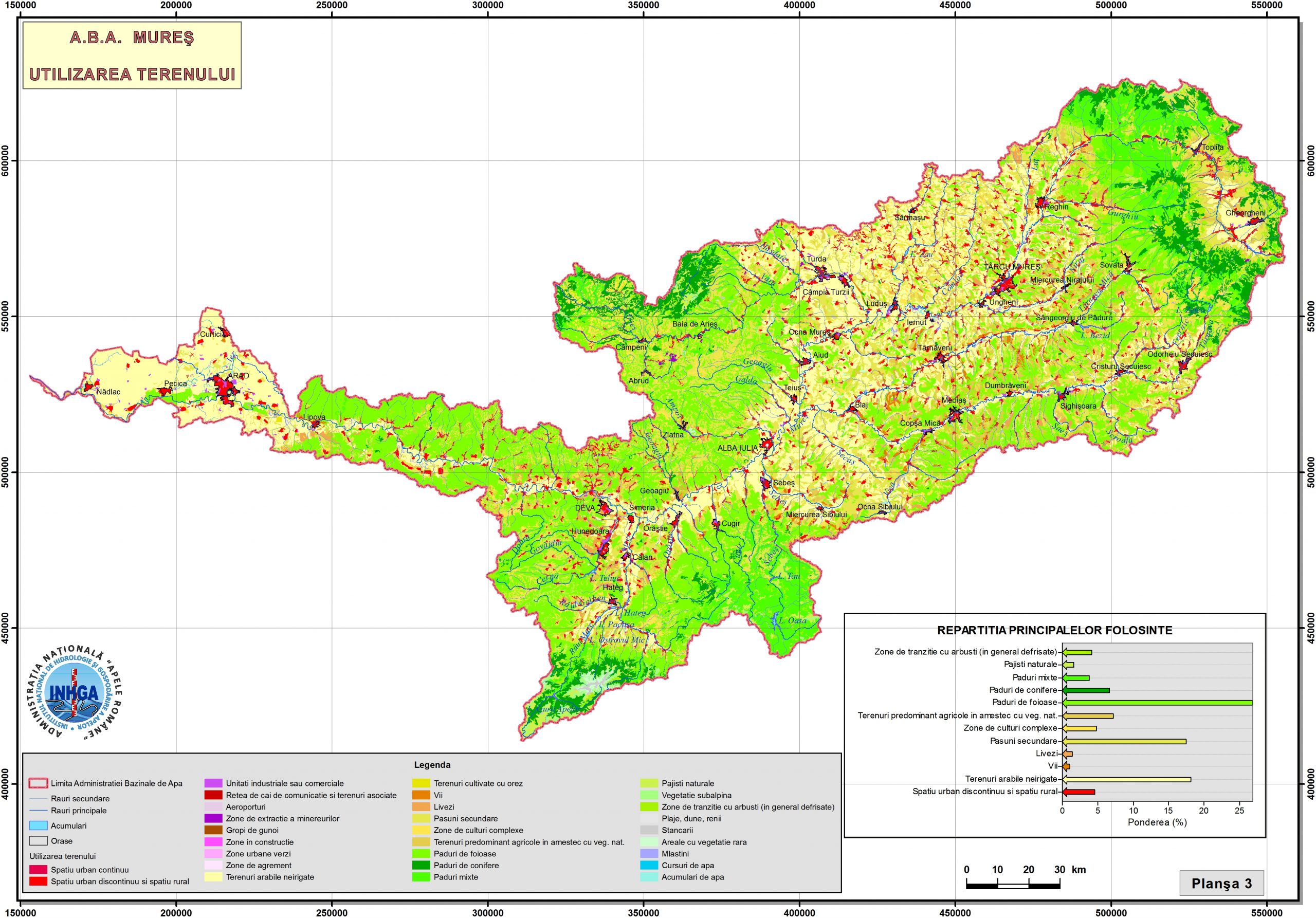
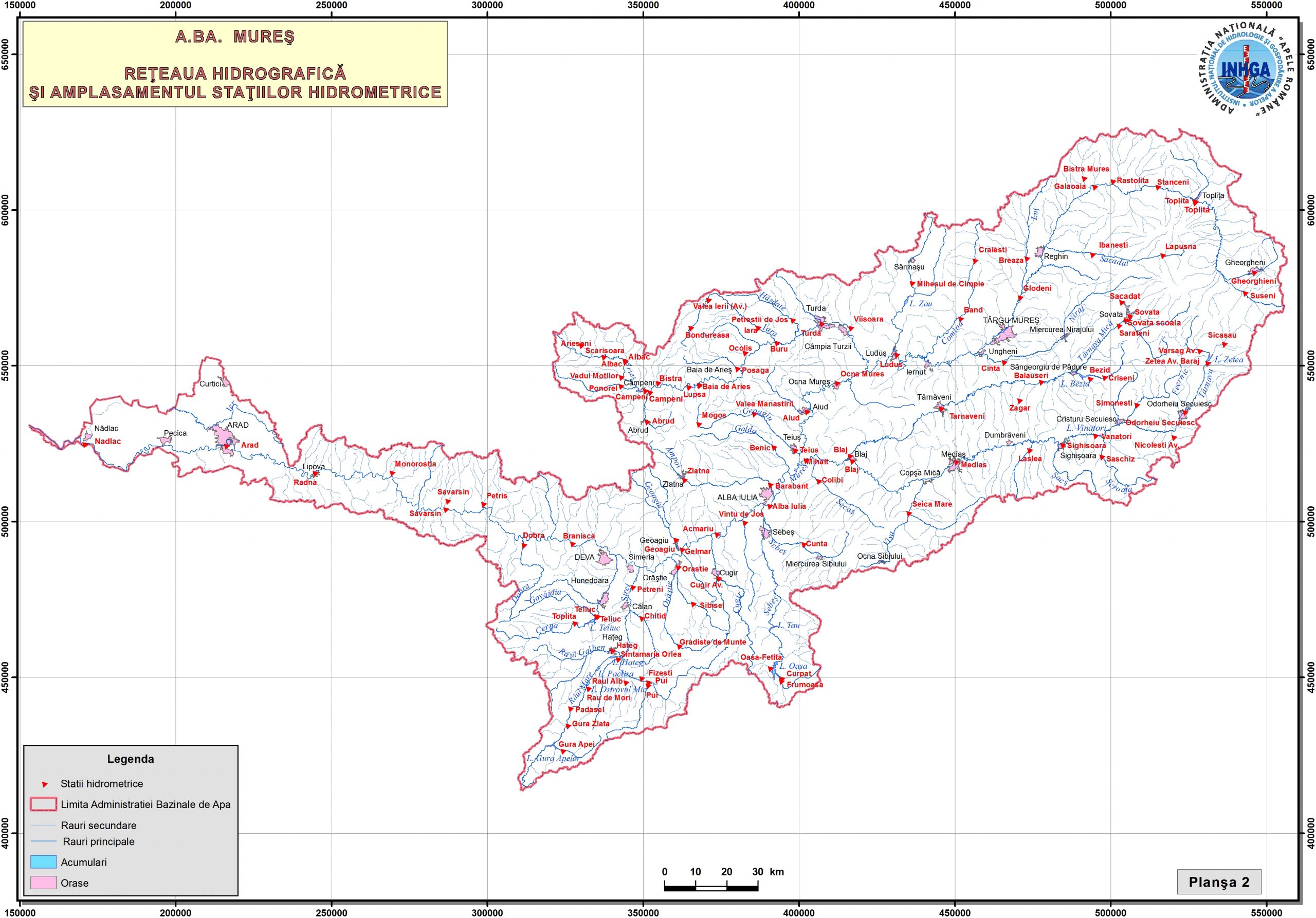
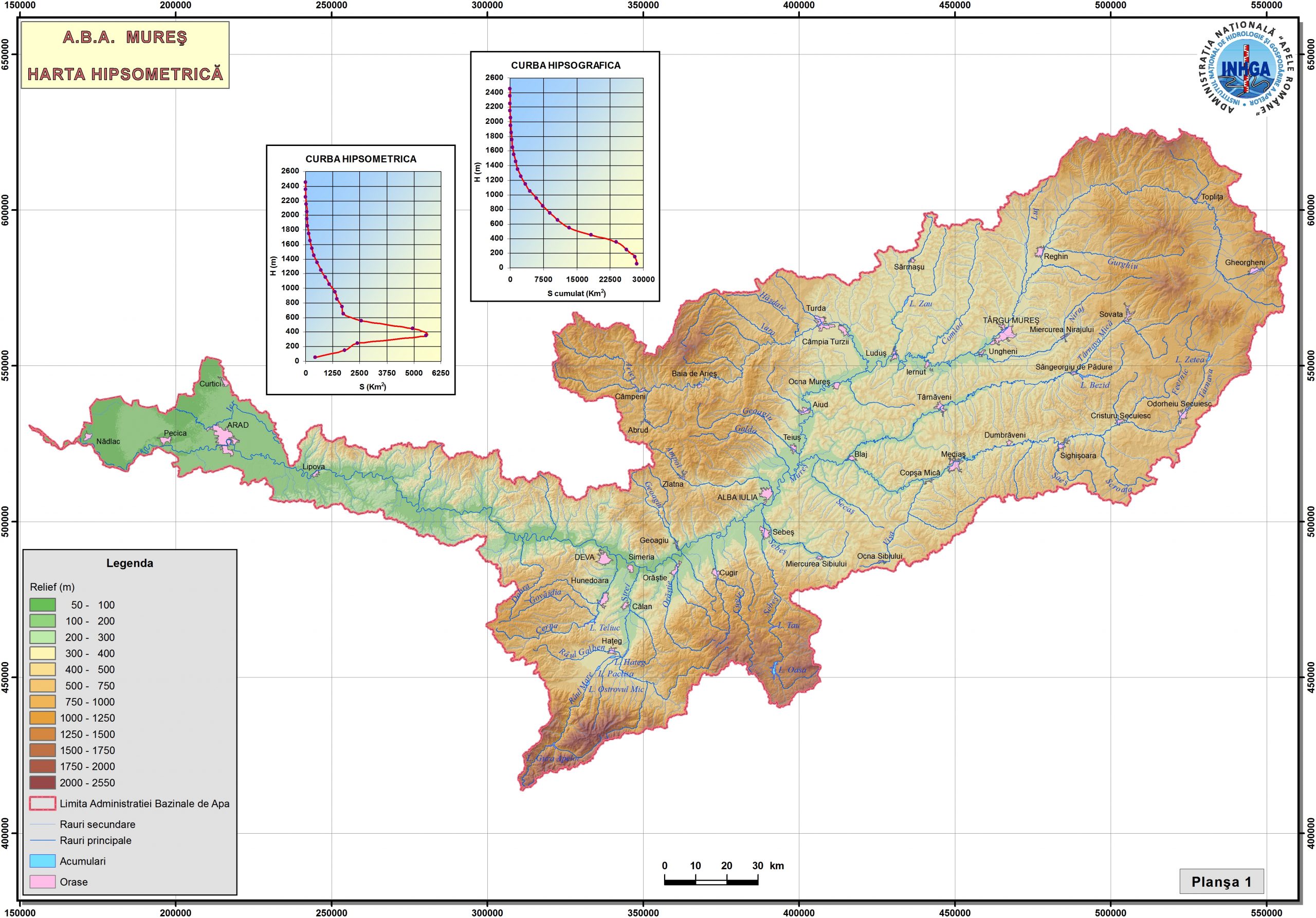
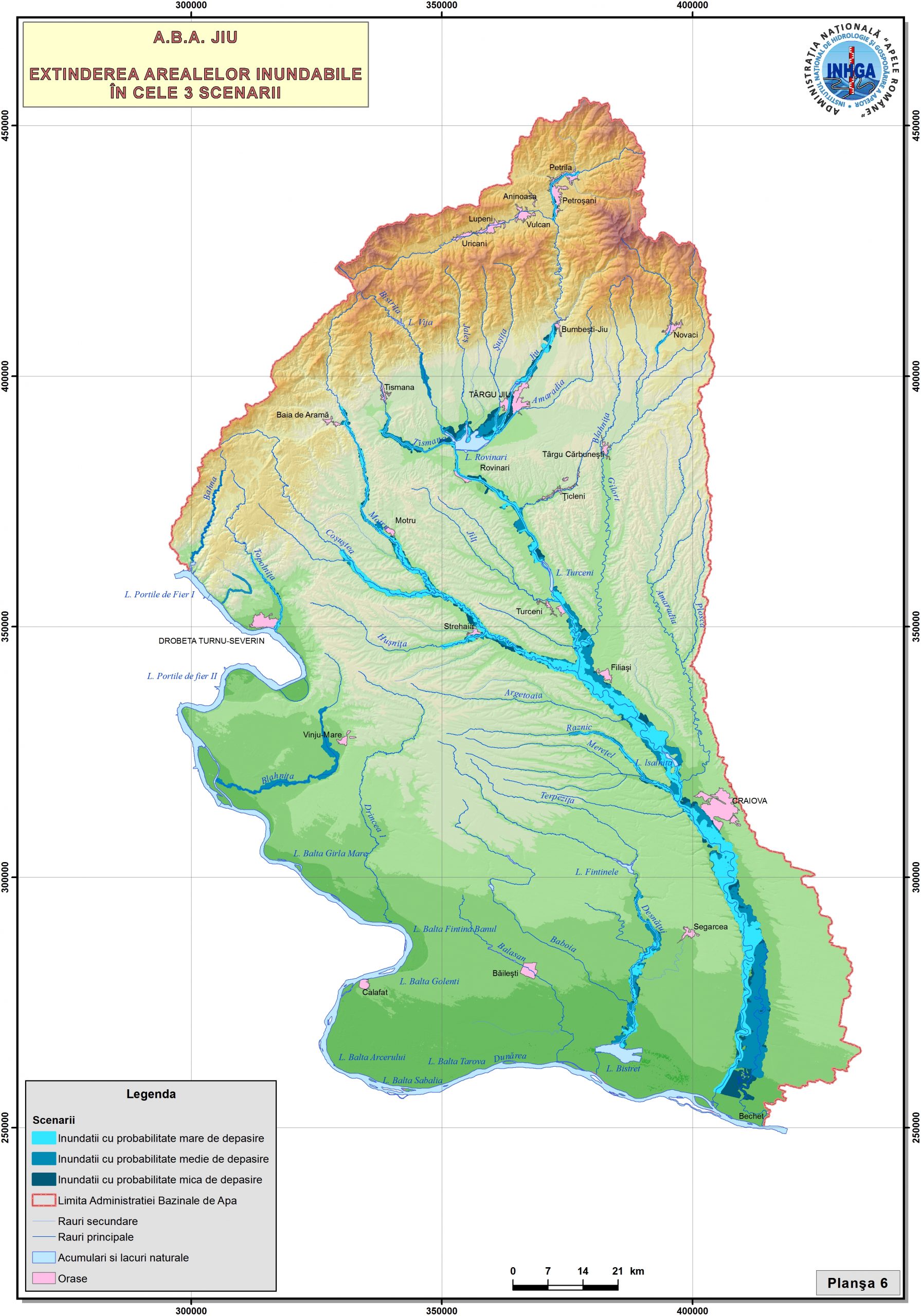
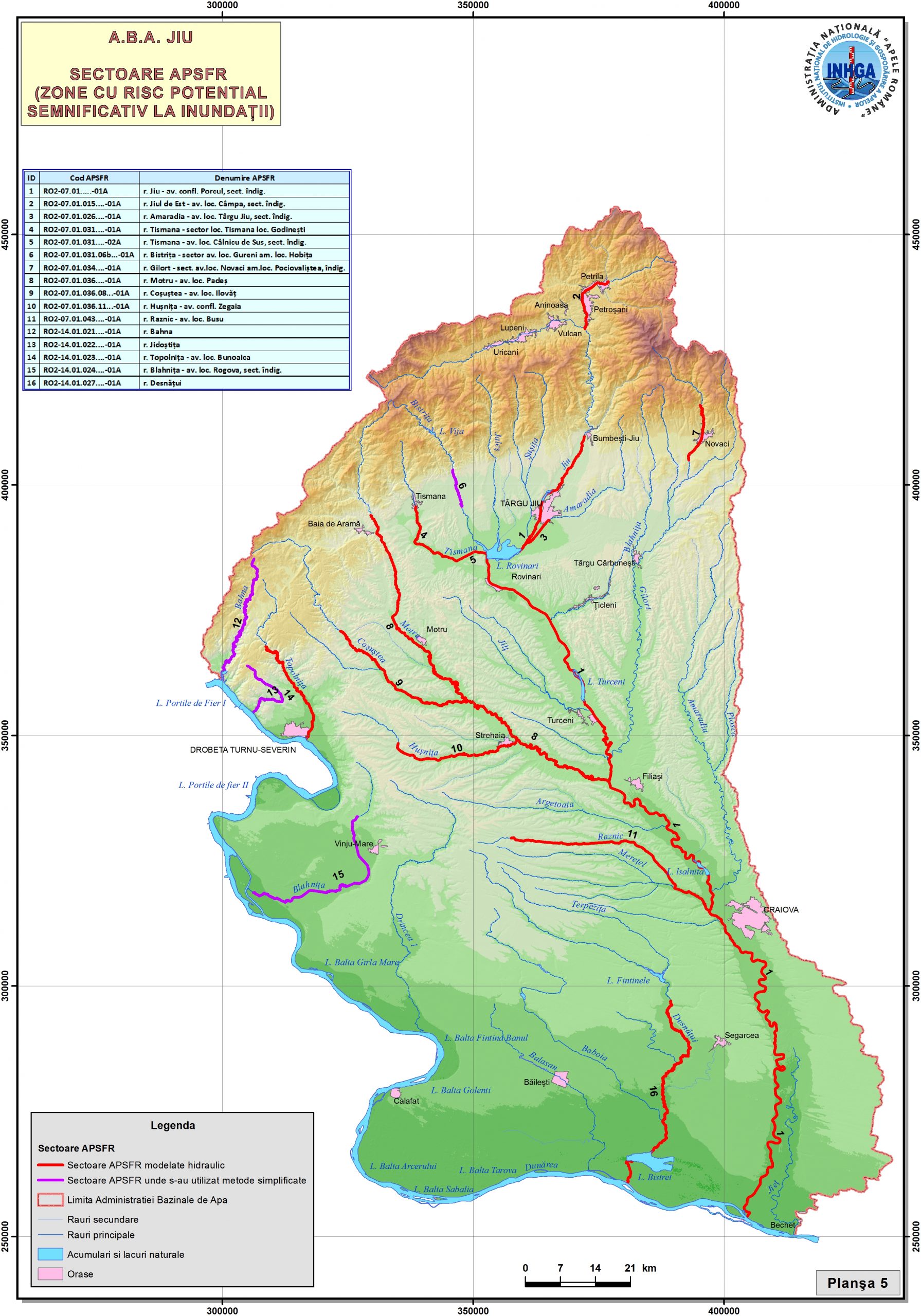
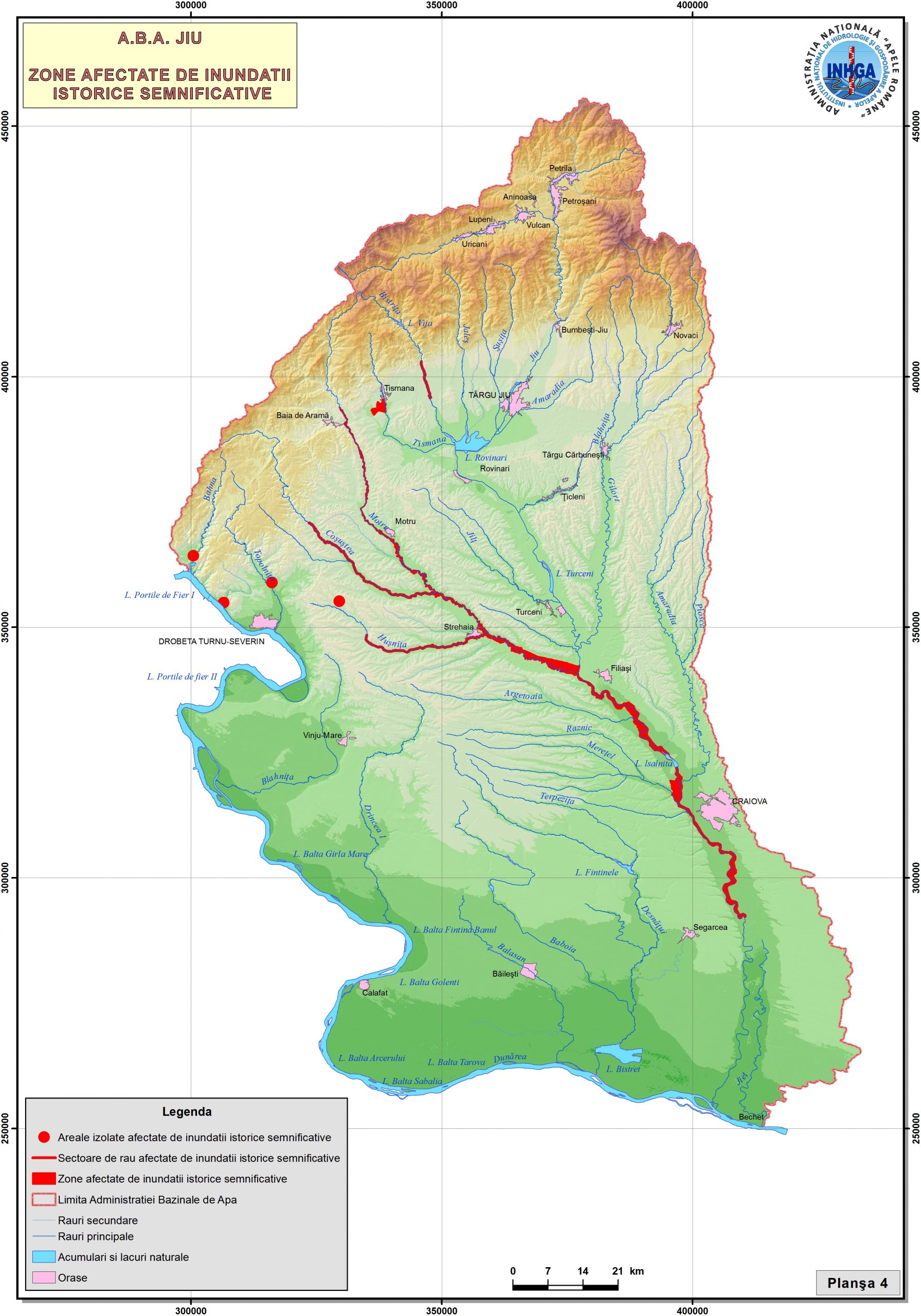
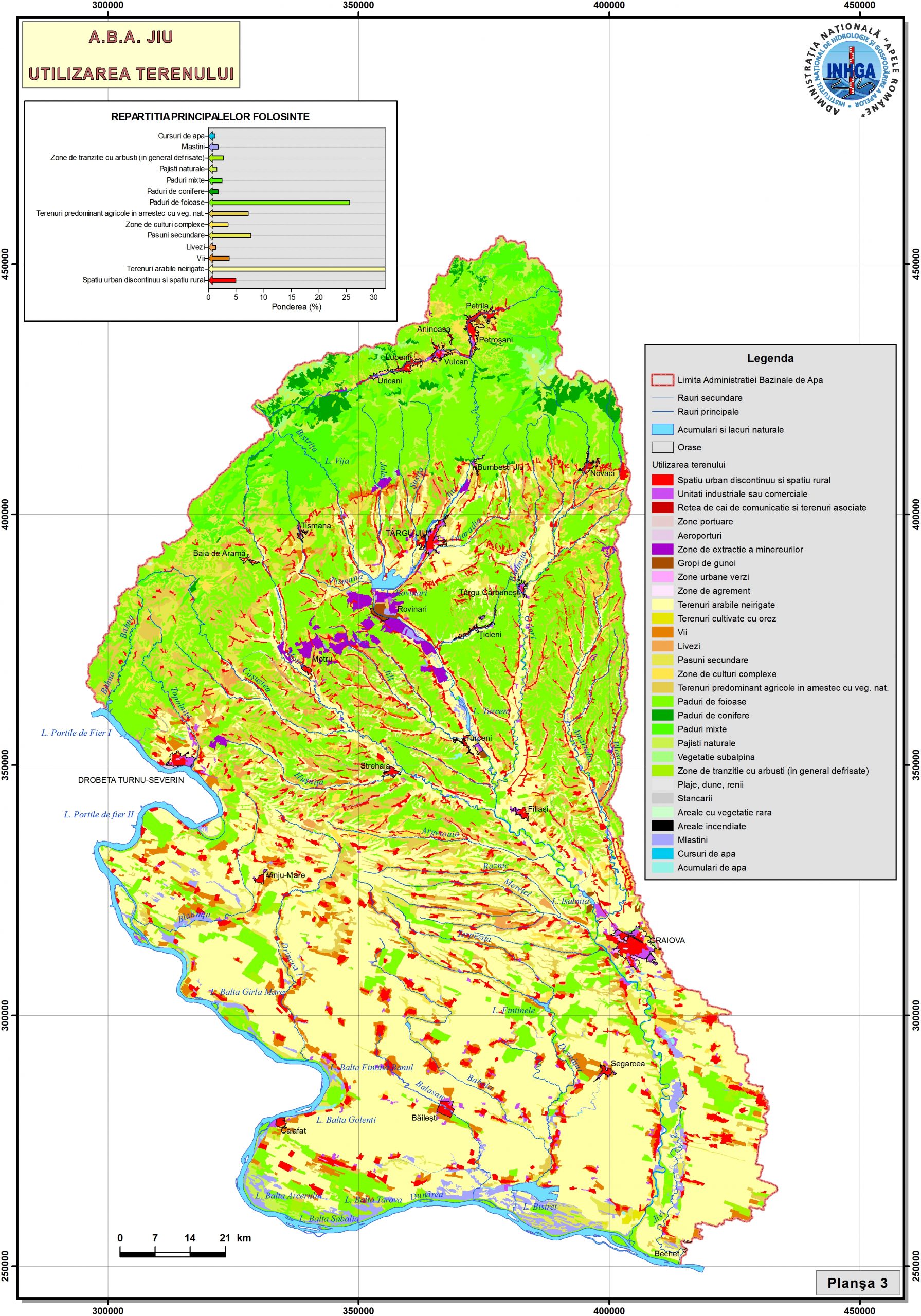

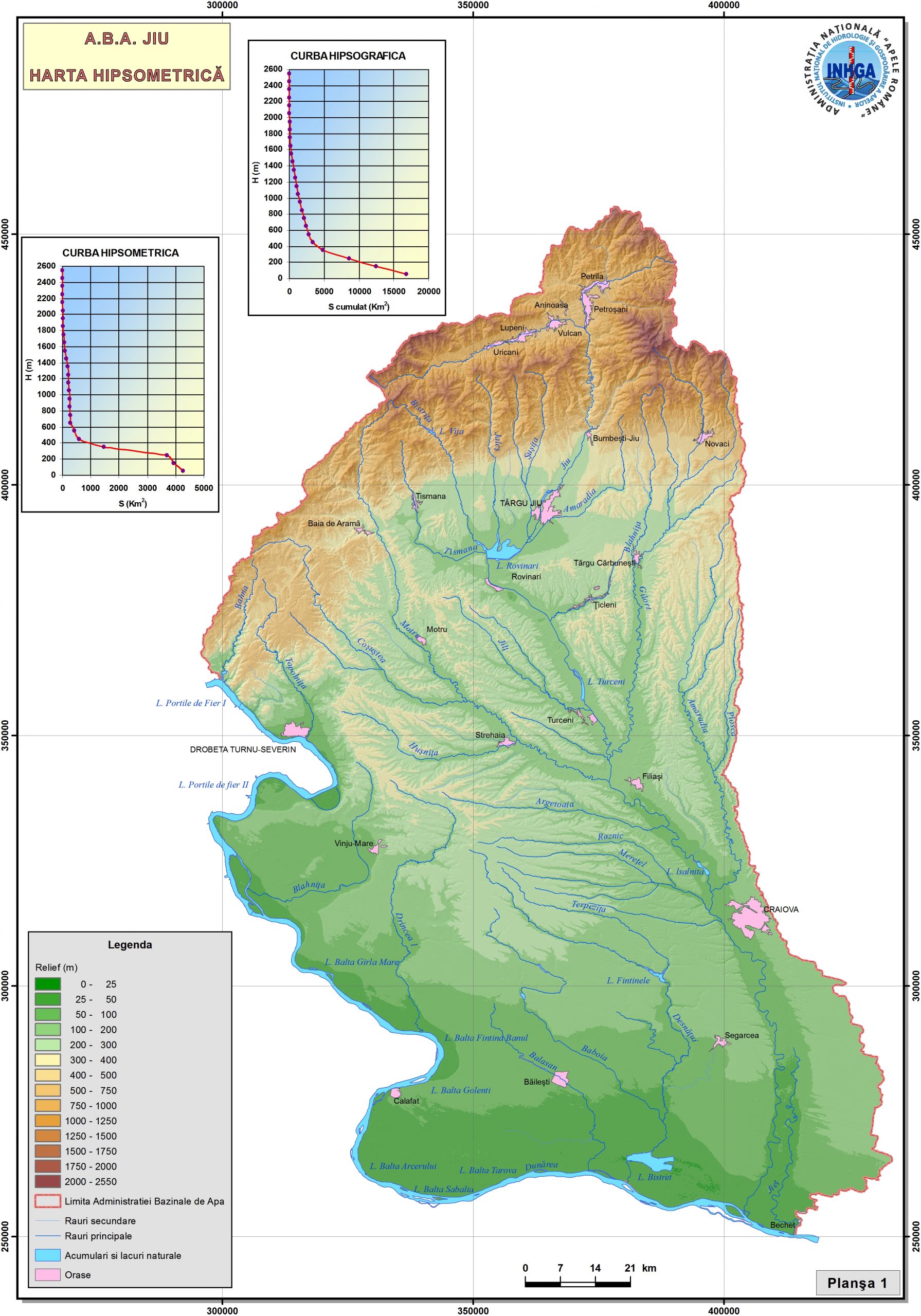
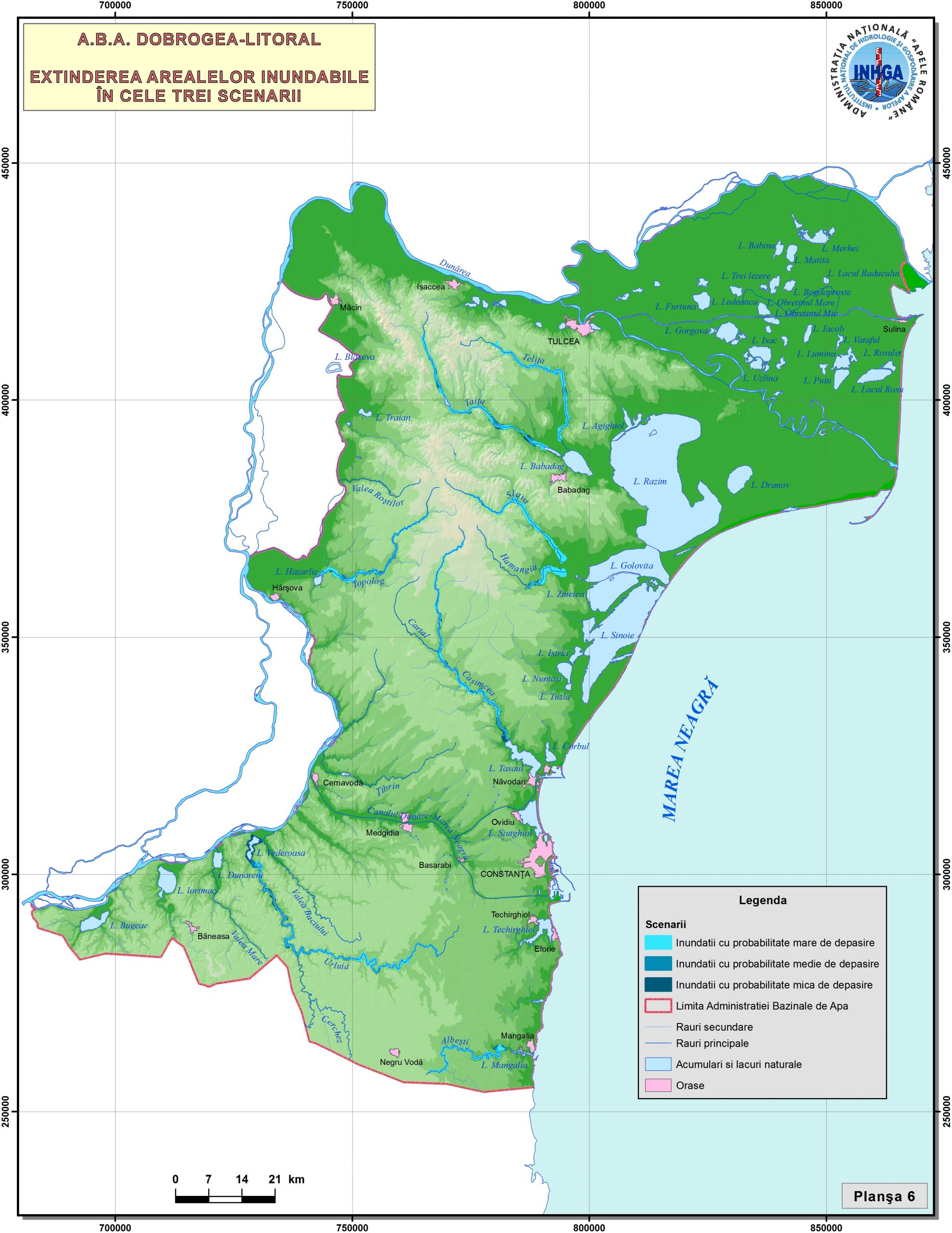
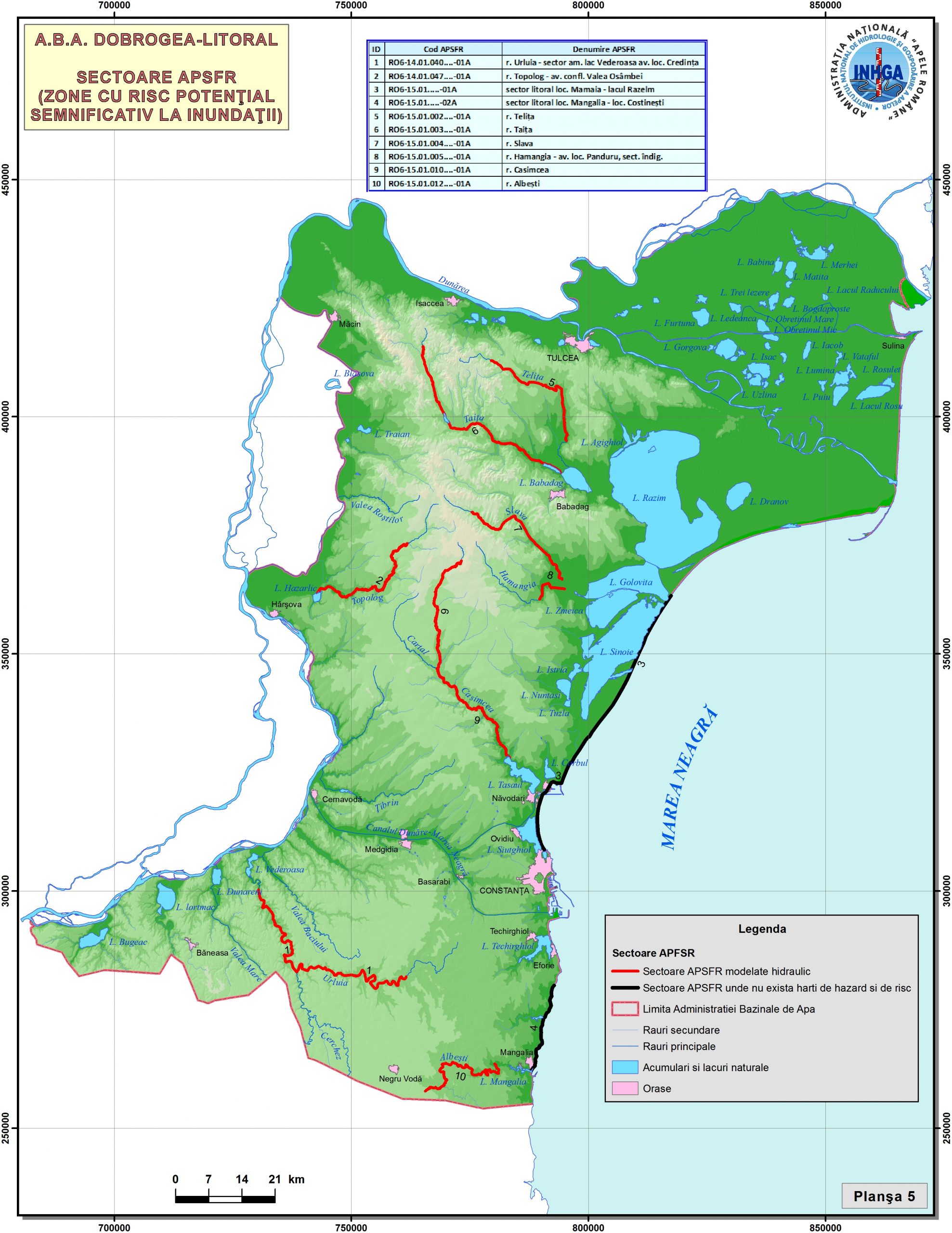
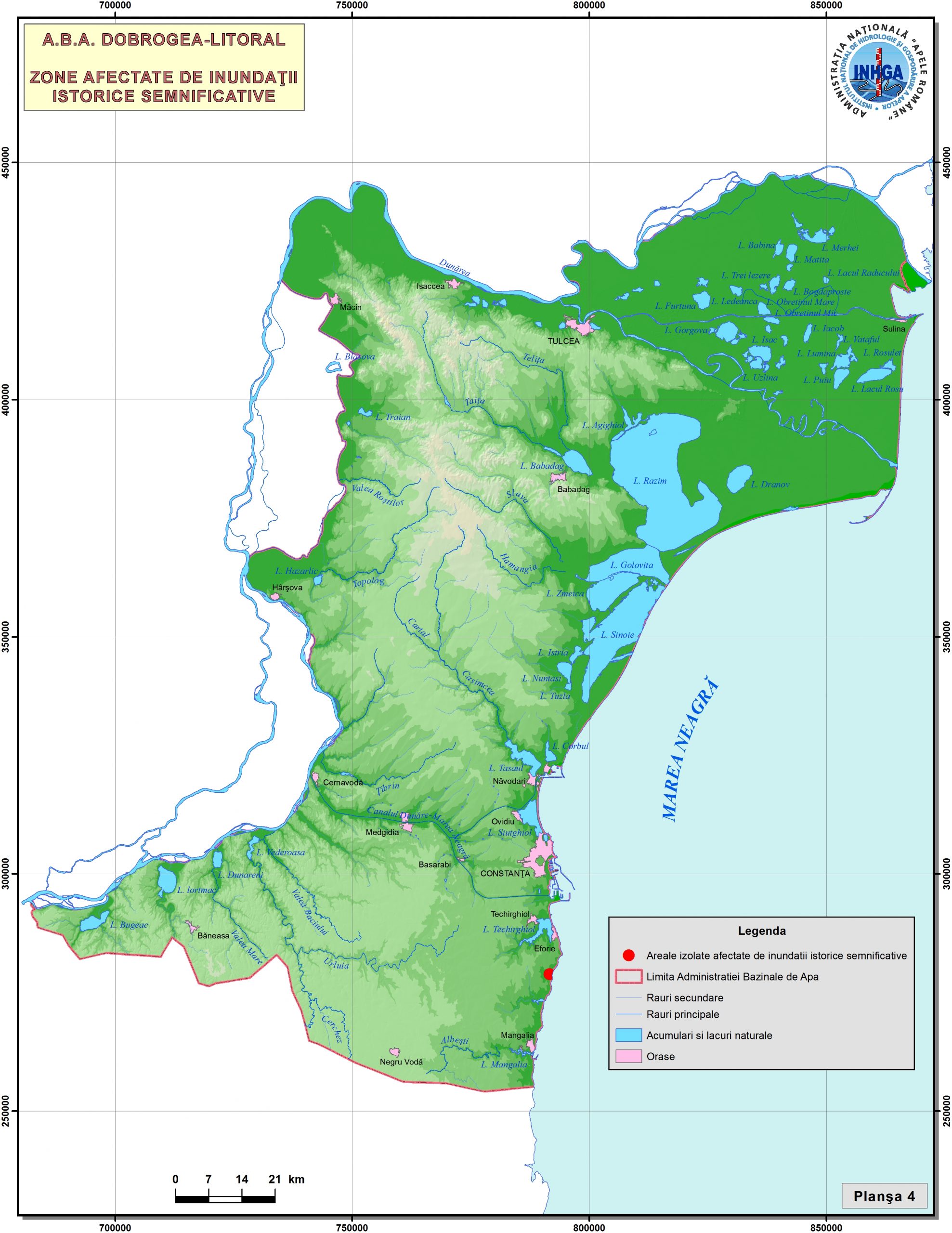
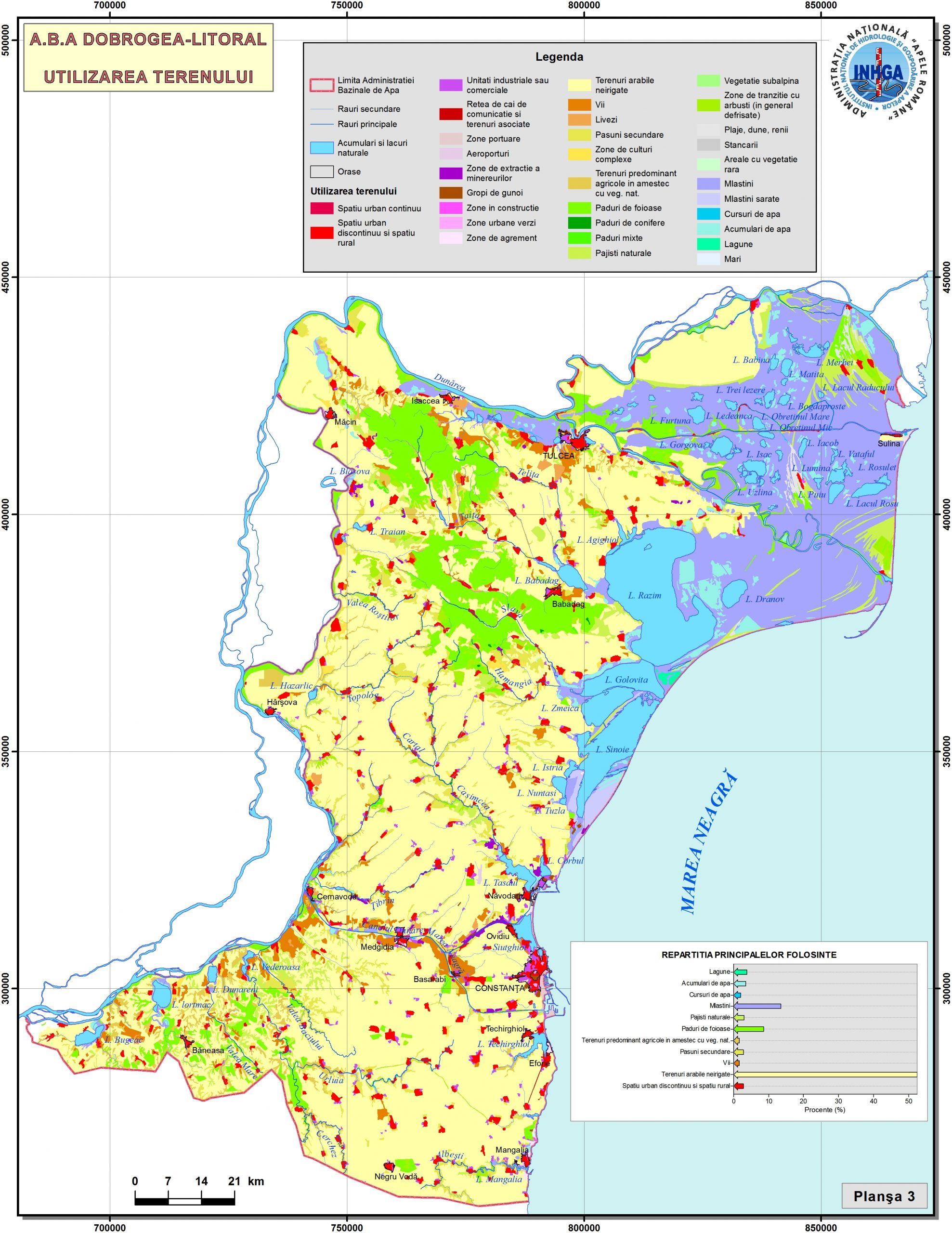
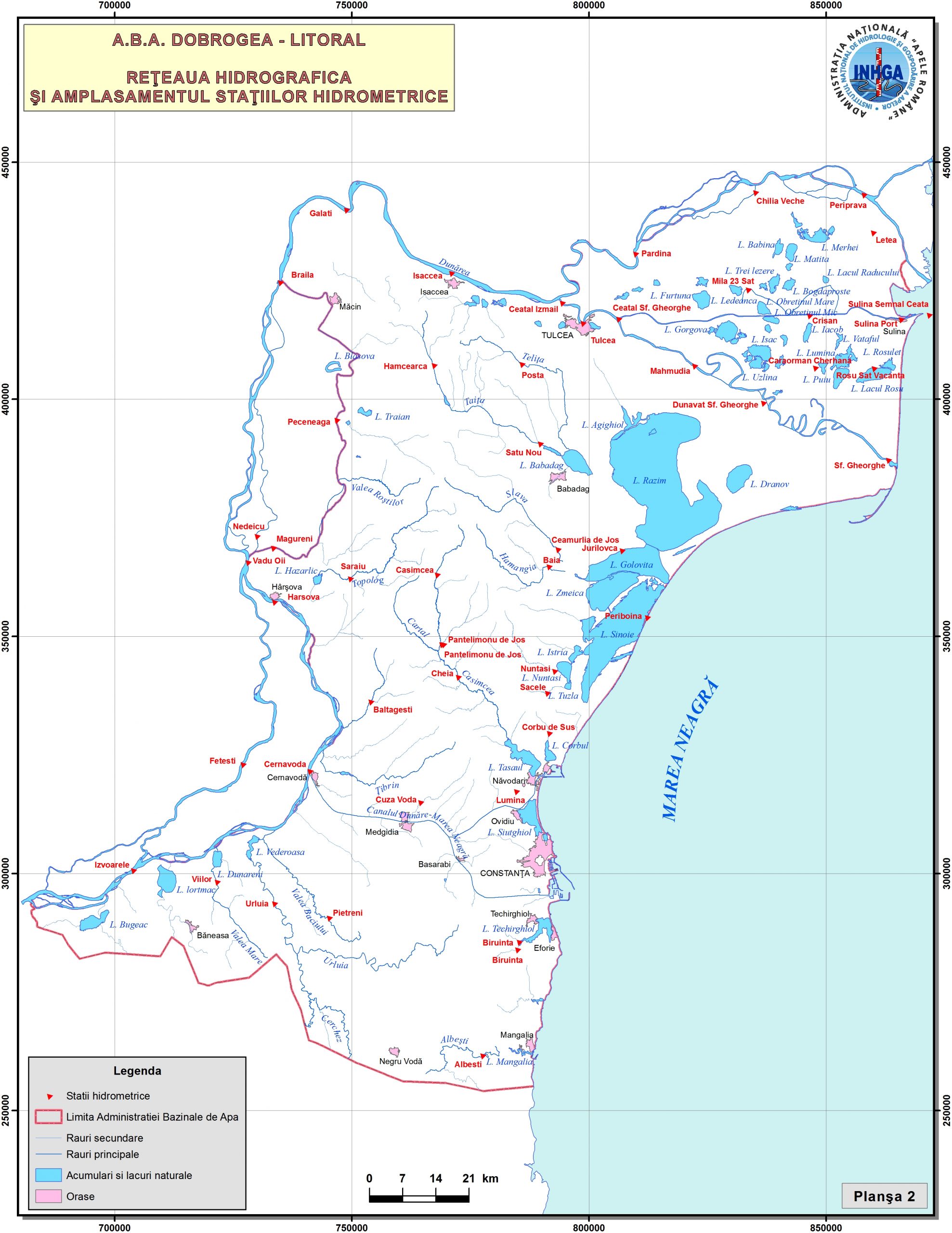
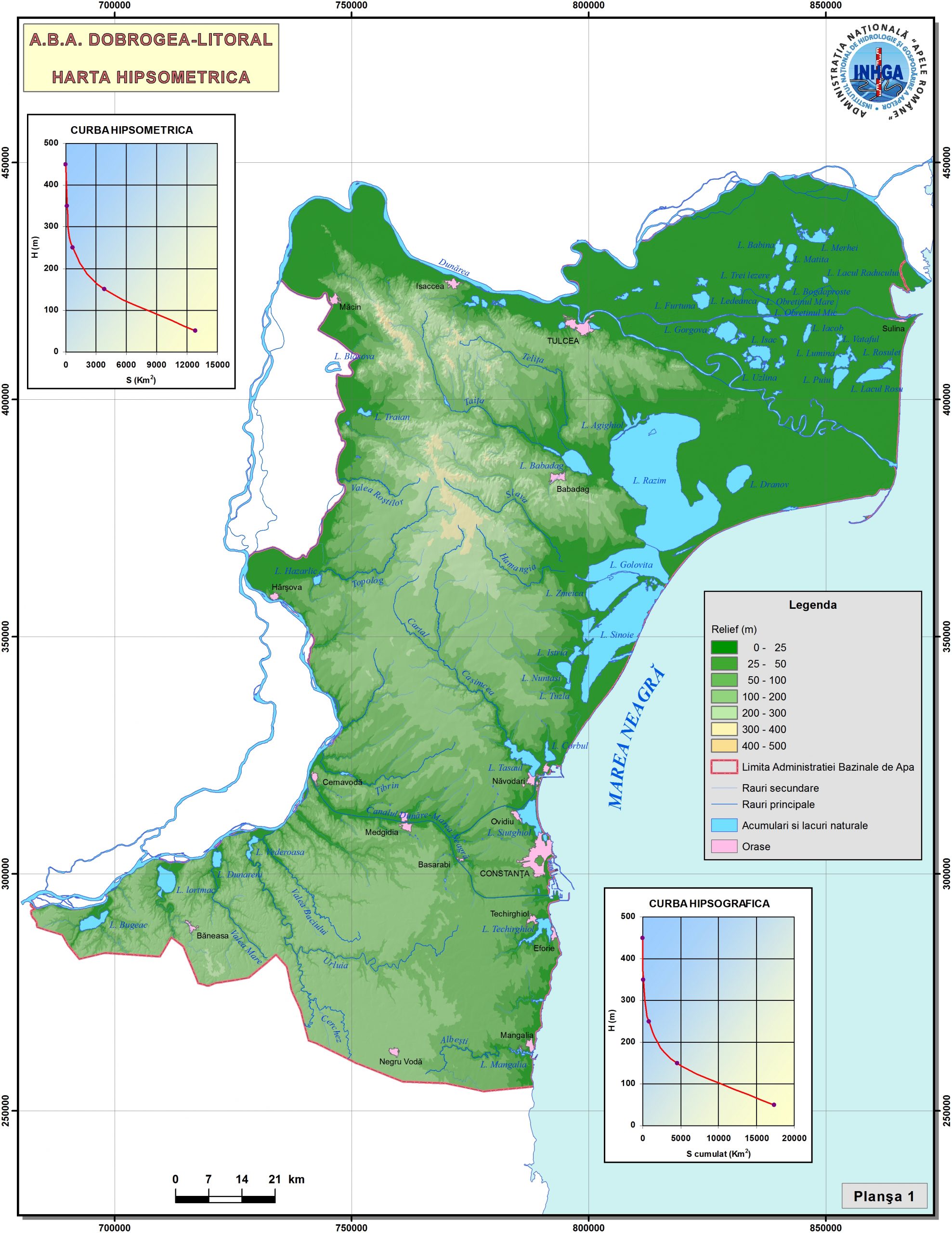
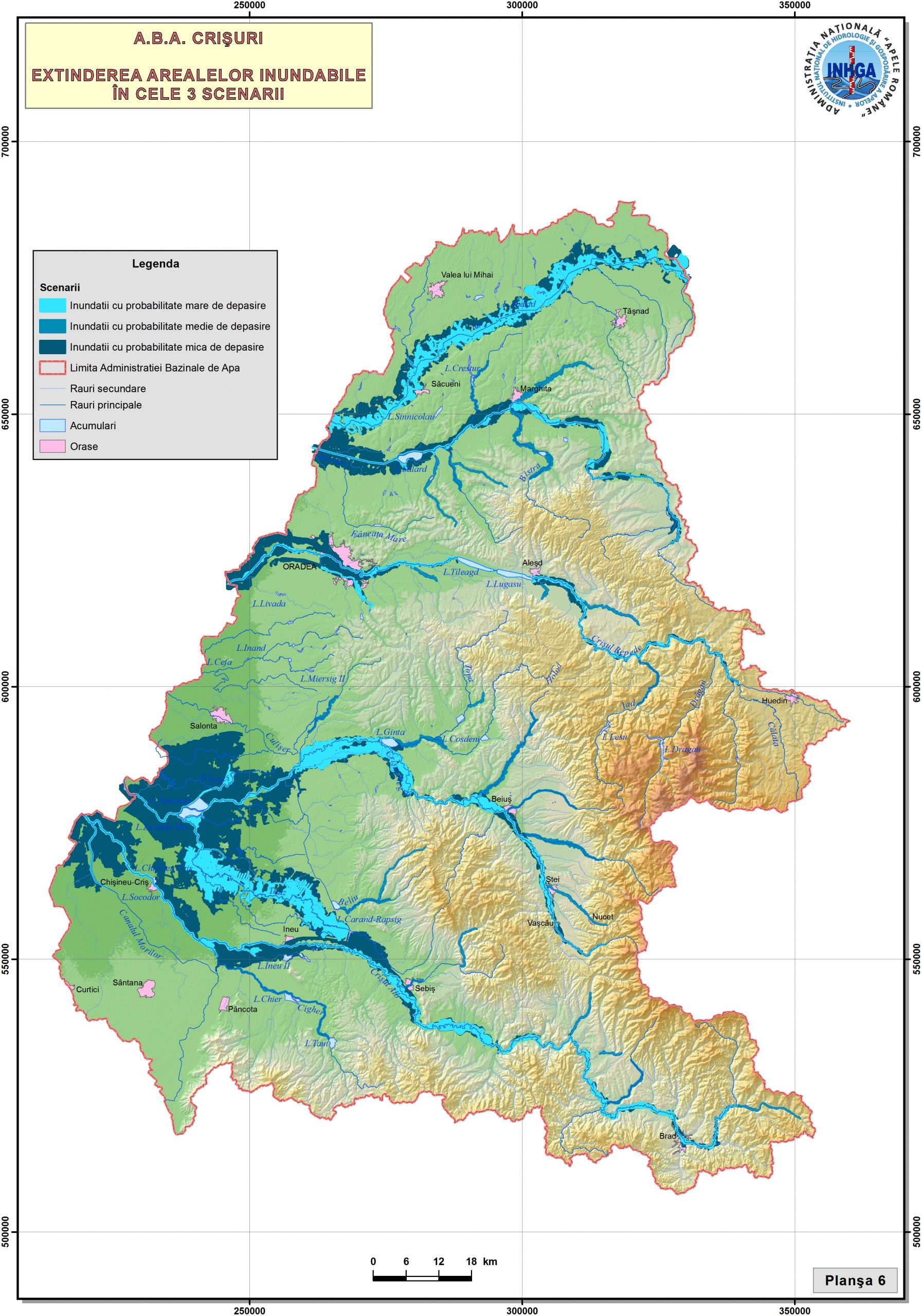


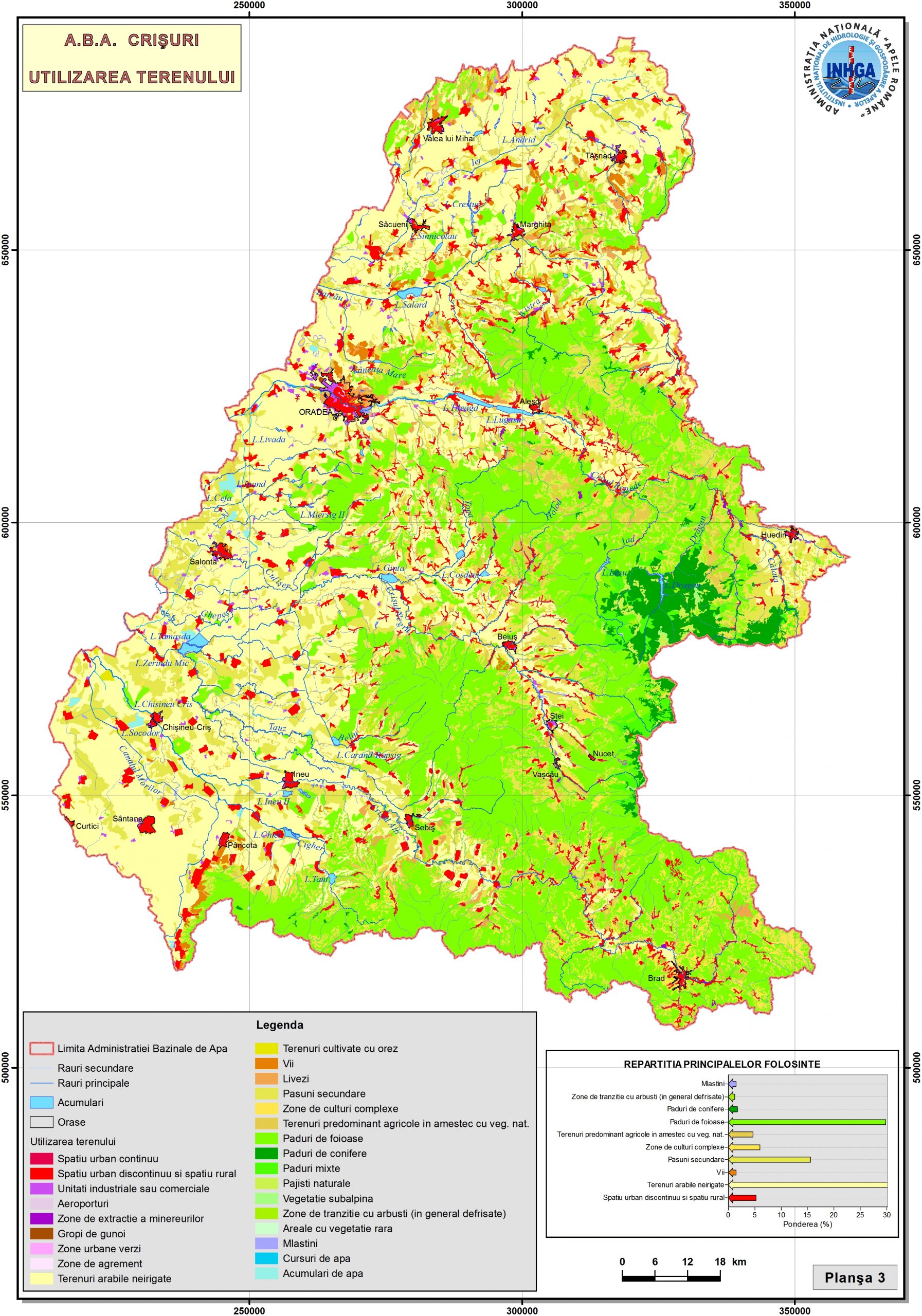
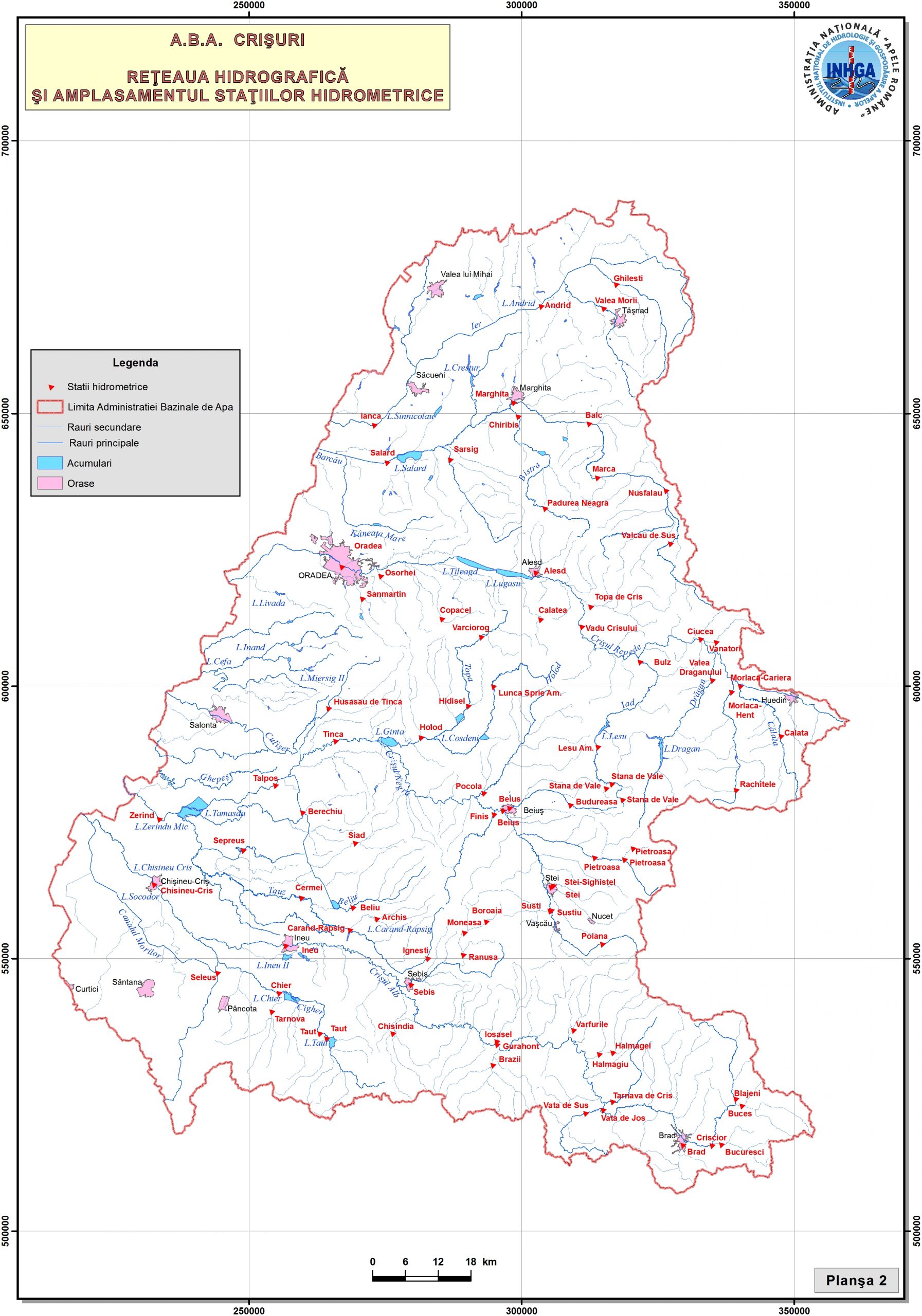
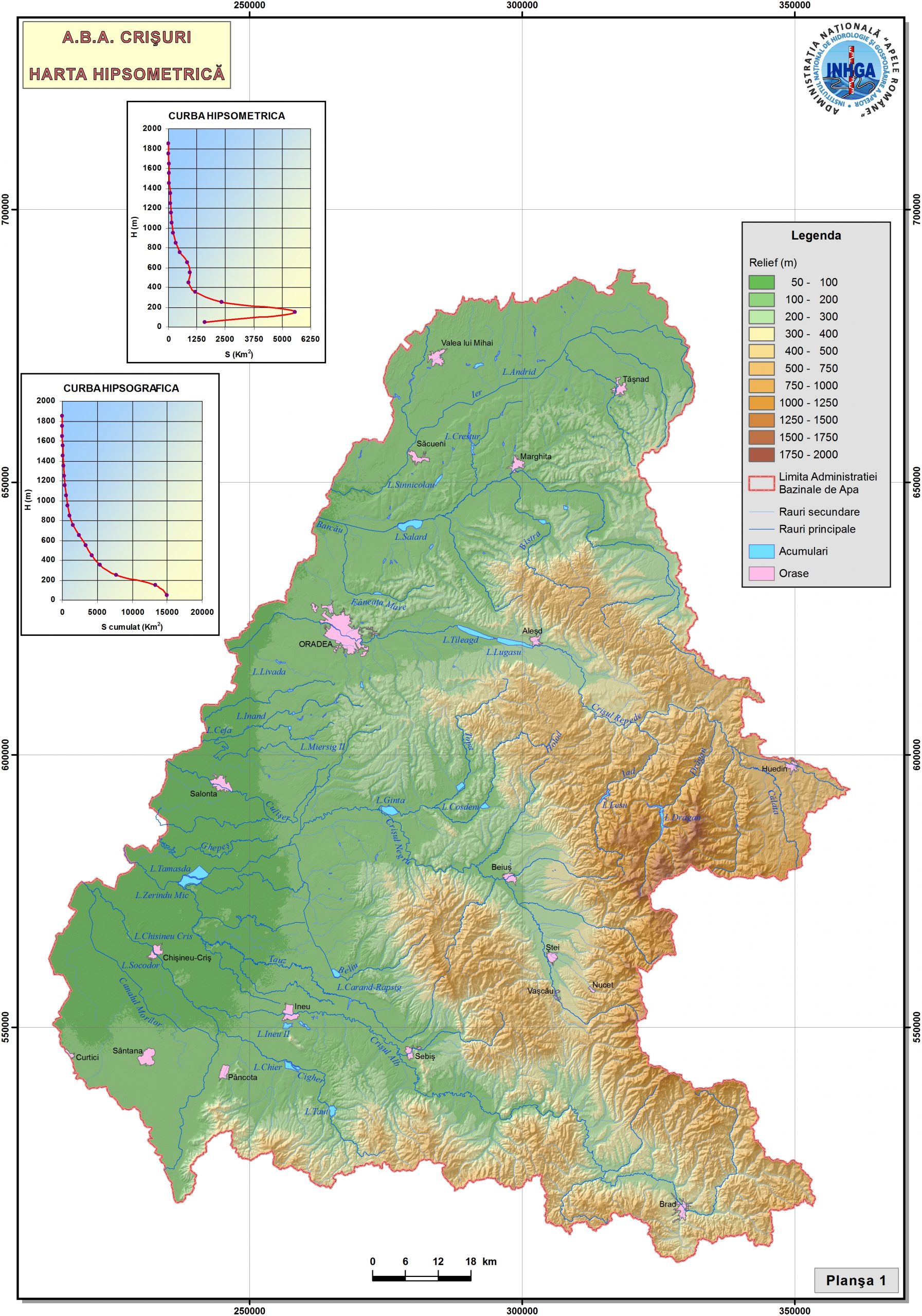
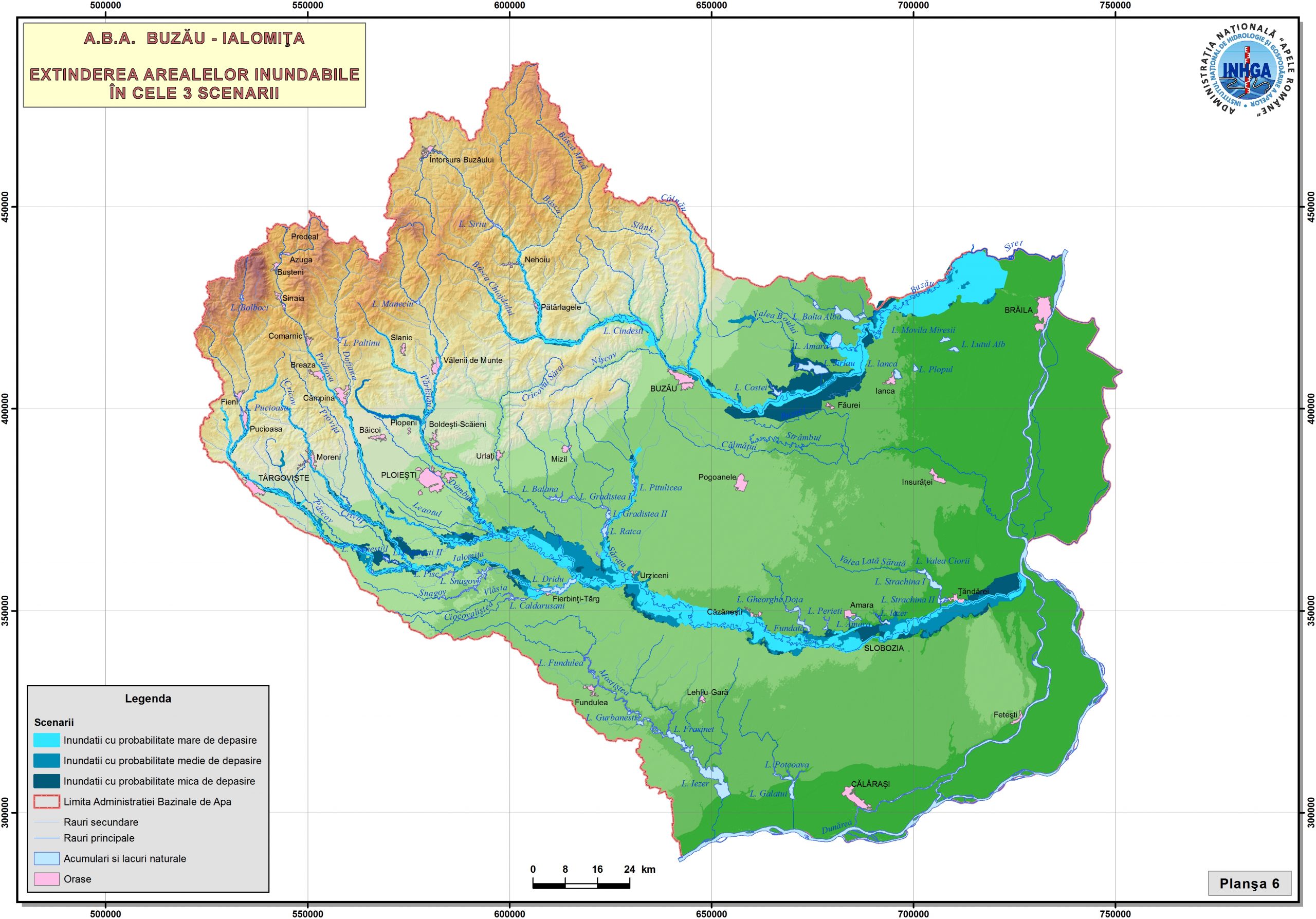
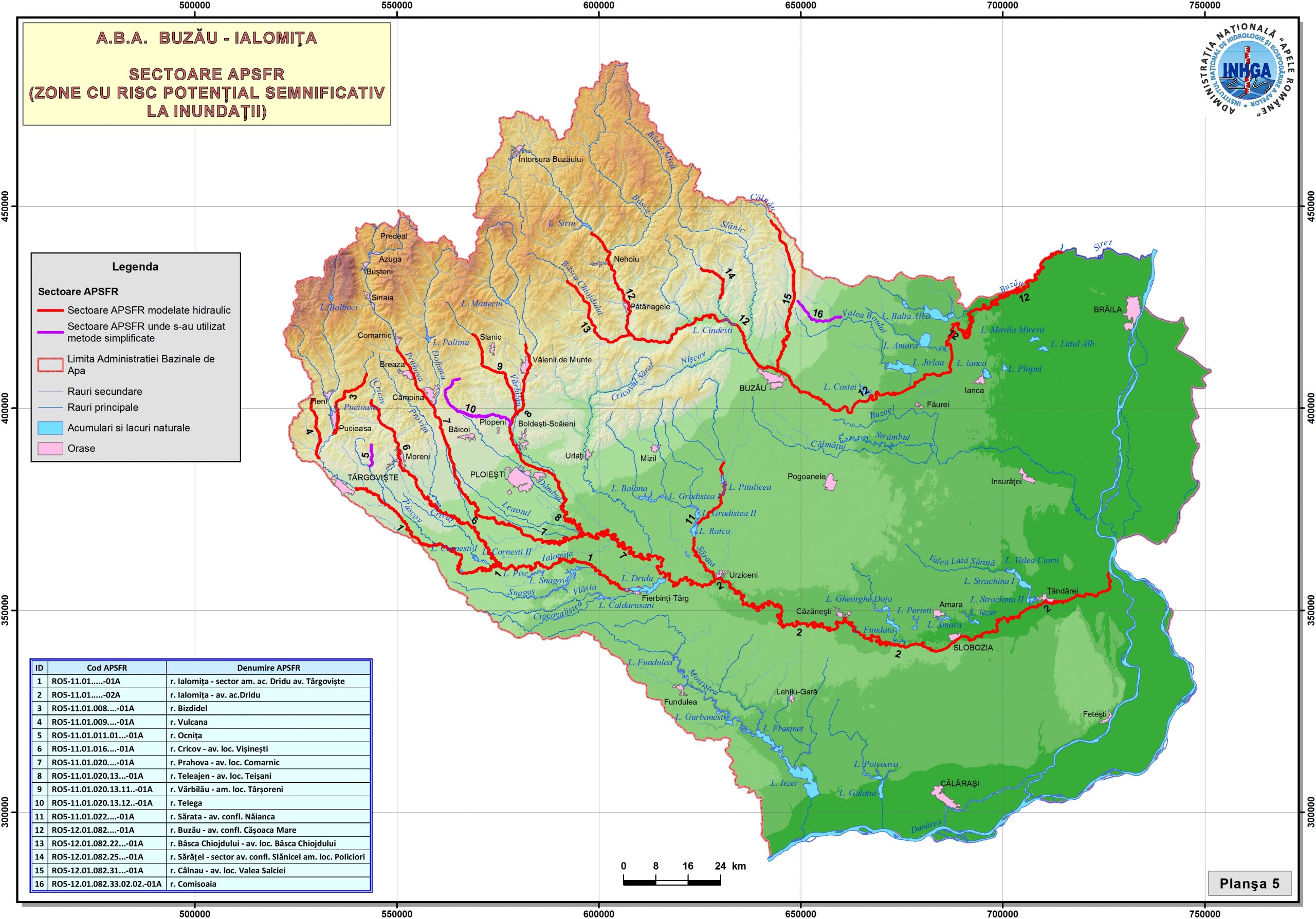
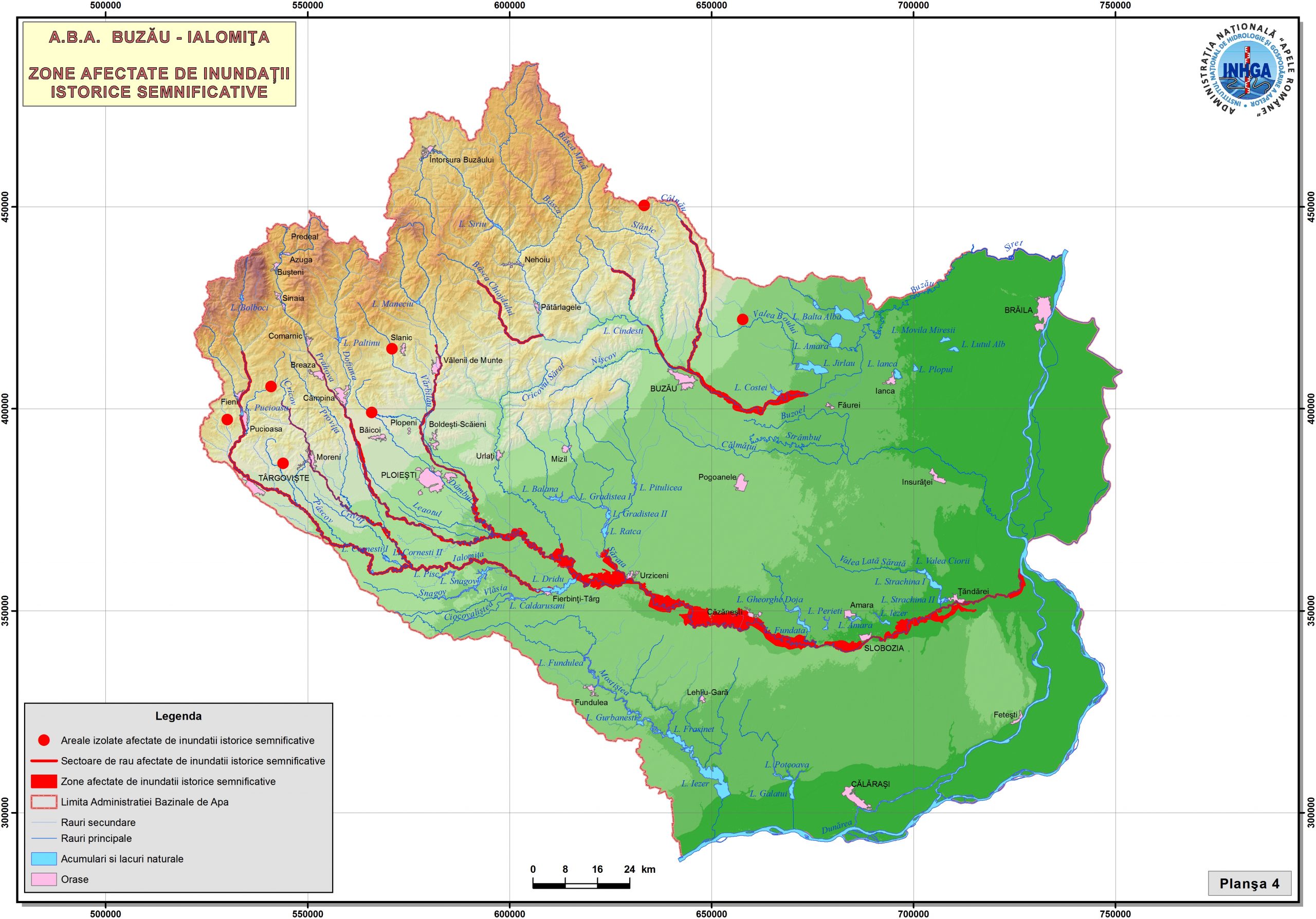
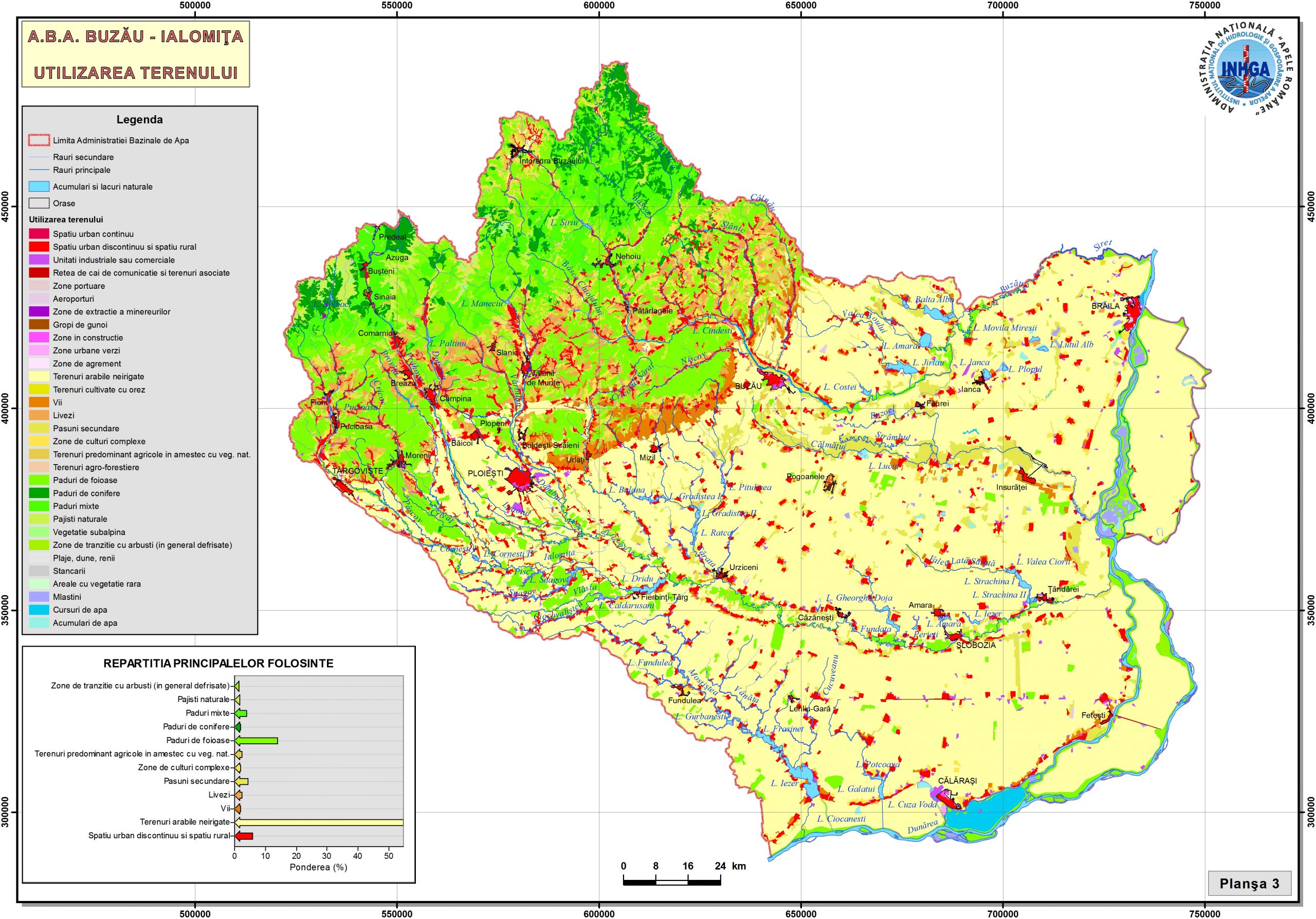
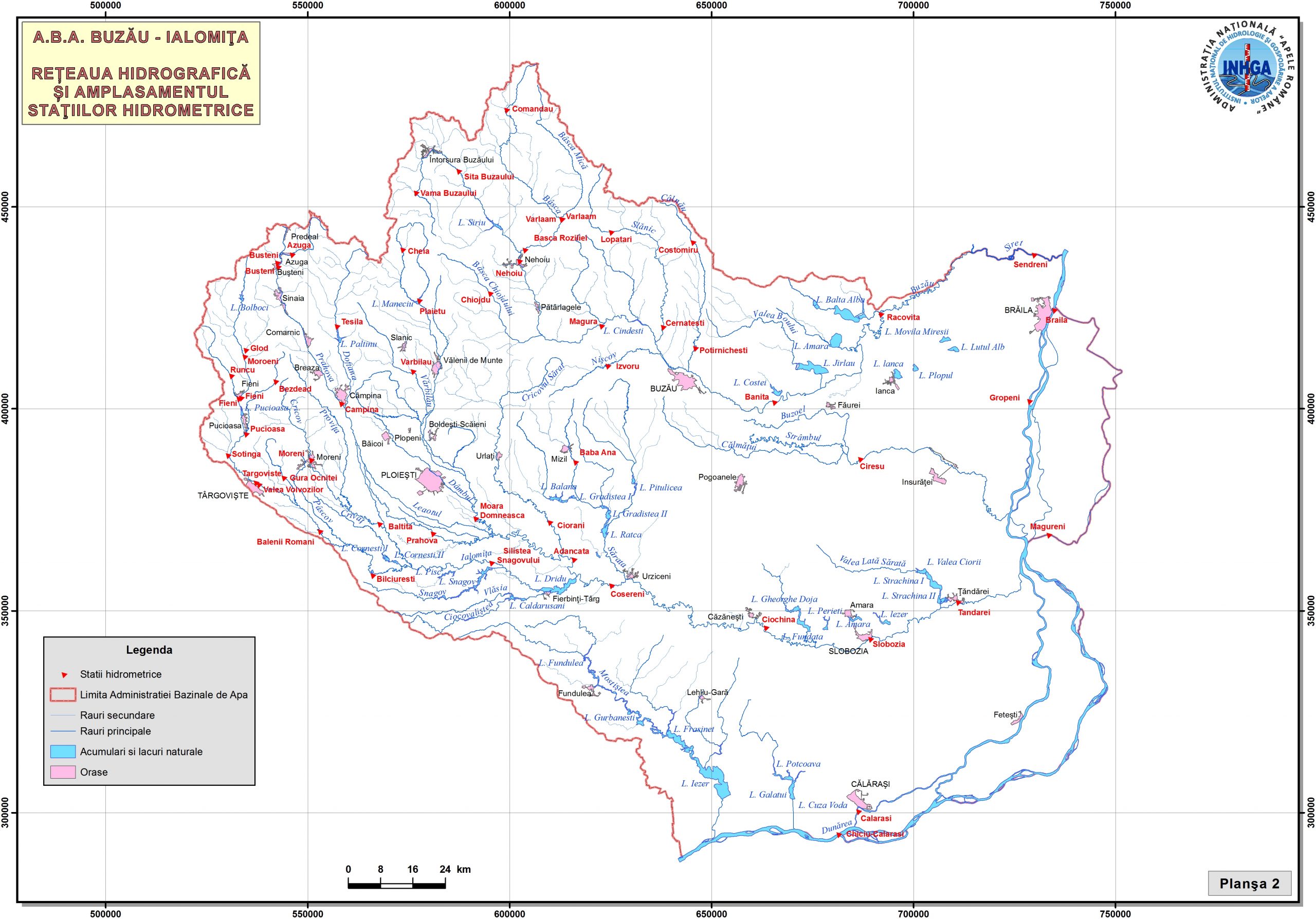
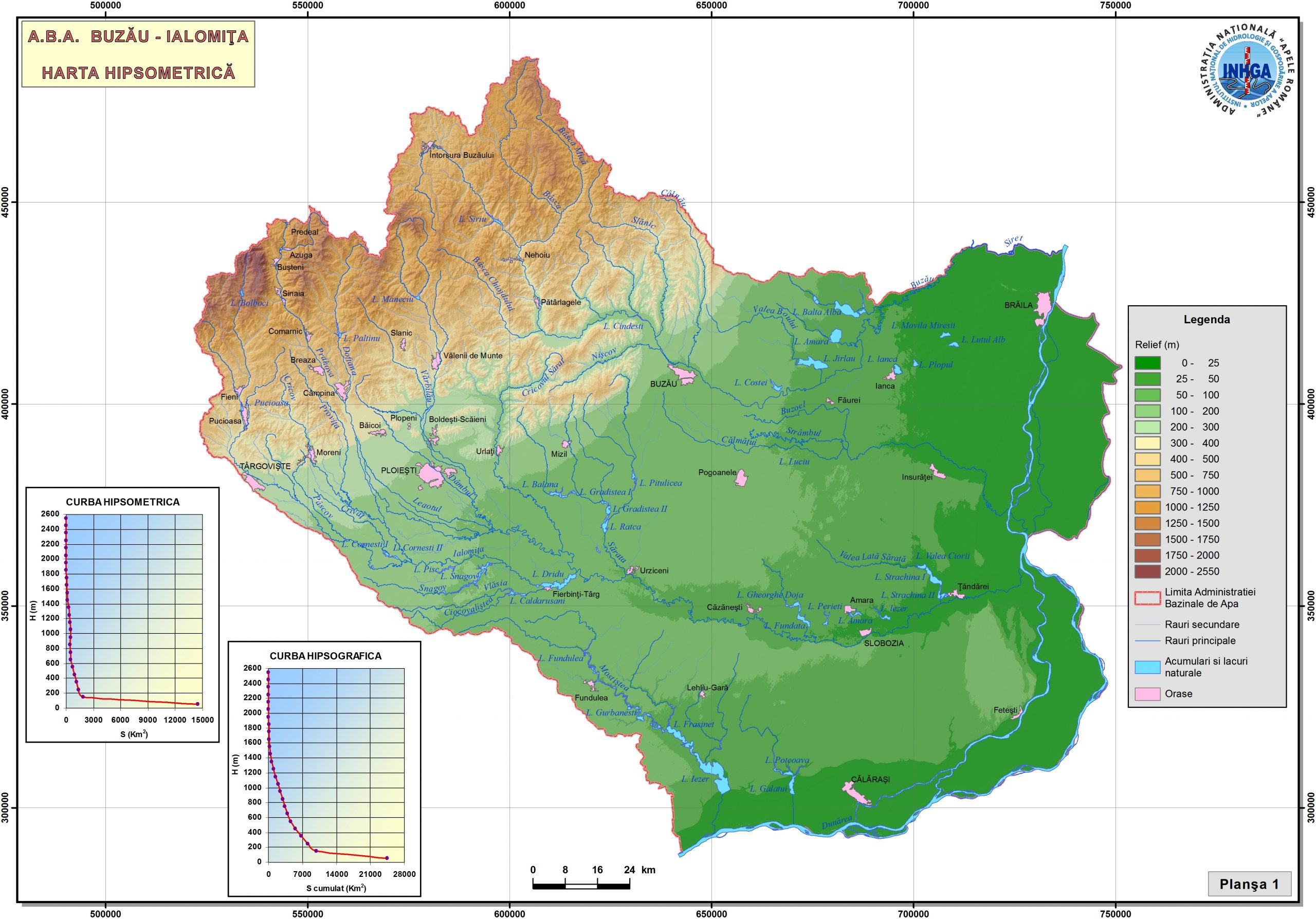
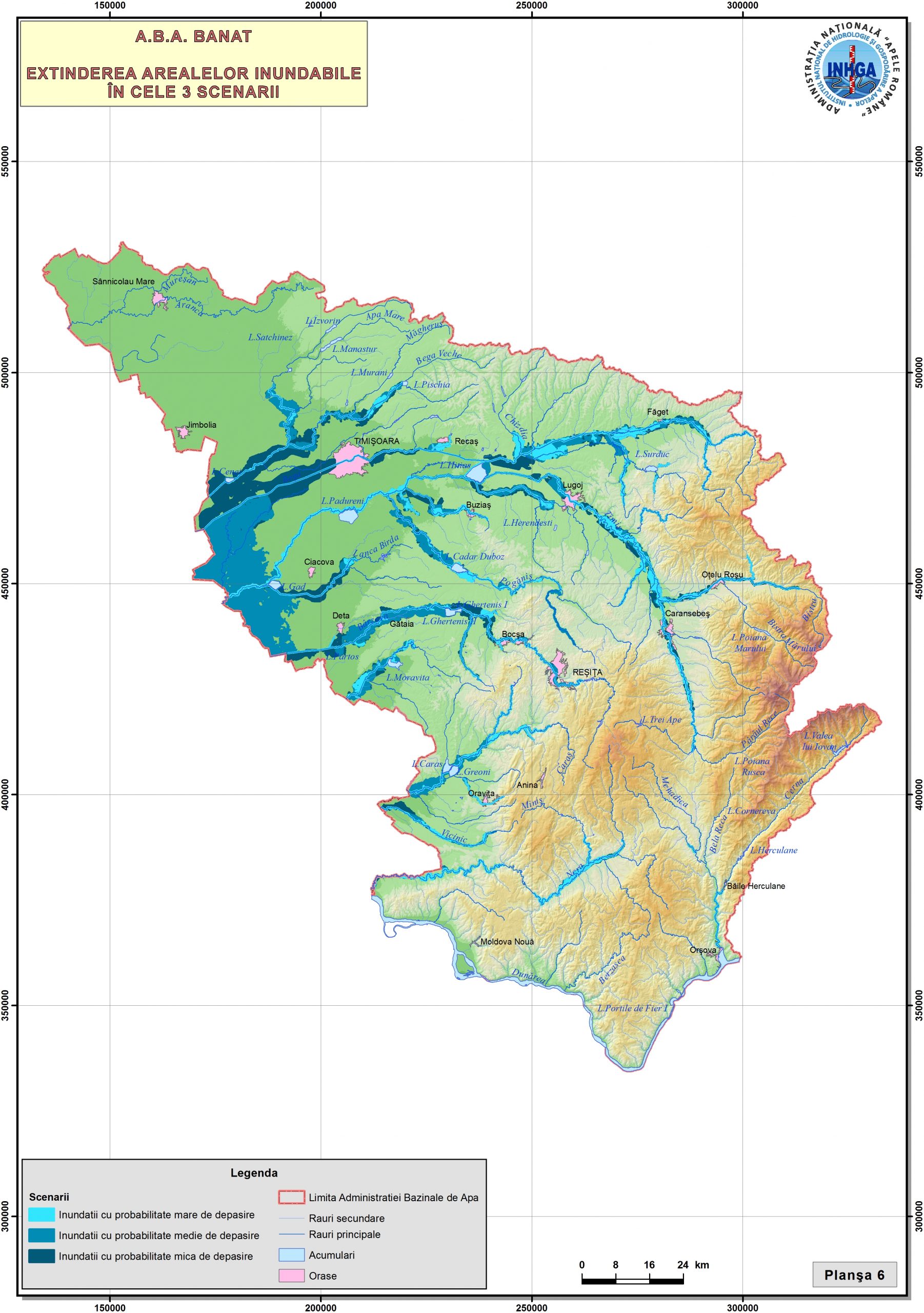
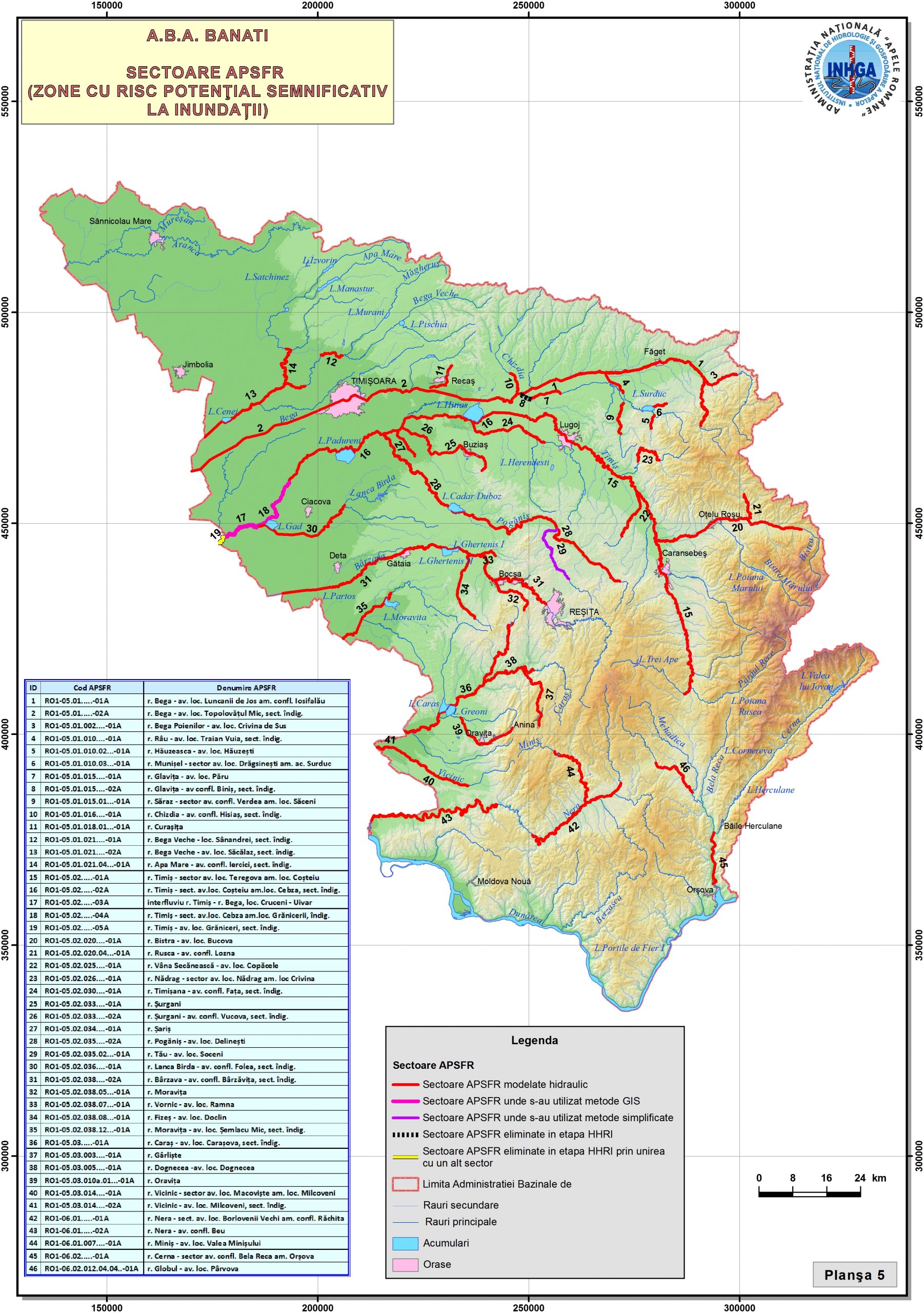
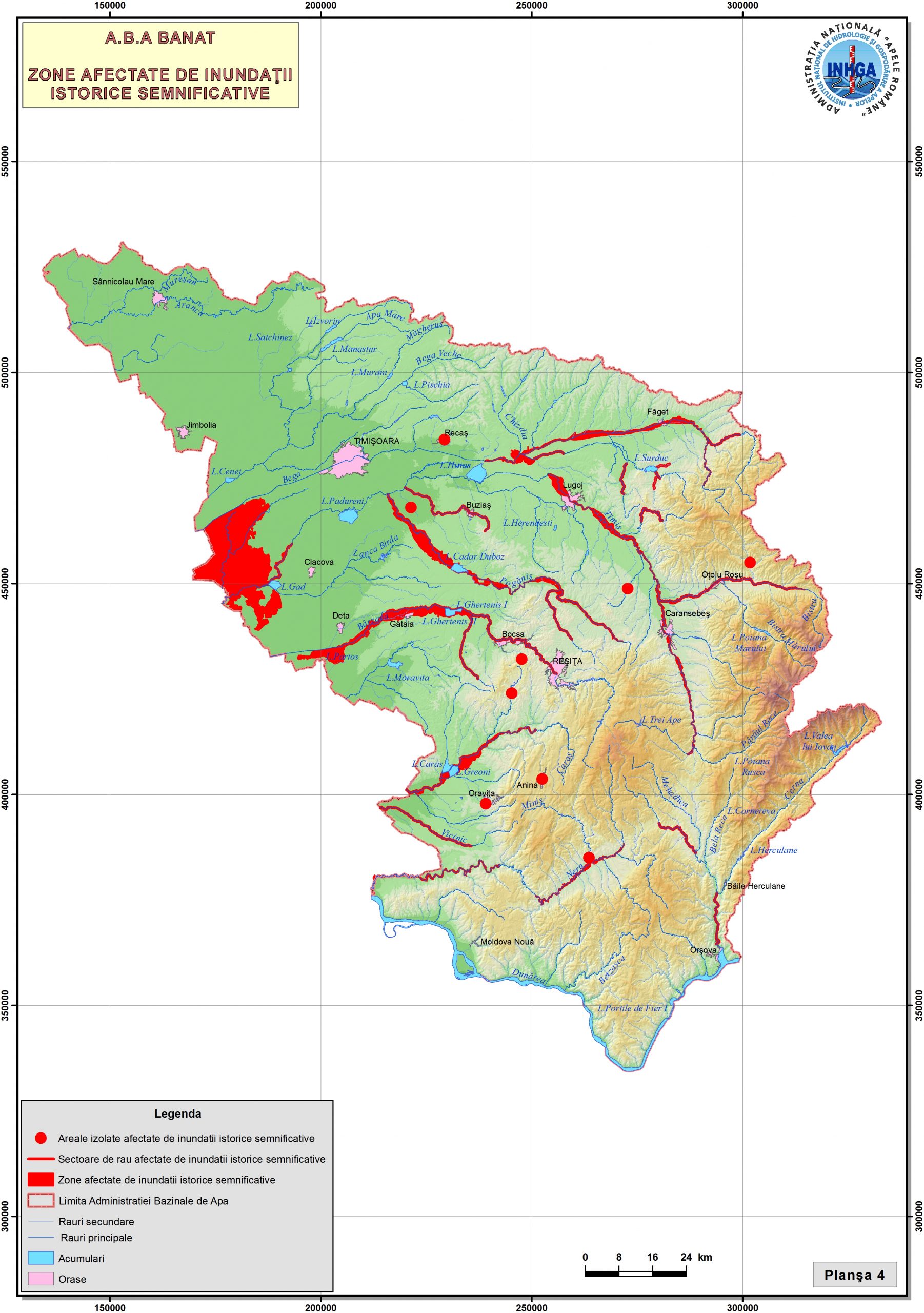
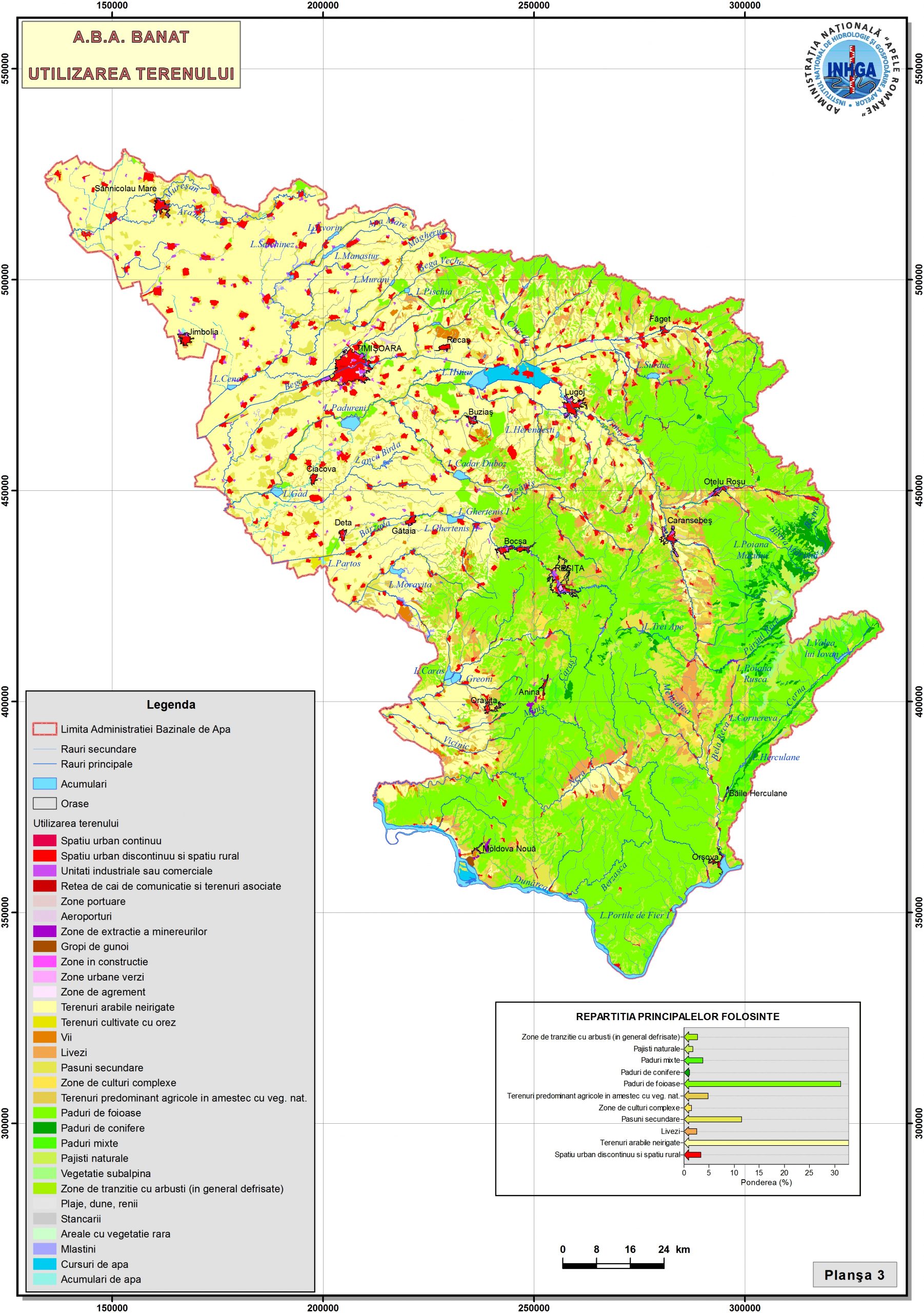
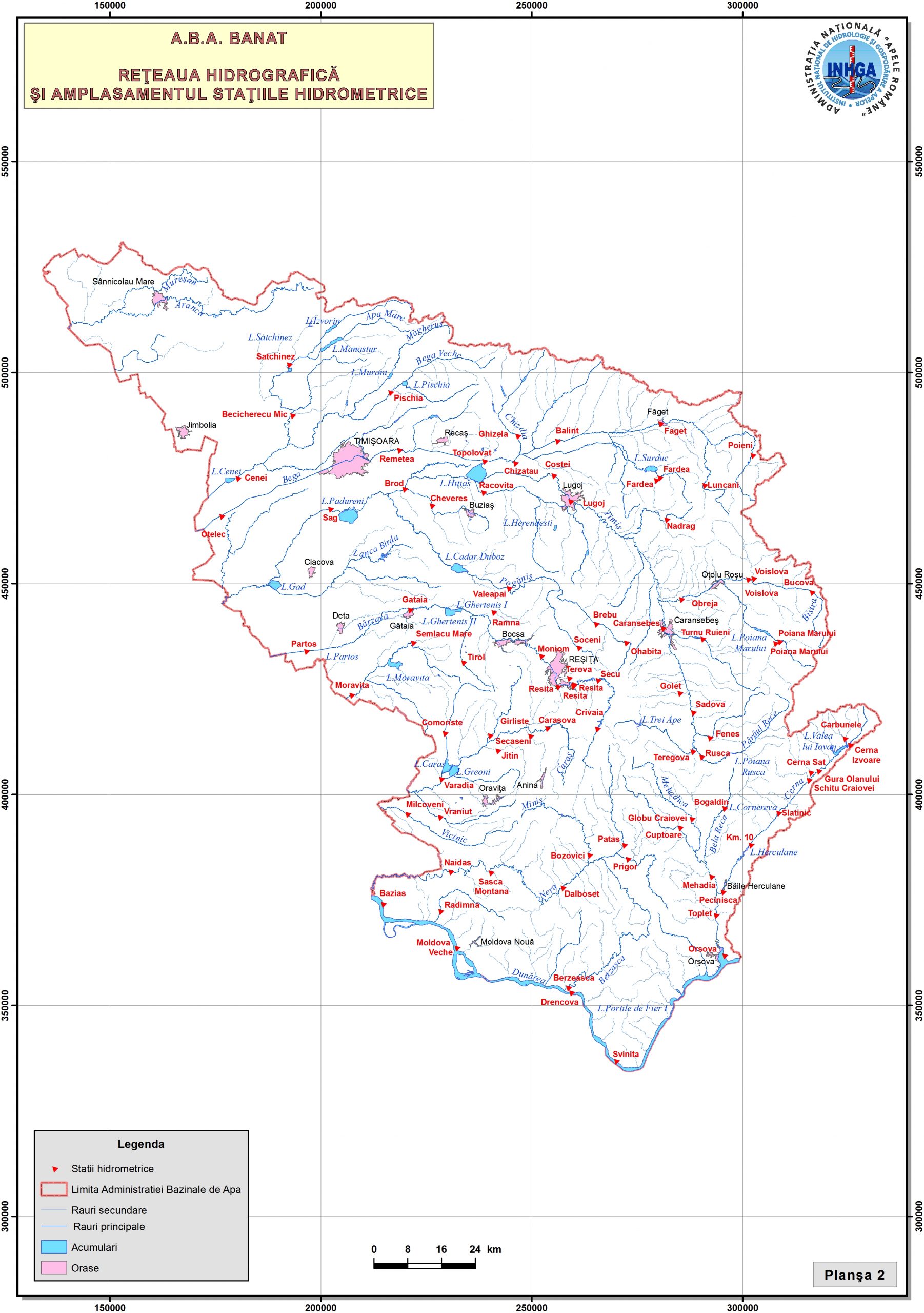
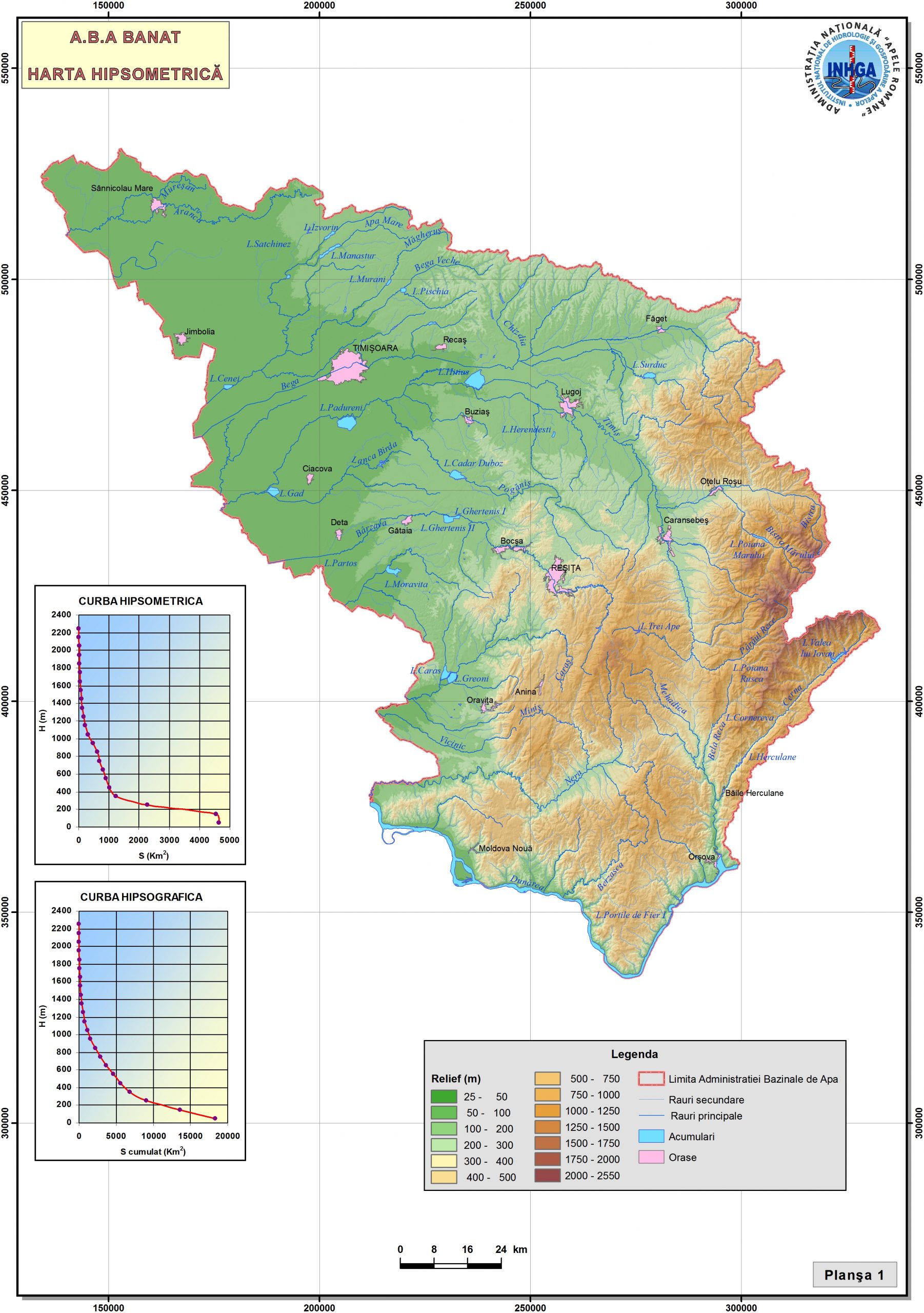
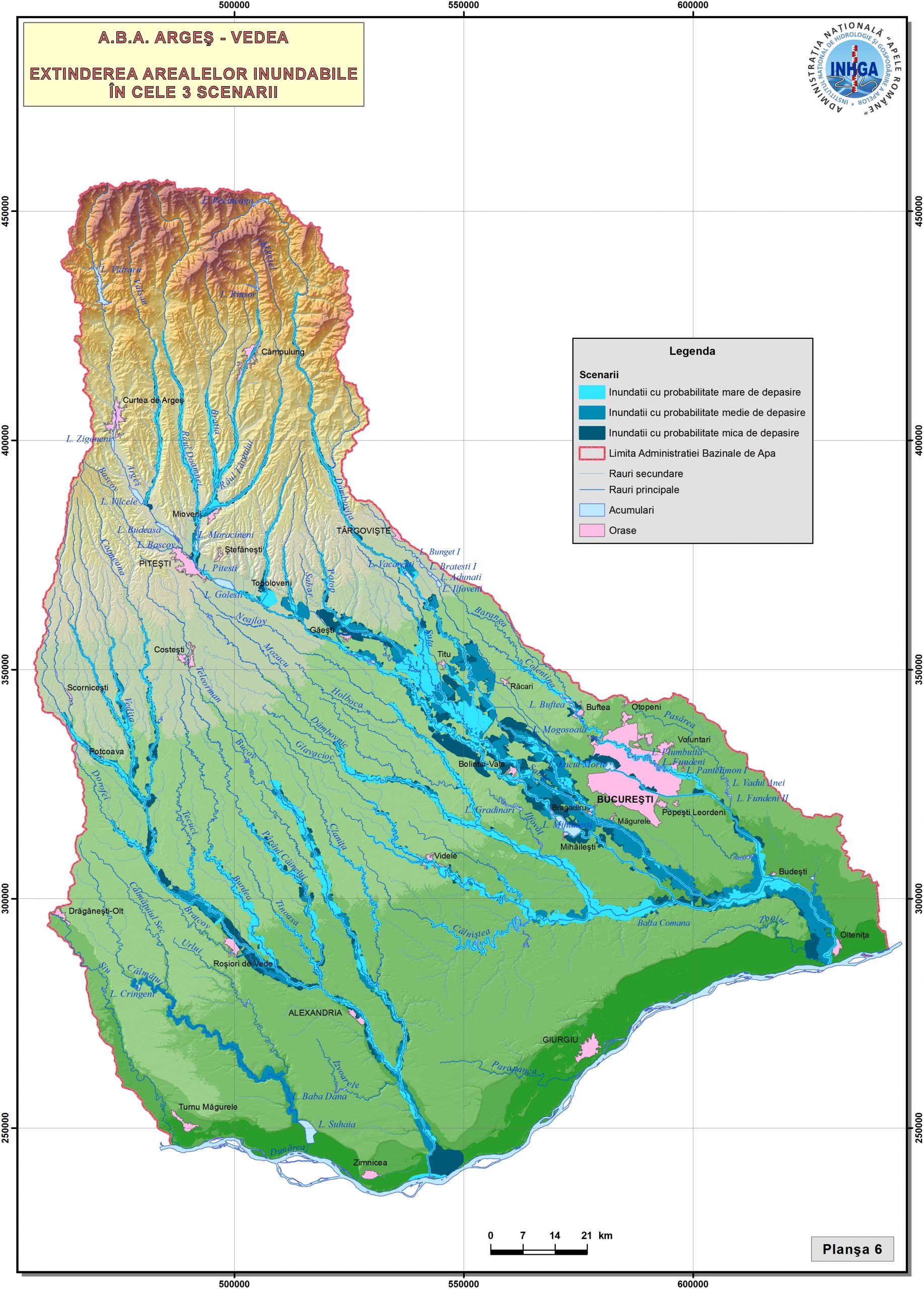
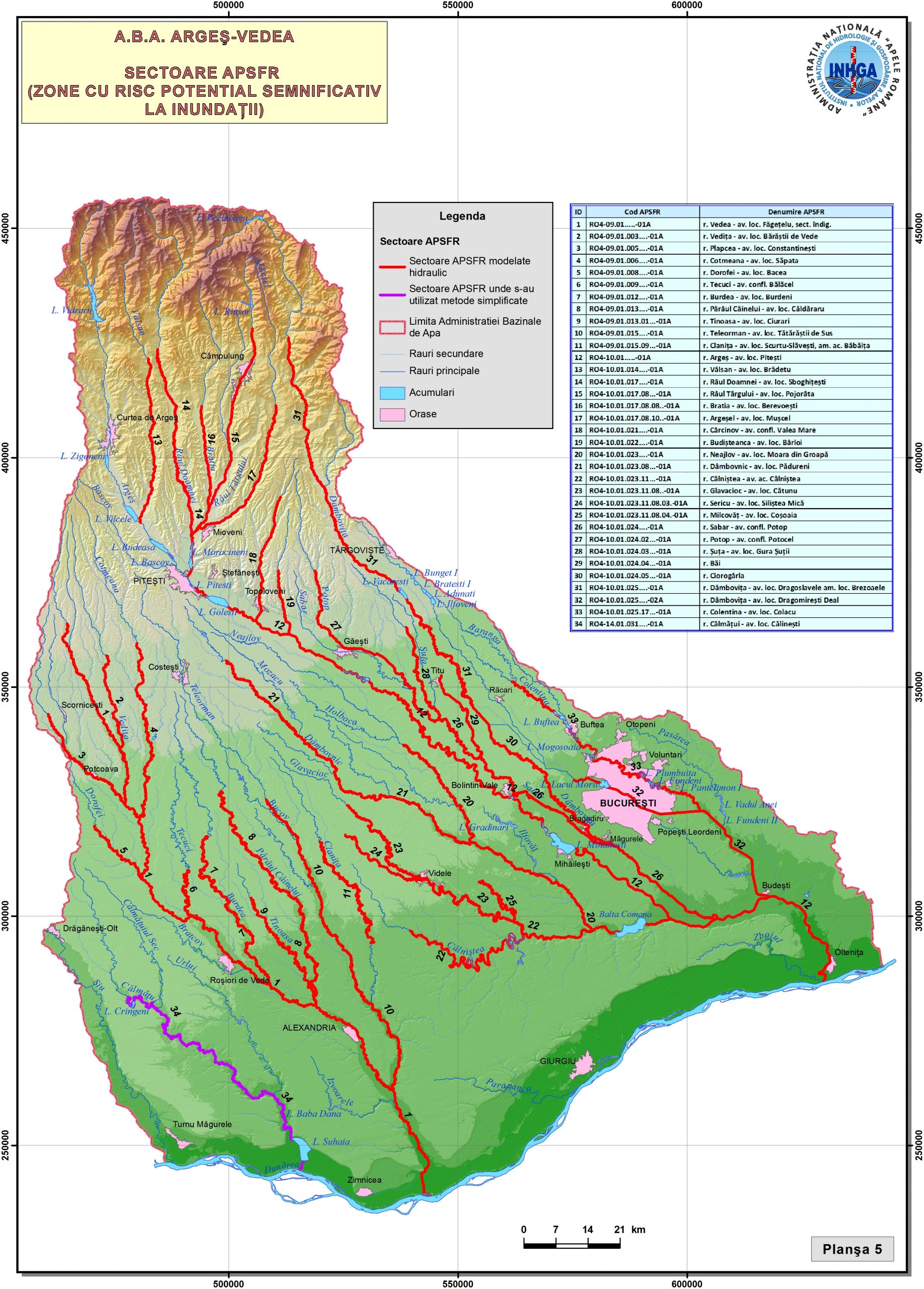
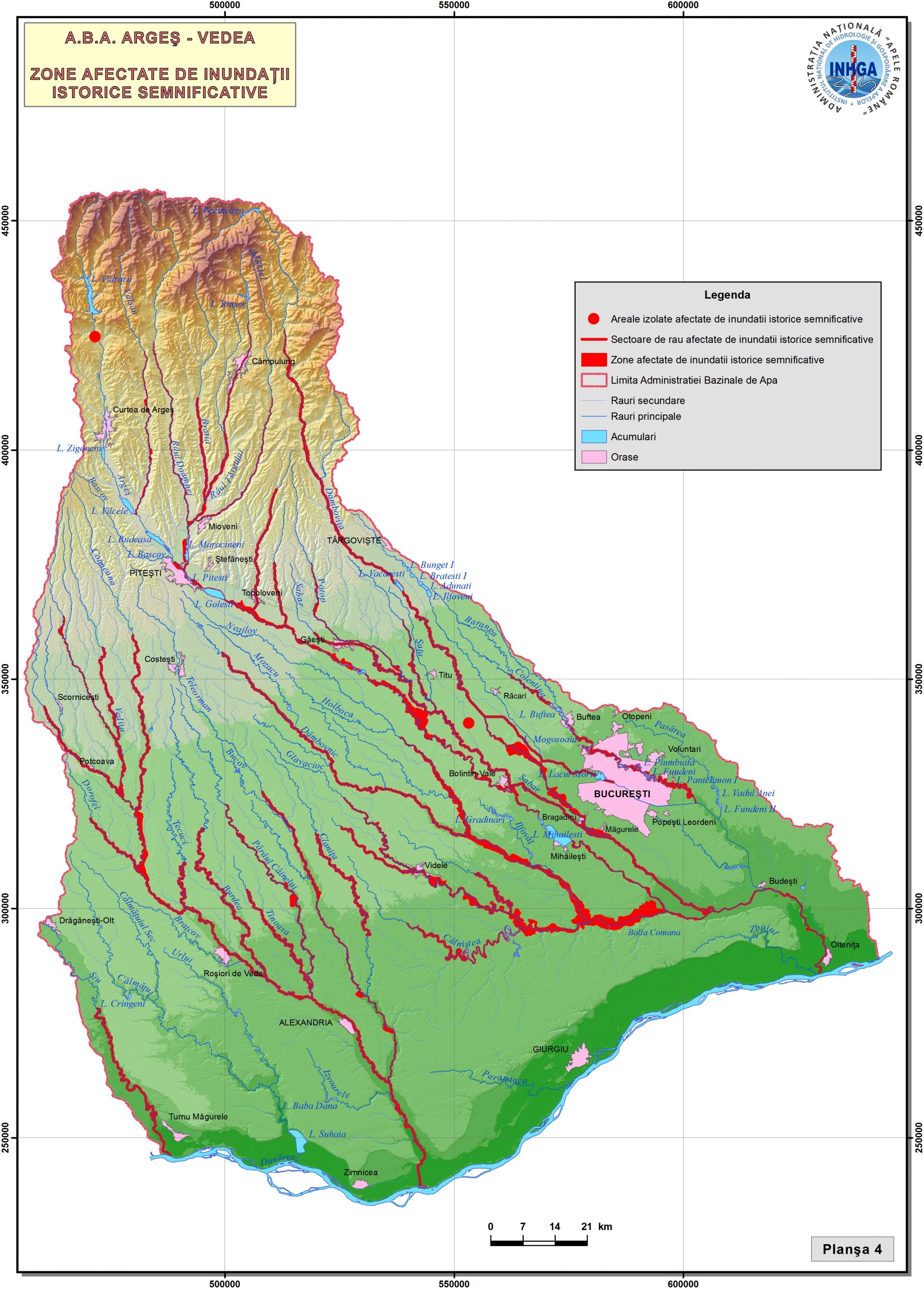
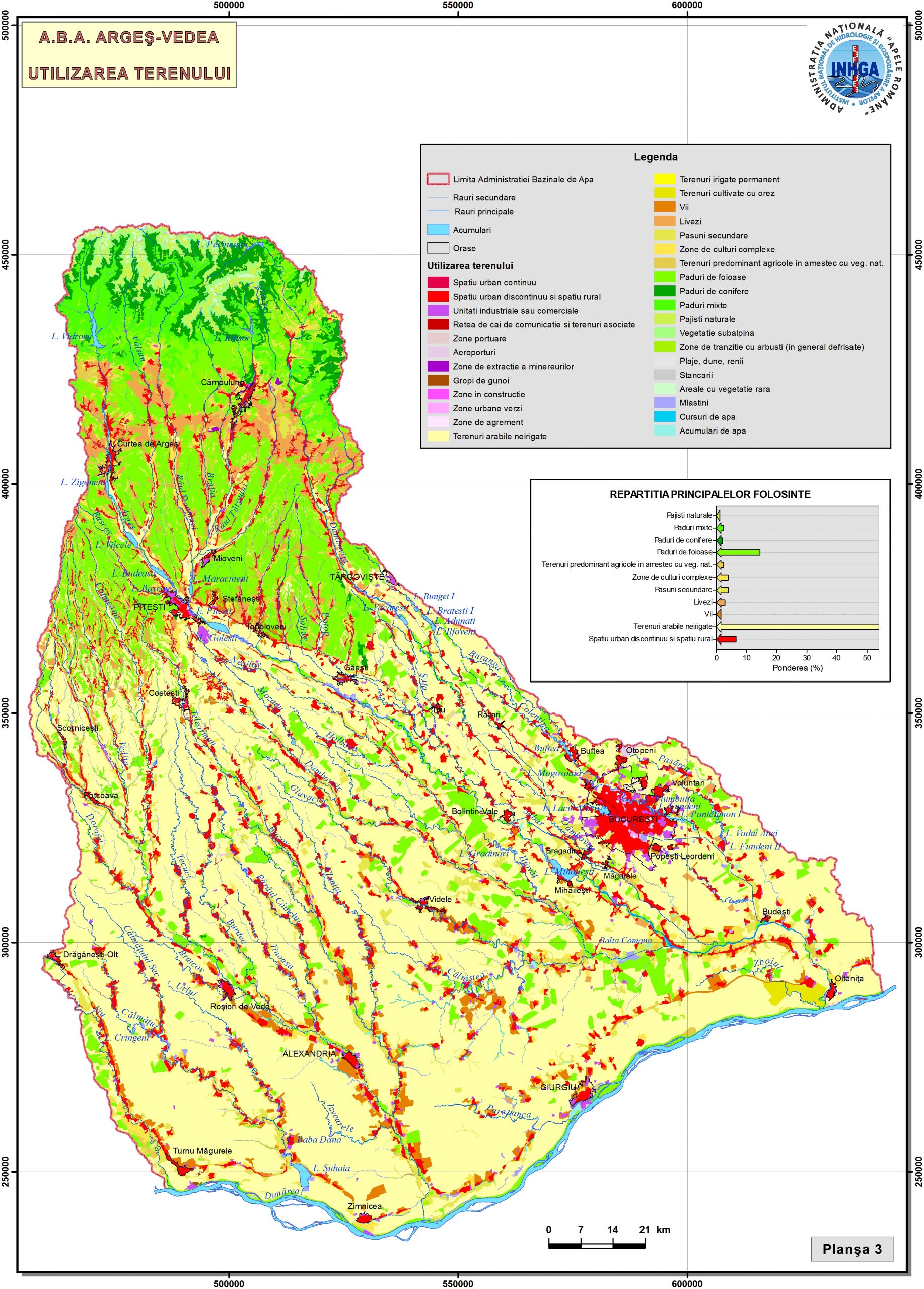
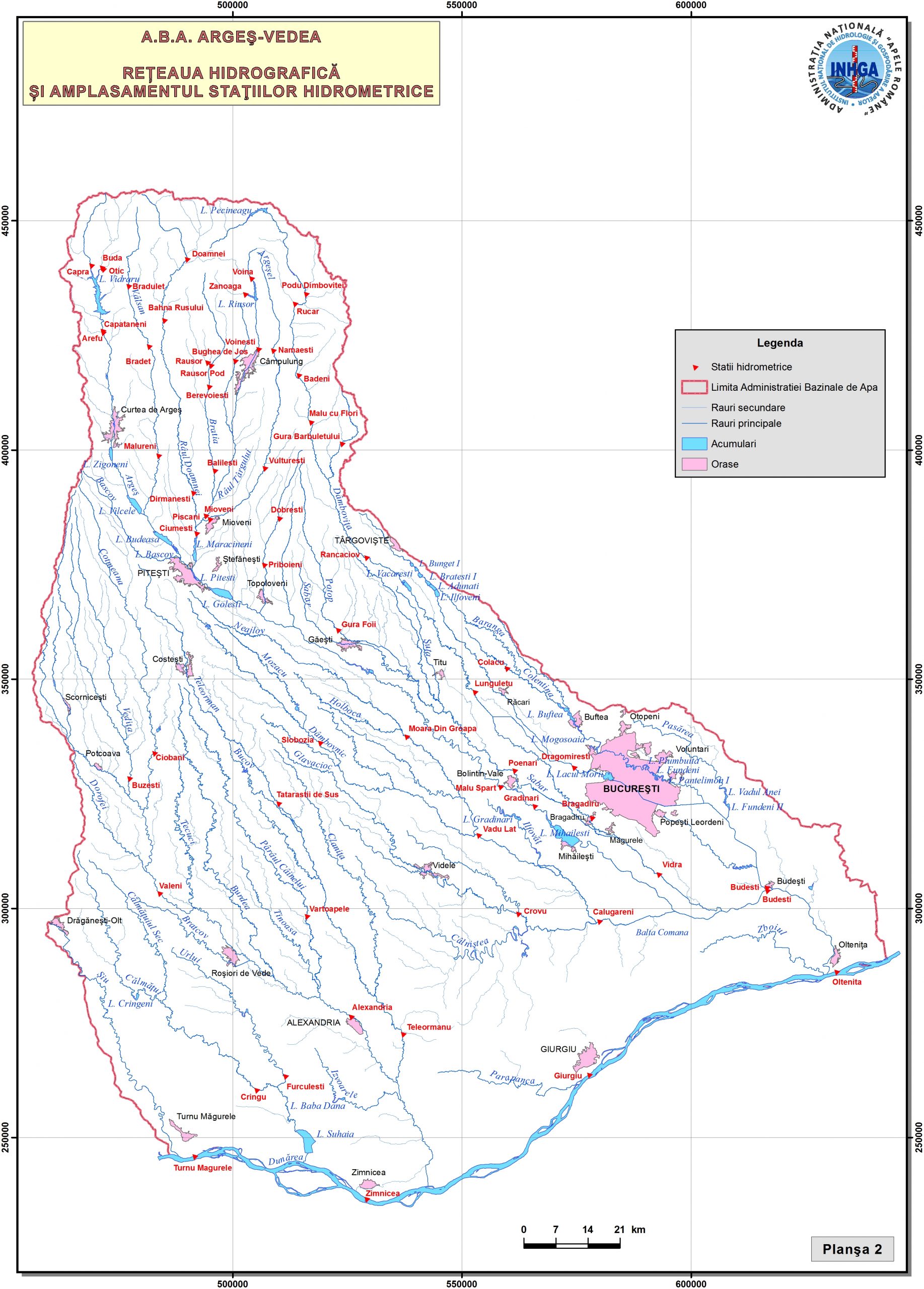
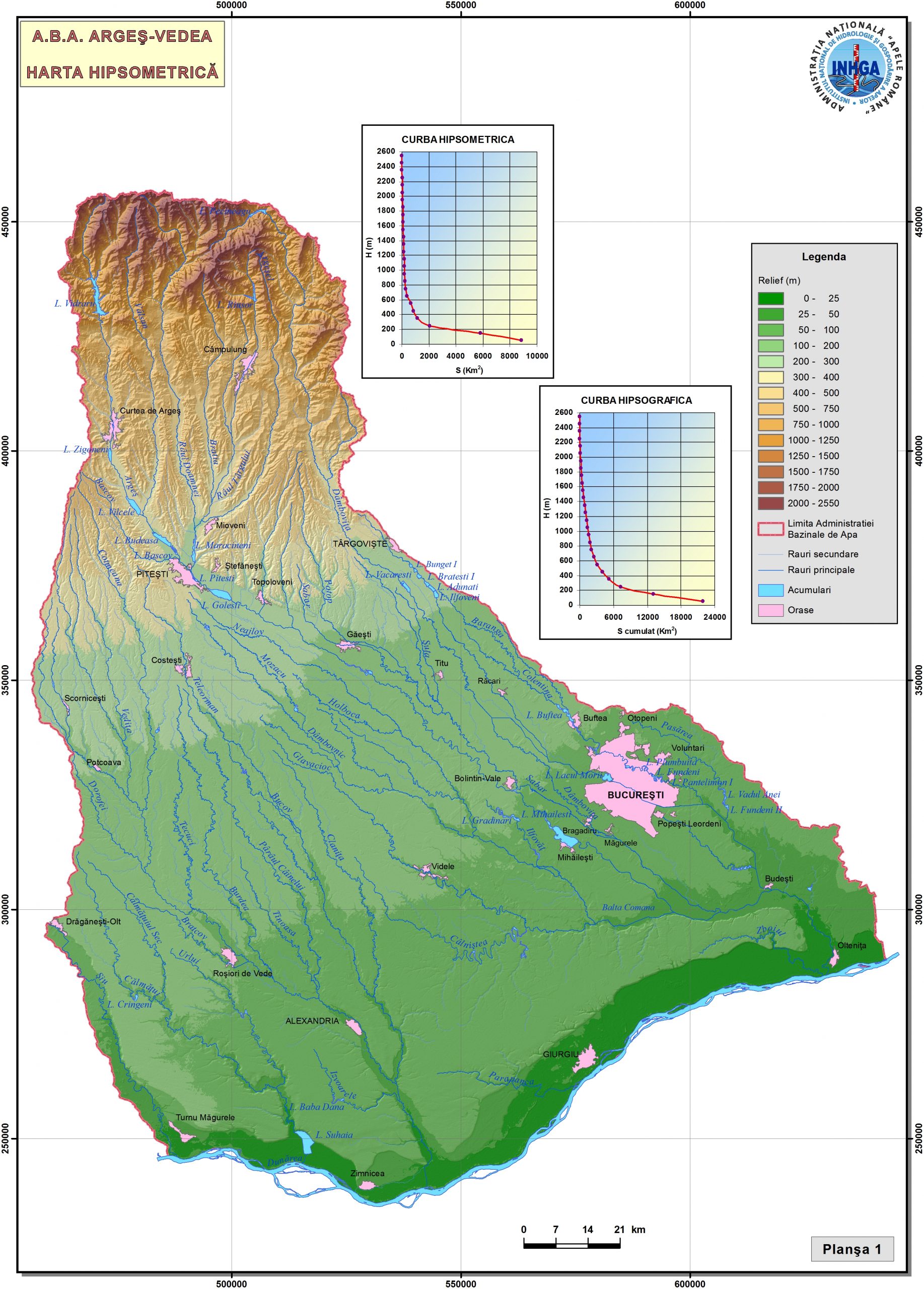
The Flood Risk Management Plans were approved by Government Decision nr. 972 of 21 December 2016 and published in the Official Gazette no. 106 of 7 February 2017
Flood risk management plans – cycle 2
H.G. PMRI – cycle 2:
- Synthesis-National-PMRI-Cycle-II-2
- PMRI_Ciclul-II_fl-Danube-2
- PMRI_Ciclul-II_ABA-Somes-Tisa-2
- PMRI_ciclul-II_ABA-Mures-2
- PMRI_Ciclul-II_ABA-Jiu-2
- PMRI_Ciclul-II_ABA-Dobrogea-Seaside-2
- PMRI_Ciclul-II_ABA-Buzau-Ialomita-2
- PMRI_Ciclul-II_-ABA-Siret-2
- PMRI_Ciclul-II_-ABA-Prut-Barlad
- PMRI_Ciclul-II_ABA-Olt-2
- PMRI_Ciclul-II_ABA-Banat-2
- PMRI_Ciclul-II_ABA-Crisuri-2
- PMRI_Ciclul-II_-ABA-Arges-See-2
PRM of the Danube basin
On 16 December 2015 the ICPDR (International Commission for the Protection of the Danube River) published in Vienna the first Flood Risk Management Plan for the Danube Basin.
This, together with the Danube River Basin Management Plan, sets priorities for the Danube basin until 2021.
The Flood Risk Management Plan is a milestone in ICPDR's work towards sustainable flood risk management. It addresses all aspects of flood risk management focusing on prevention, protection and preparedness, including measures to achieve the objectives set, and calling for solidarity among all ICPDR contracting parties.
This management plan has been developed with the involvement of stakeholders and the public. For the next six years, the ICPDR's work will be geared towards its implementation and the measures contained therein.
EPRI
CYCLE I reporting
Historically significant floods
The selection of historically significant floods has been carried out by applying country-specific criteria, with the directive giving freedom to each Member State in defining the term significant historical flood.
The criteria underlying the identification of historical floods in Romania were the hydrological ones and the criteria regarding the negative effects of the flood on the four categories of consequences established within the directive: human health, environment, cultural heritage and economic activity.
The information provided to the European Commission consisted of:
- 01-Historical-significant-floods-hydrographic-basins-ABA-Banat
- 02-Flood-historical-significant-watershed-ABA-Jiu
- 03-Floods-historical-significant-hydrographic-basins-ABA-Olt
- 04-Floods-historical-significant-hydrographic-basins-ABA-Arges-Vedea
- 05-Historical-significant-floods-hydrographic-basins-ABA-Buzau-Ialomita
- 06-Historical-significant-floods-hydrographic-basins-ABA-Dobrogea-Seaside
- 07-Historical-significant-floods-hydrographic-basins-ABA-Mures
- 08-Historical-significant-floods-hydrographic-basins-ABA-Crisuri
- 09-Historical-significant-floods-hydrographic-basins-ABA-Somes-Tisa
- 1000-Historical-significant-floods-watersheds-Danube-Basin
- 11-Floods-historical-significant-river basins-ABA-Siret
- 12-Floods-historical-significant-hydrographic-basins-ABA-Prut
Areas of potentially significant flood risk
The areas with potentially significant flood risk were defined after consulting the information currently available within the projects Plan for prevention and protection against floods, dangerous meteorological phenomena, accidents at hydrotechnical constructions and accidental pollution and , respectively, the results obtained within the PHARE 2005/017-690.01.01 Contributions to the development of flood risk management strategy (beneficiary – M.M.P. and A.N. Apele Române). At the same time, the areas protected against floods with hydrotechnical works were taken into account, considering all floods that occurred in the past and had a significant negative impact, without removing from that list those floods that can occur on sectors that have been hydrotechnically arranged (impounded).
The information provided to the European Commission consisted of:
1000-Areas-with-potentially-significant-risk-to-floods-Danube Basin
01-Areas-with-potential-significant-risk-to-flood-ABA-Banat
02-Areas-with-potentially-significant-risk-to-flood-ABA-Jiu
03-Areas-with-potential-significant-risk-to-flood-ABA-Olt
04-Areas-with-potential-significant-risk-to-flood-ABA-Arges-Vedea
05-Areas-with-potentially-significant-risk-to-flood-ABA-Buzau-Ialomita
06-Areas-with-potential-significant-risk-to-flood-ABA-Dobrogea-Seaside
07-Areas-with-potential-significant-risk-to-flood-ABA-Mures
08-Areas-with-potentially-significant-risk-to-flood-ABA-Crisuri
09-Areas-with-potential-significant-risk-to-flood-ABA-Somes-Tisa
11-Areas-with-potentially-significant-risk-to-flood-ABA-Siret
12-Areas-with-potential-significant-risk-to-flood-ABA-Prut-Barlad
EPRI reports
- PFRA-Dunare_2
- RO11_-PFRA_Report_-20130531
- RO10_-PFRA_Report_-20130531
- RO9_ABA_Somes_Tisa_PFRA_Report
- RO8_ABA_Crisuri_PFRA_Report
- RO7_ABA_Mures_PFRA_Report_compressed
- RO6_-PFRA_Report_-20130531-Good
- RO5_-PFRA_Report_-20130531
- RO4_-PFRA_Report_-20130531
- RO3_-PFRA_Report_-20130531
- RO2_-PFRA_Report_-20130531
- RO1_ABA_Banat_PFRA_Report
CYCLE II reporting
- PFRA_Report_RO1000_2019-08-30
- PFRA_Report_RO6_2019-08-30
- PFRA_Report_RO11_2019-08-30
- PFRA_Report_RO10_2019-08-30
- PFRA_Report_RO5_2019-08-30
- PFRA_Report_RO4_2019-08-30
- PFRA_Report_RO3_2019-08-30
- PFRA_Report_RO2_2019-08-30
- PFRA_Report_RO1_2019-08-30
- PFRA_Report_RO7_2019-08-30
- PFRA_Report_RO8_2019-08-30
- PFRA_Report_RO9_2019-08-30



